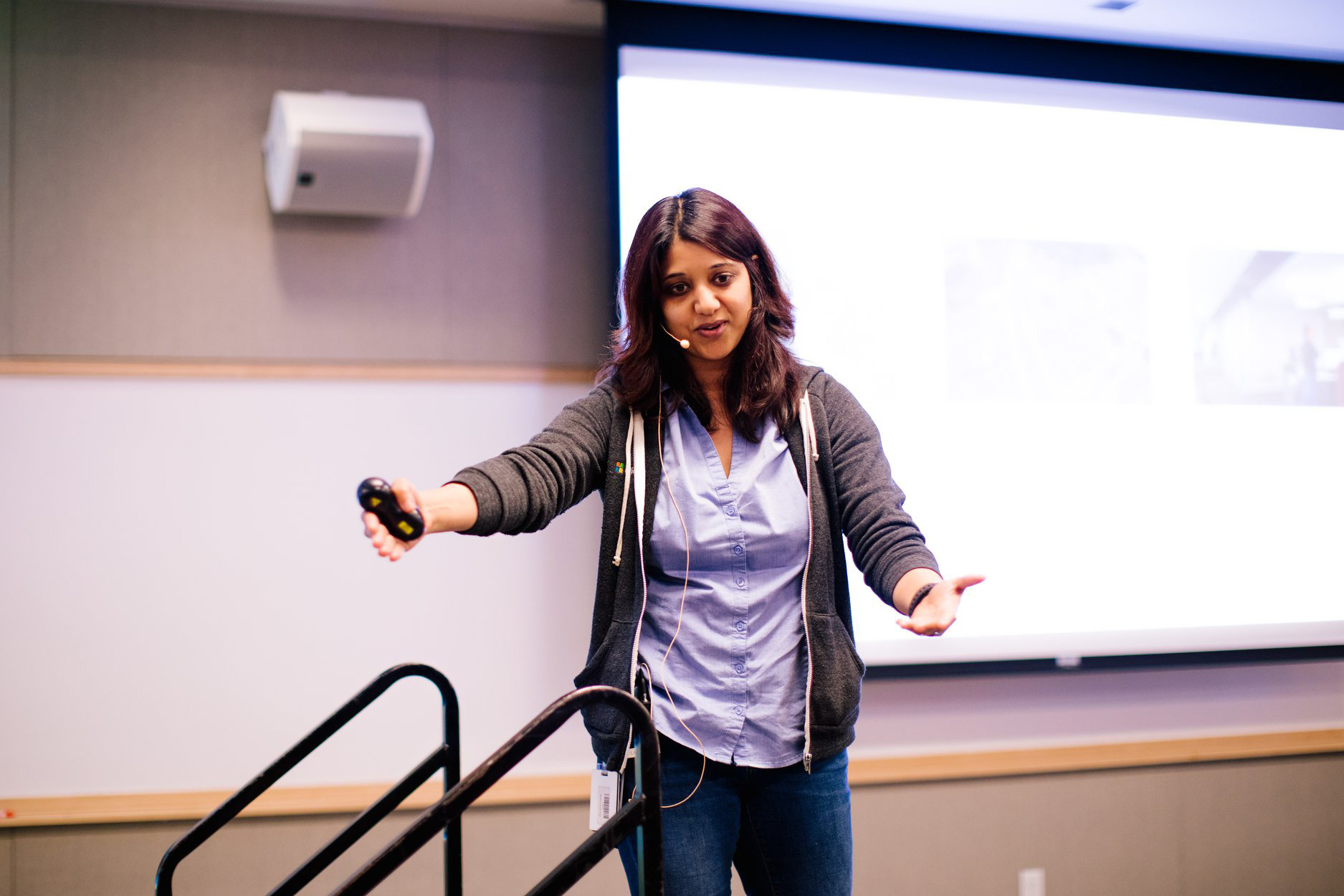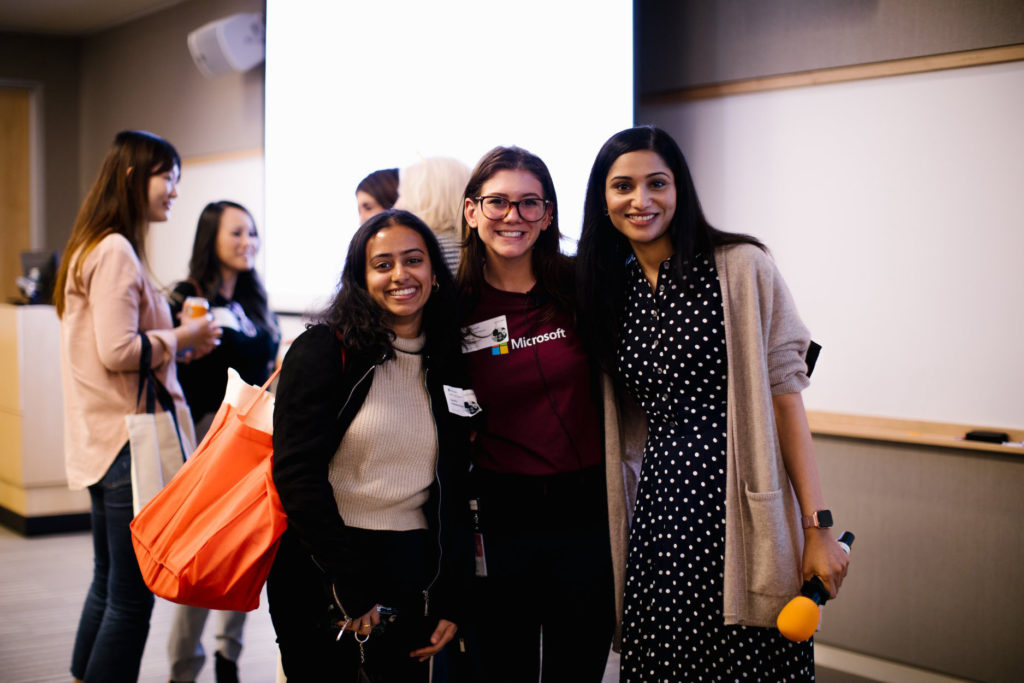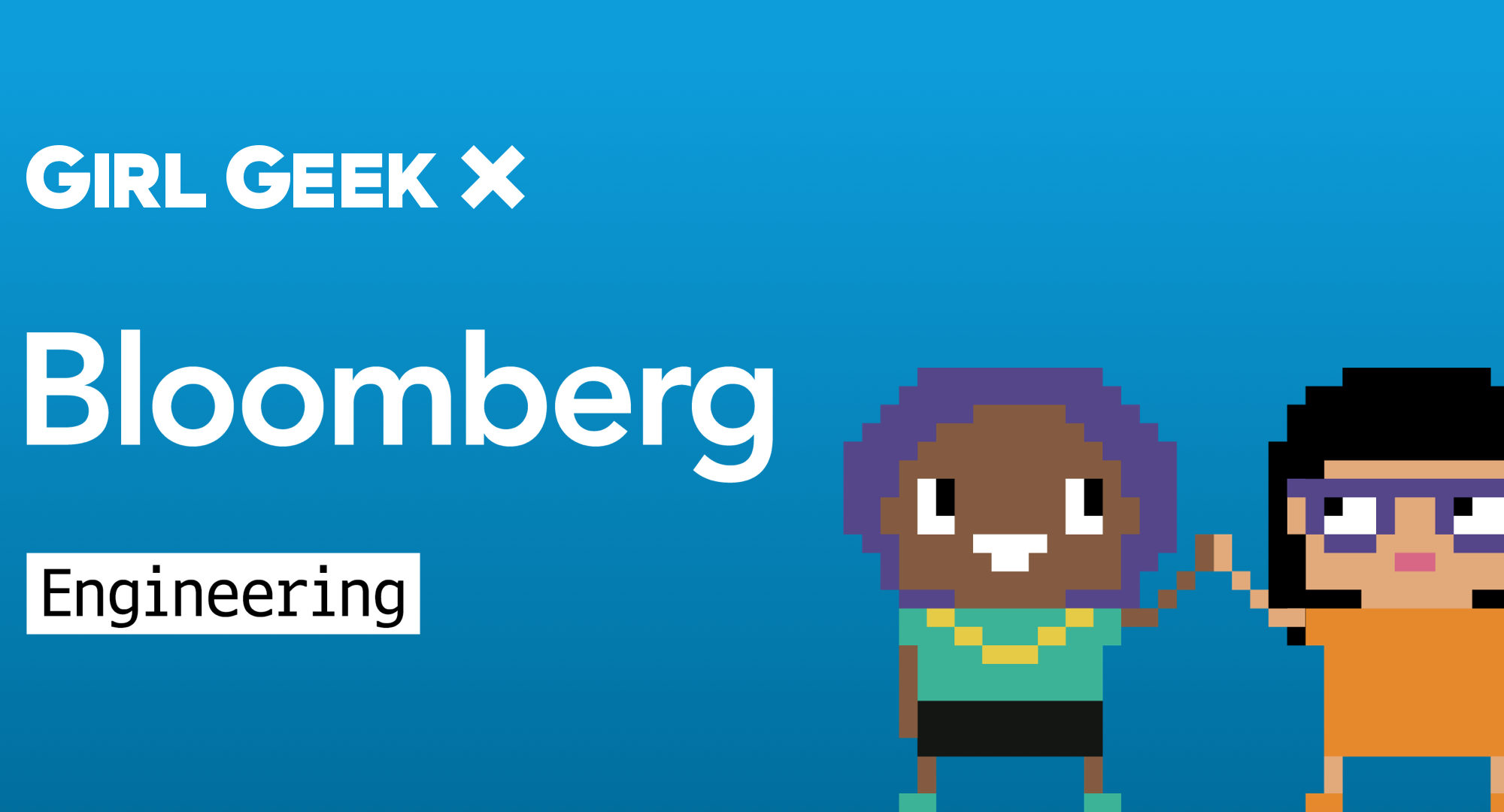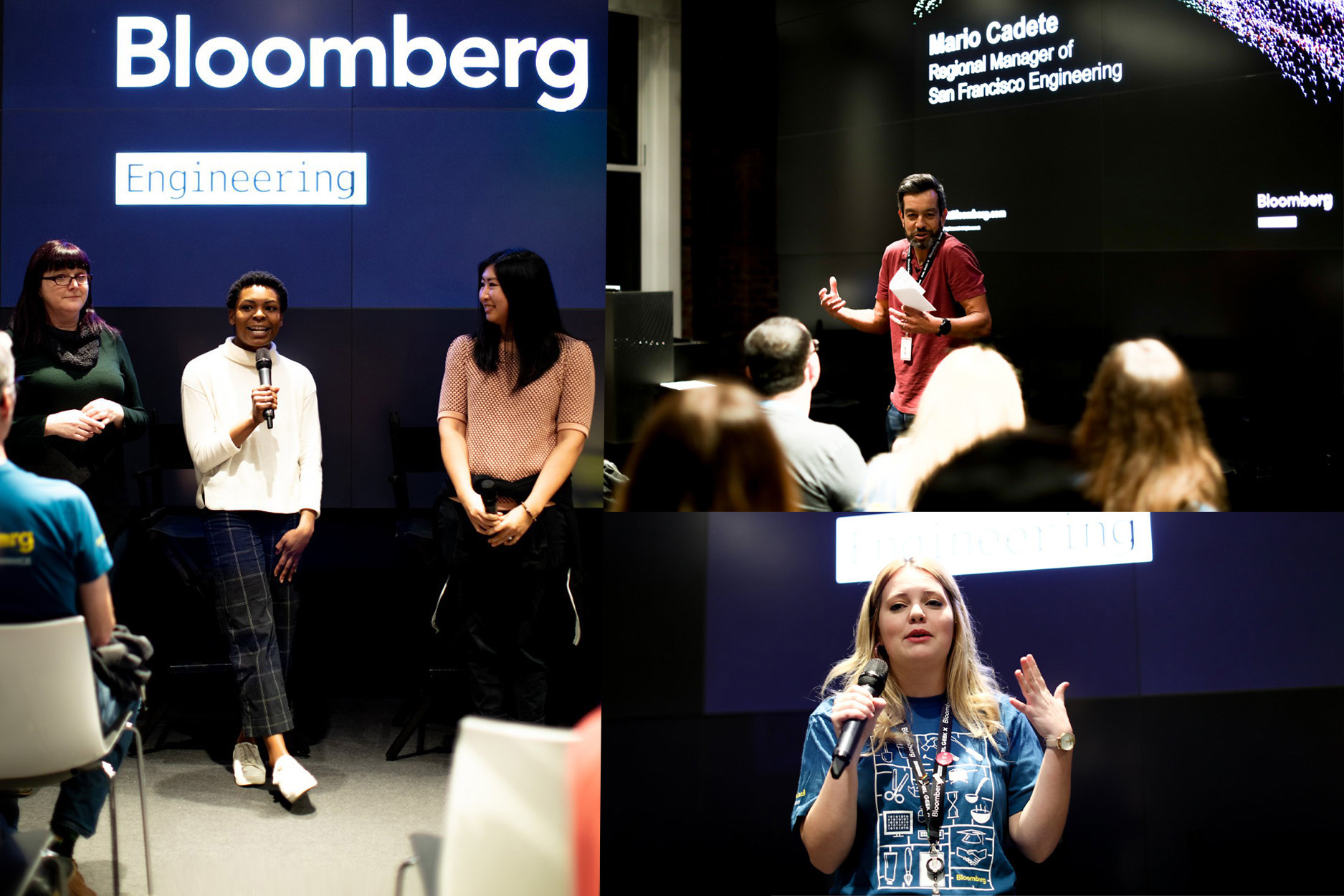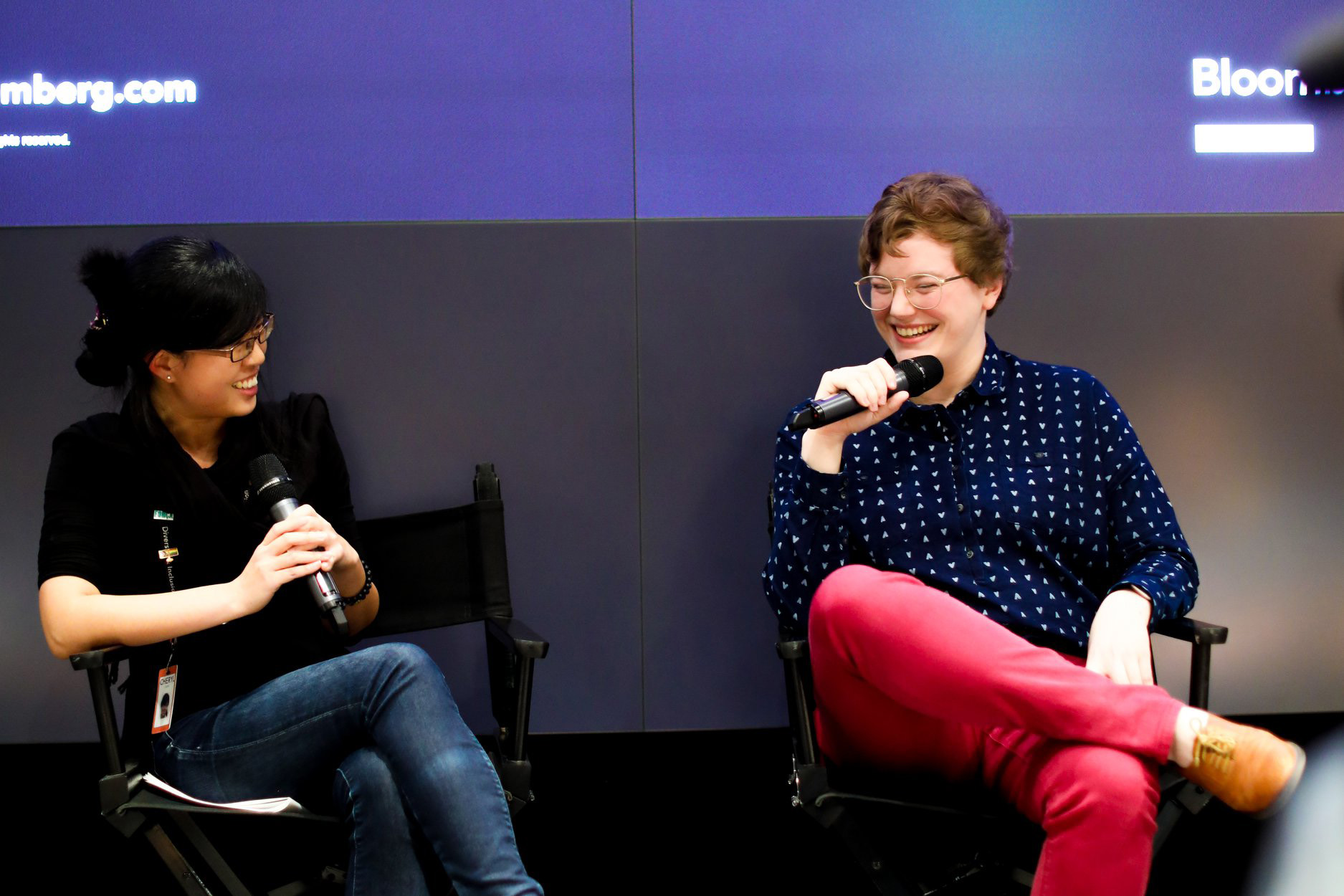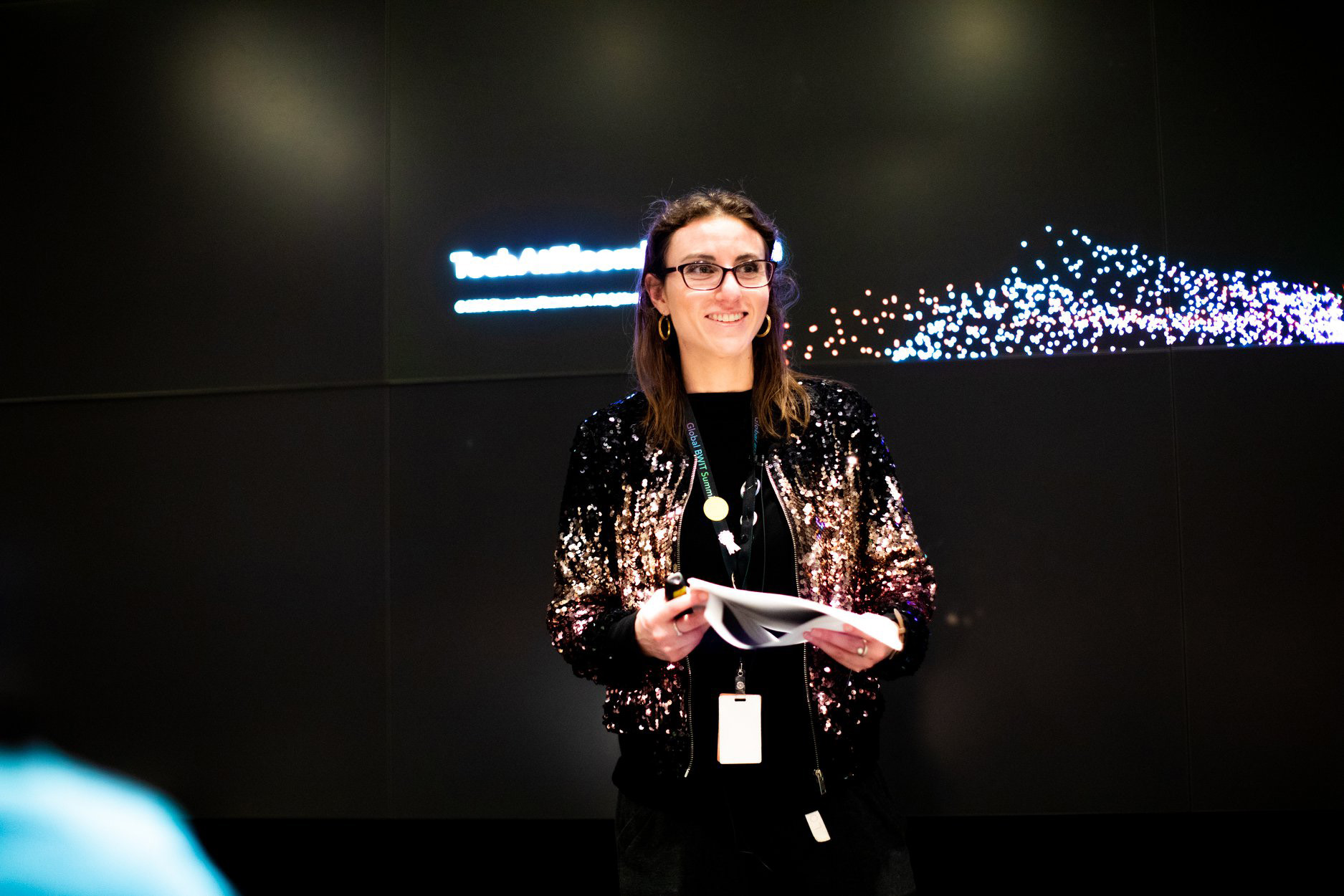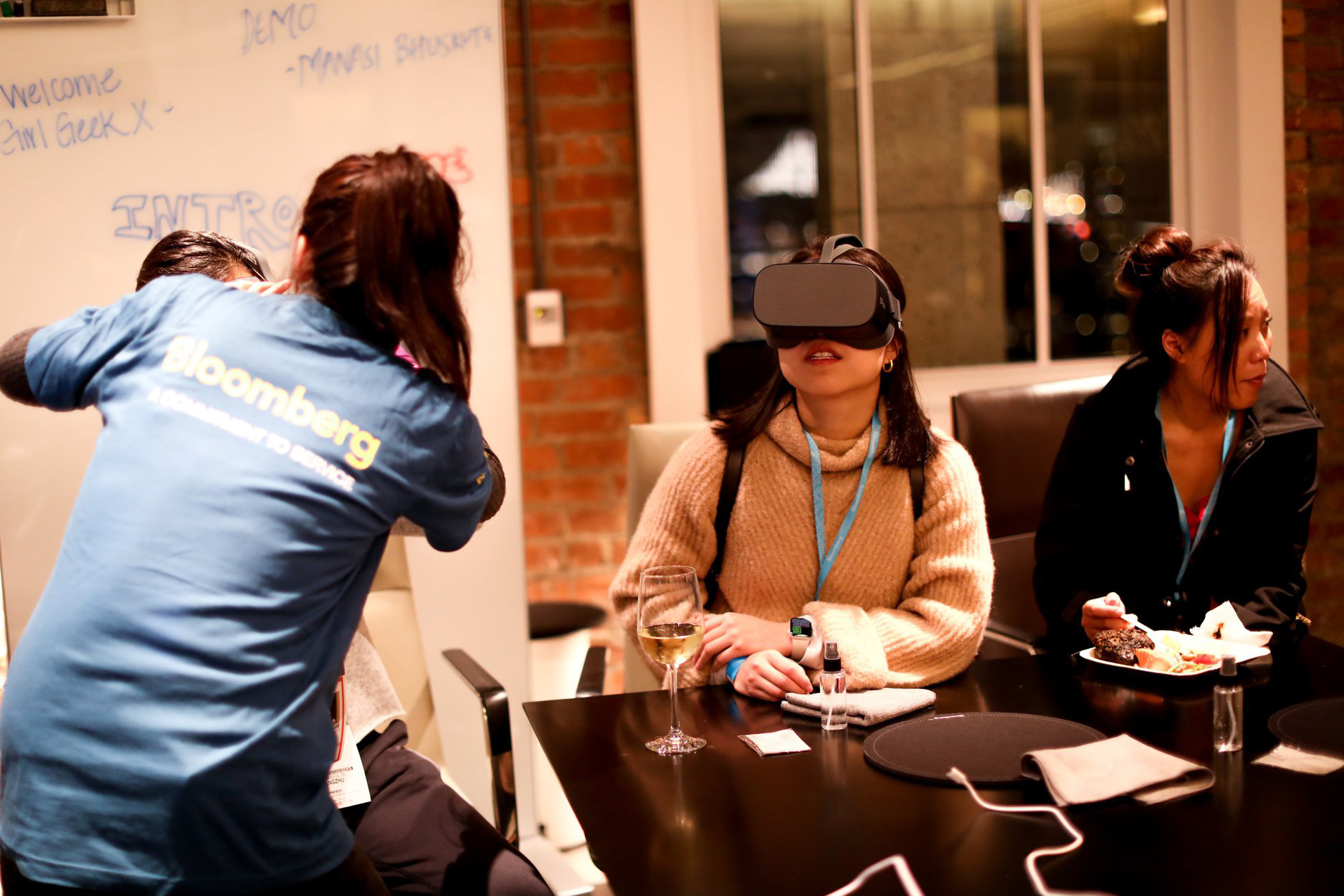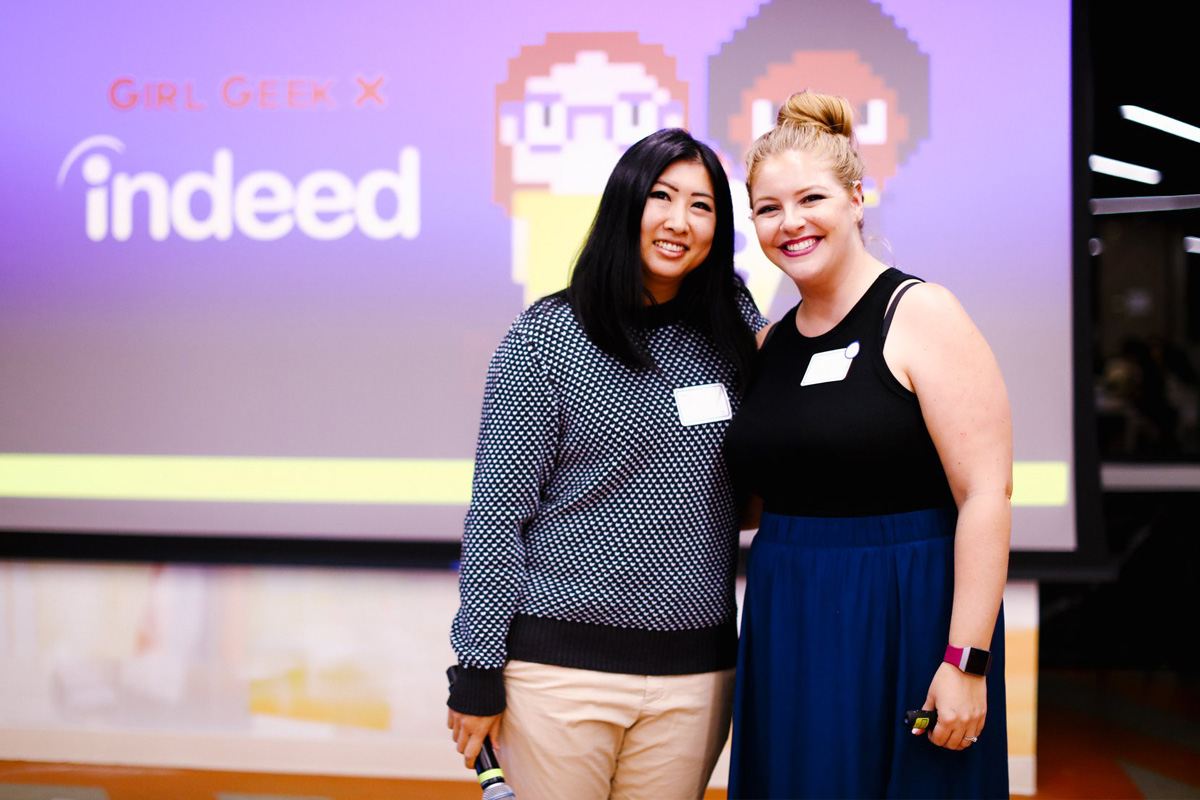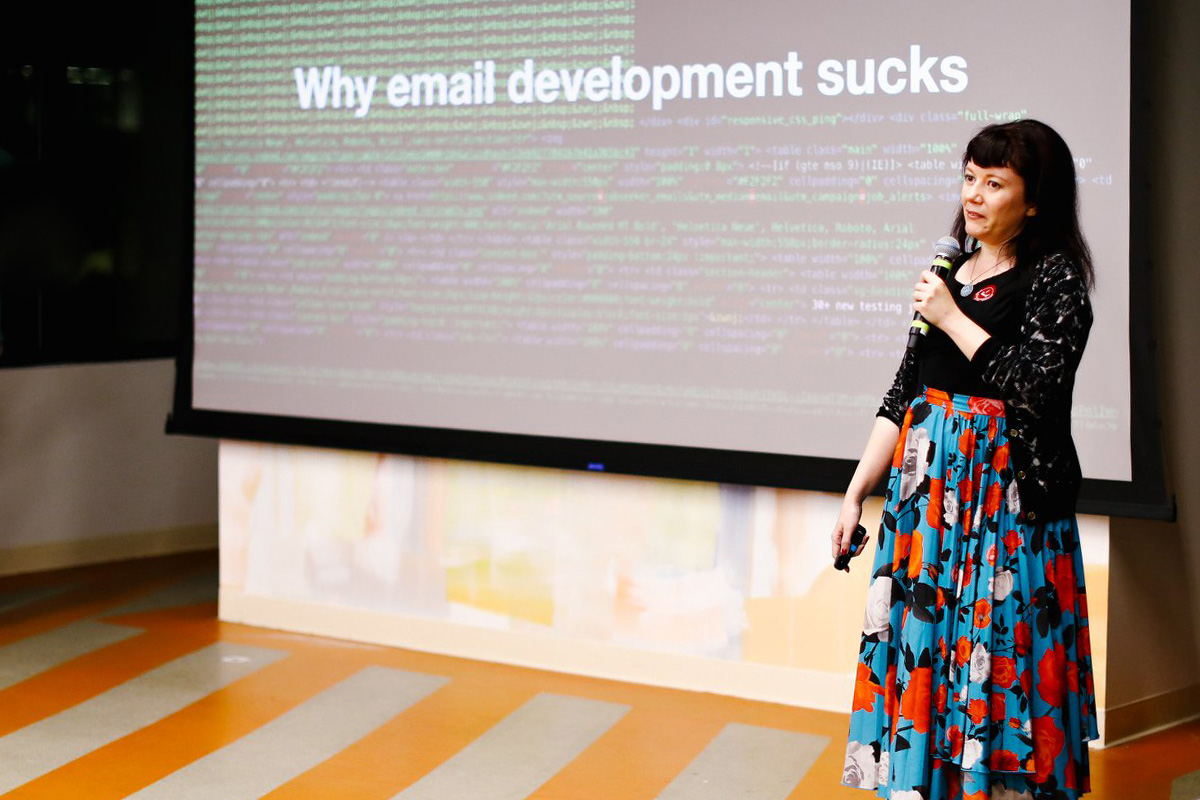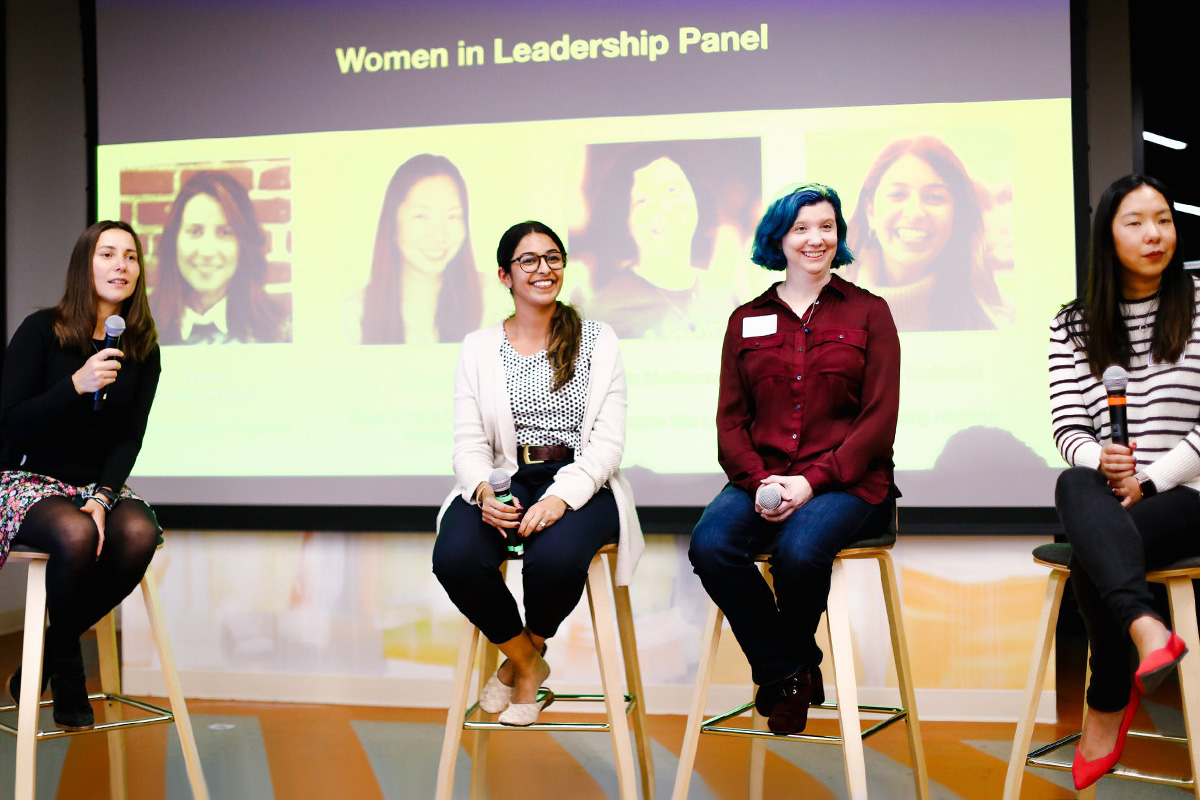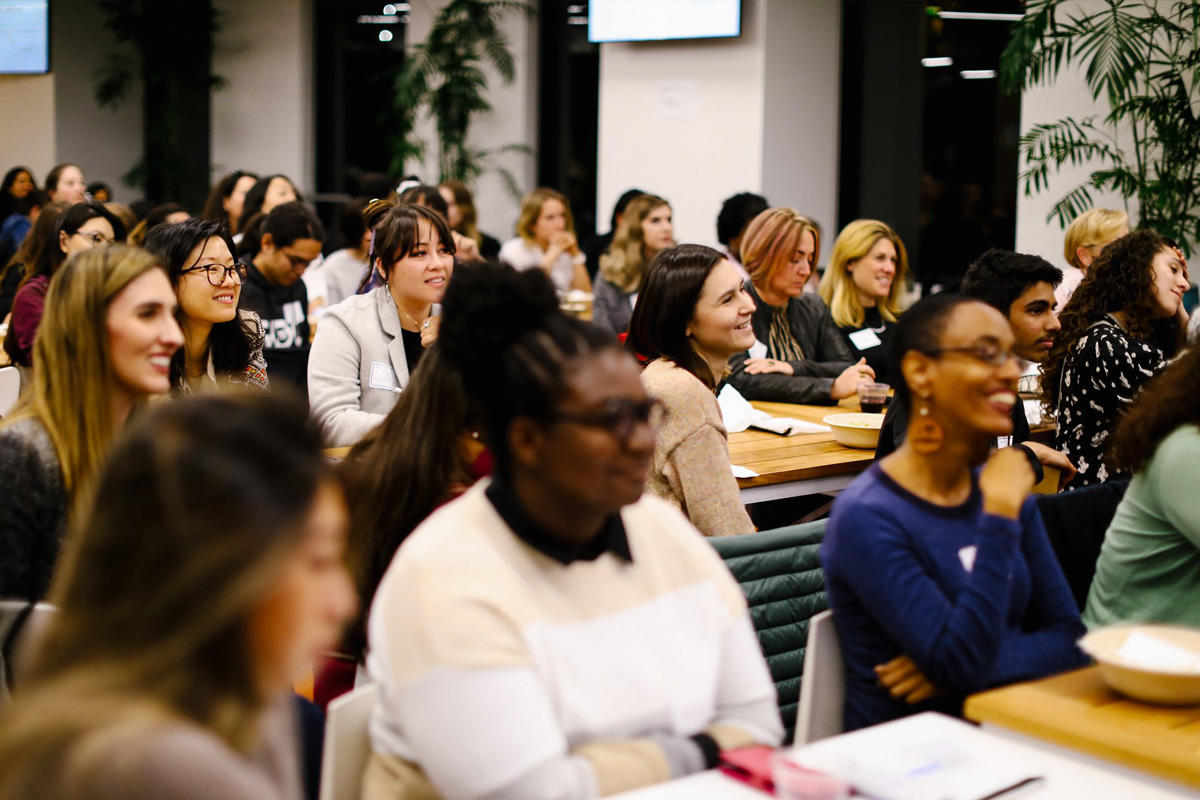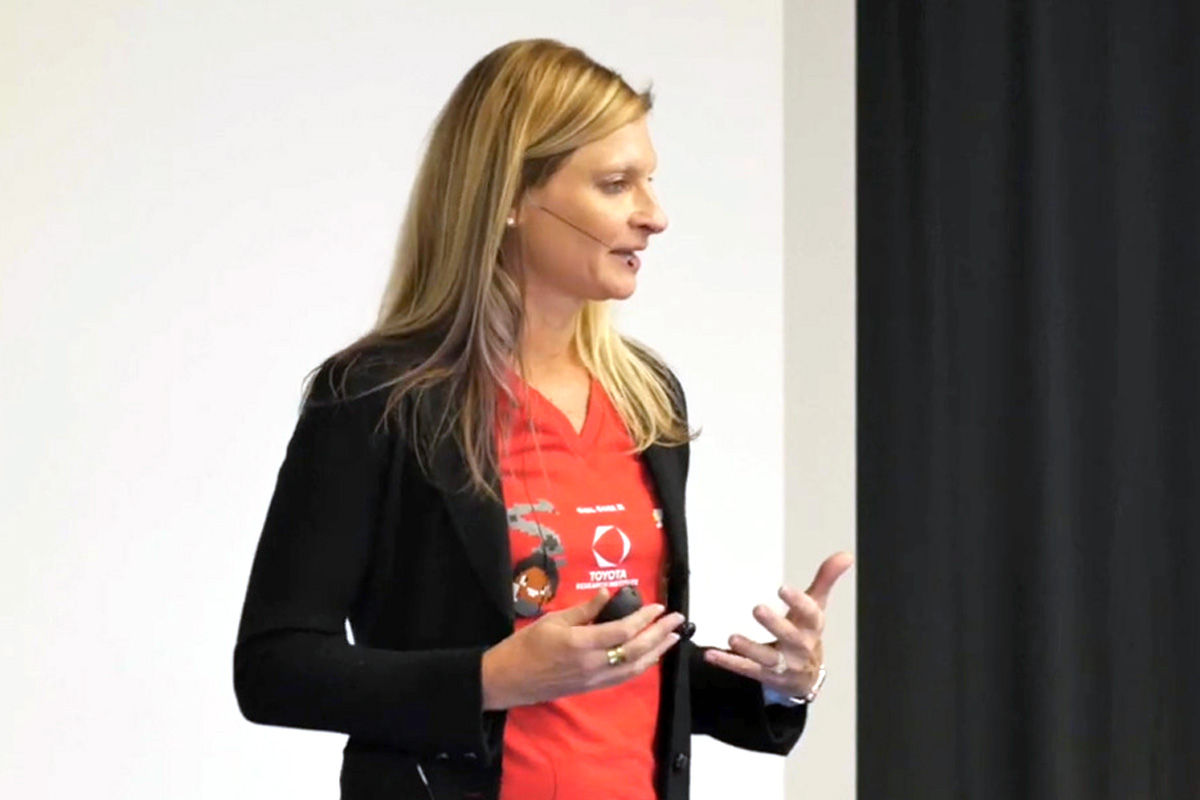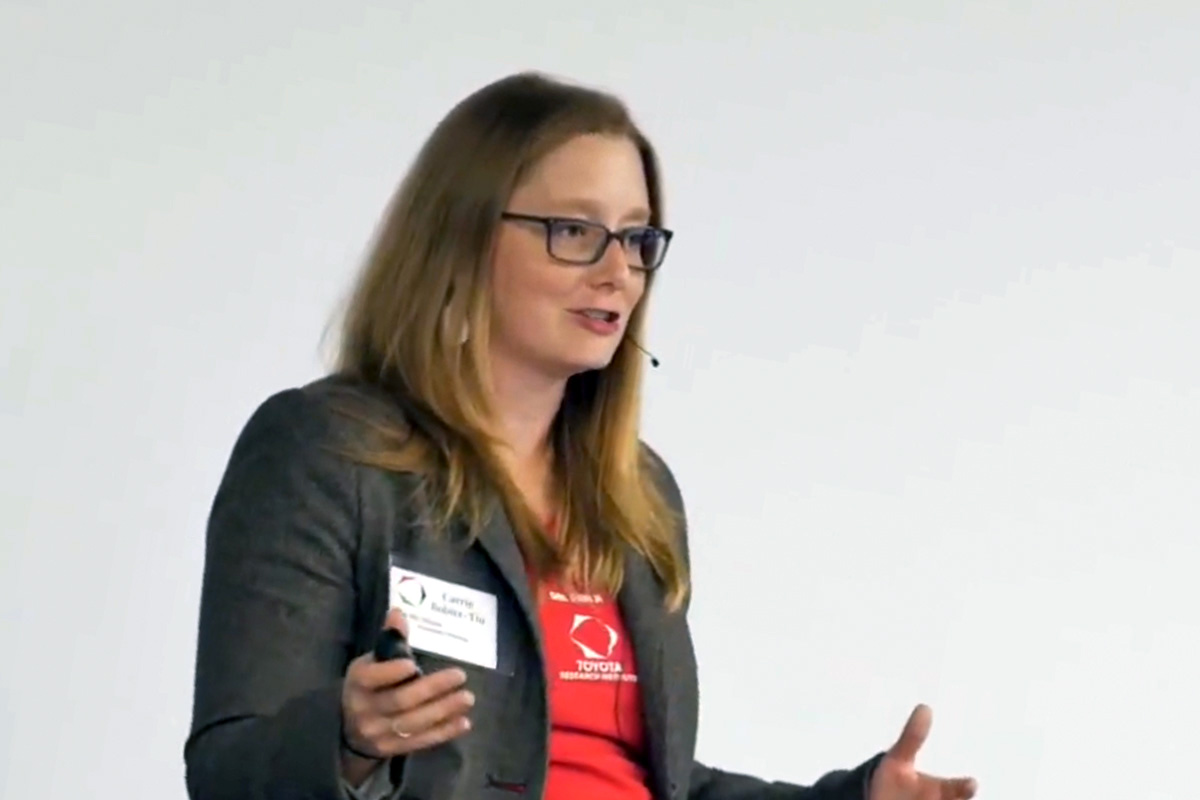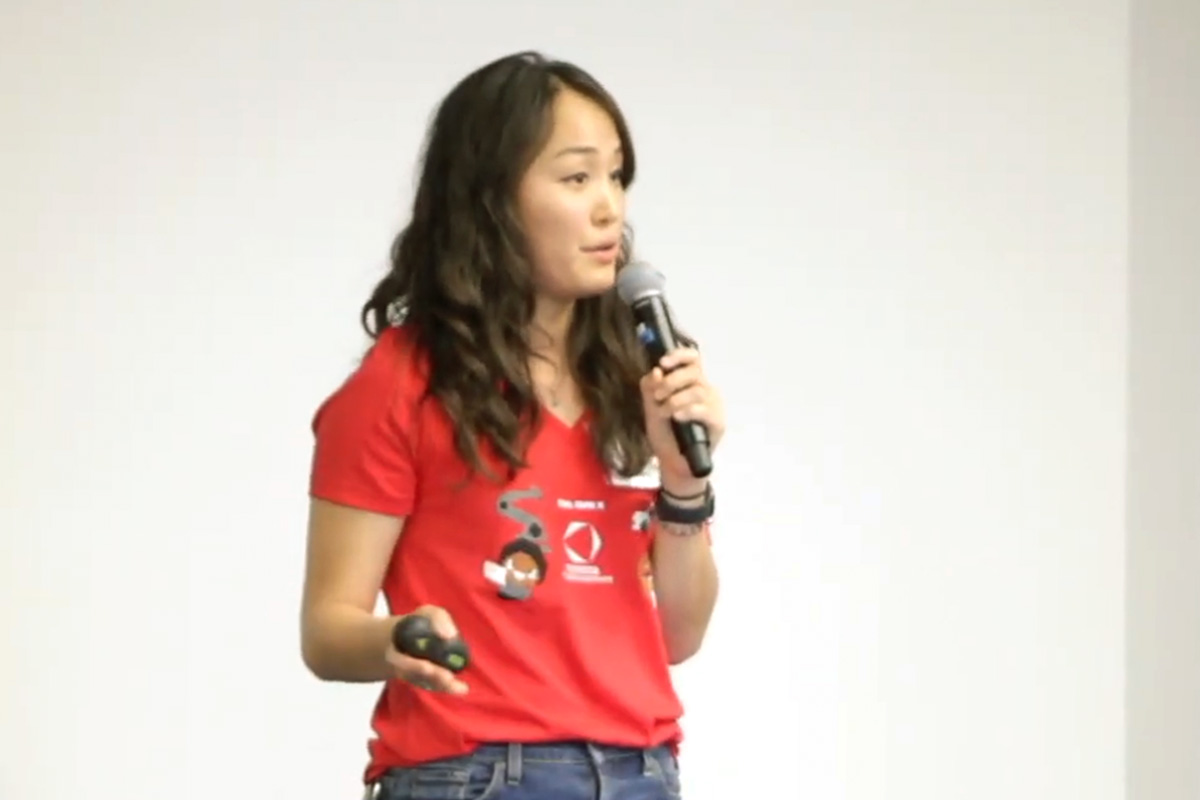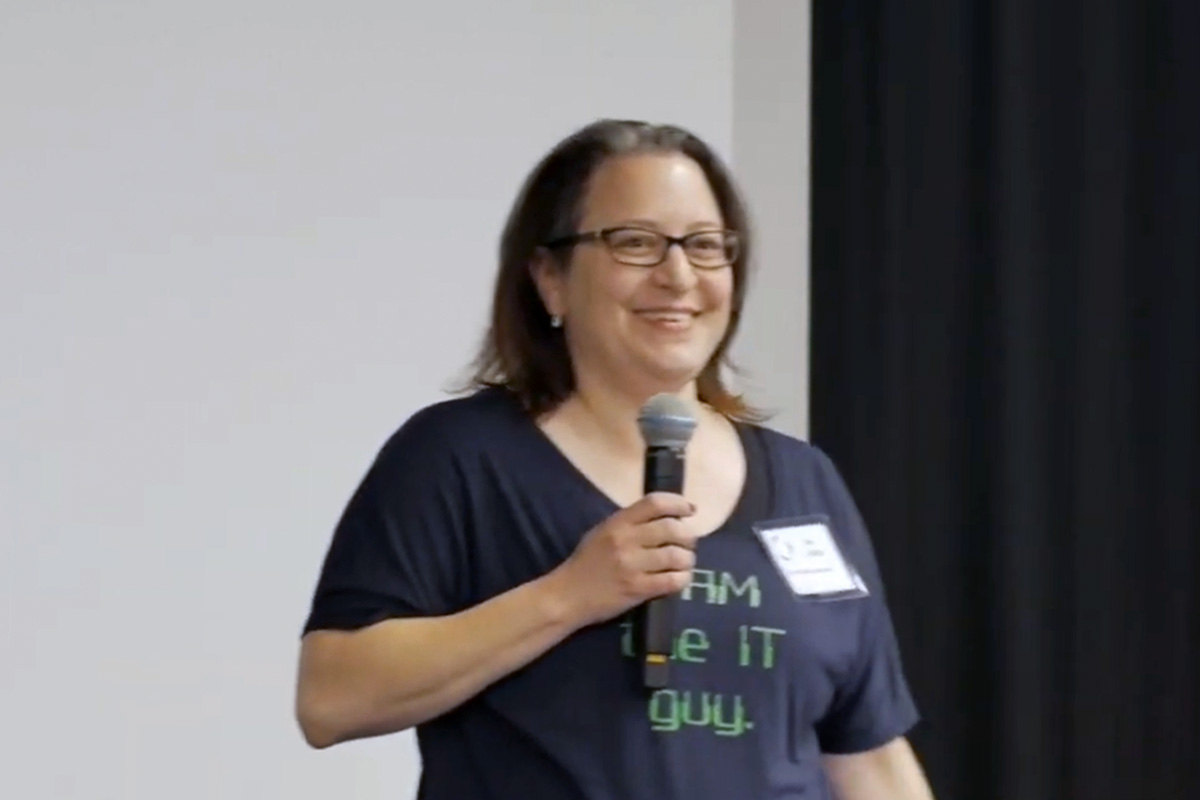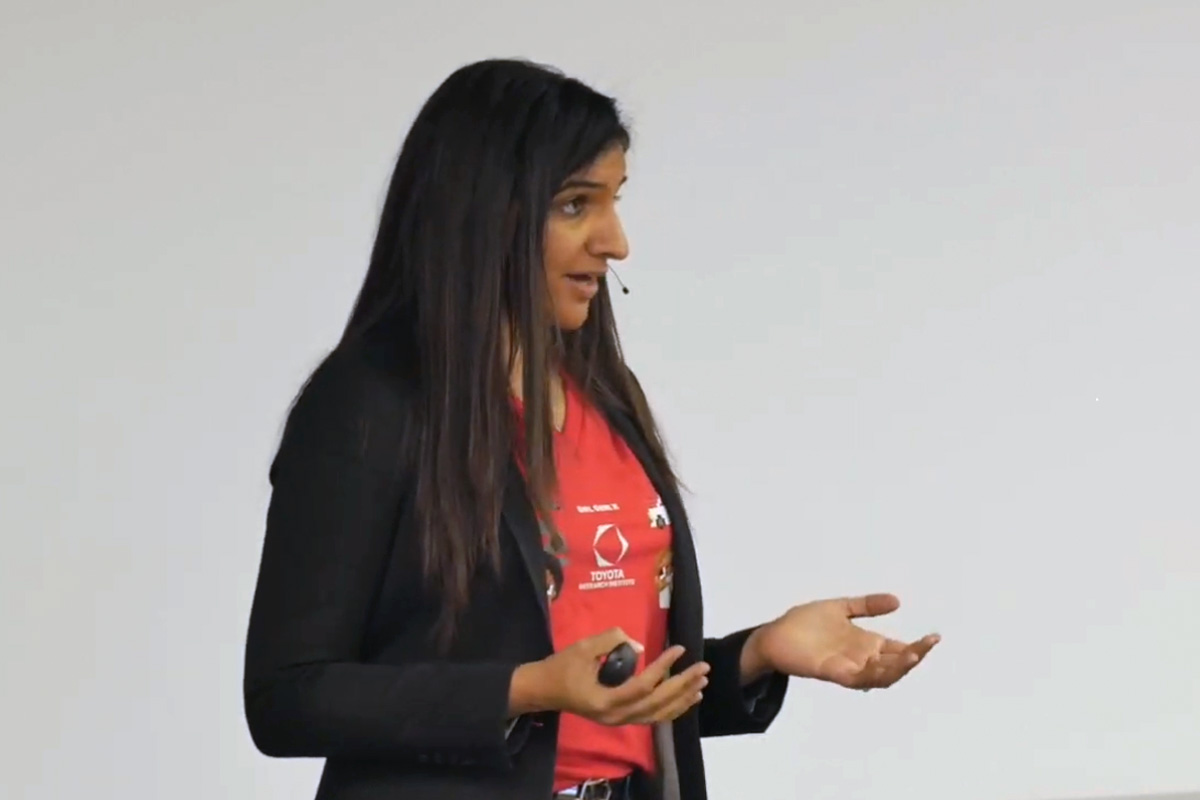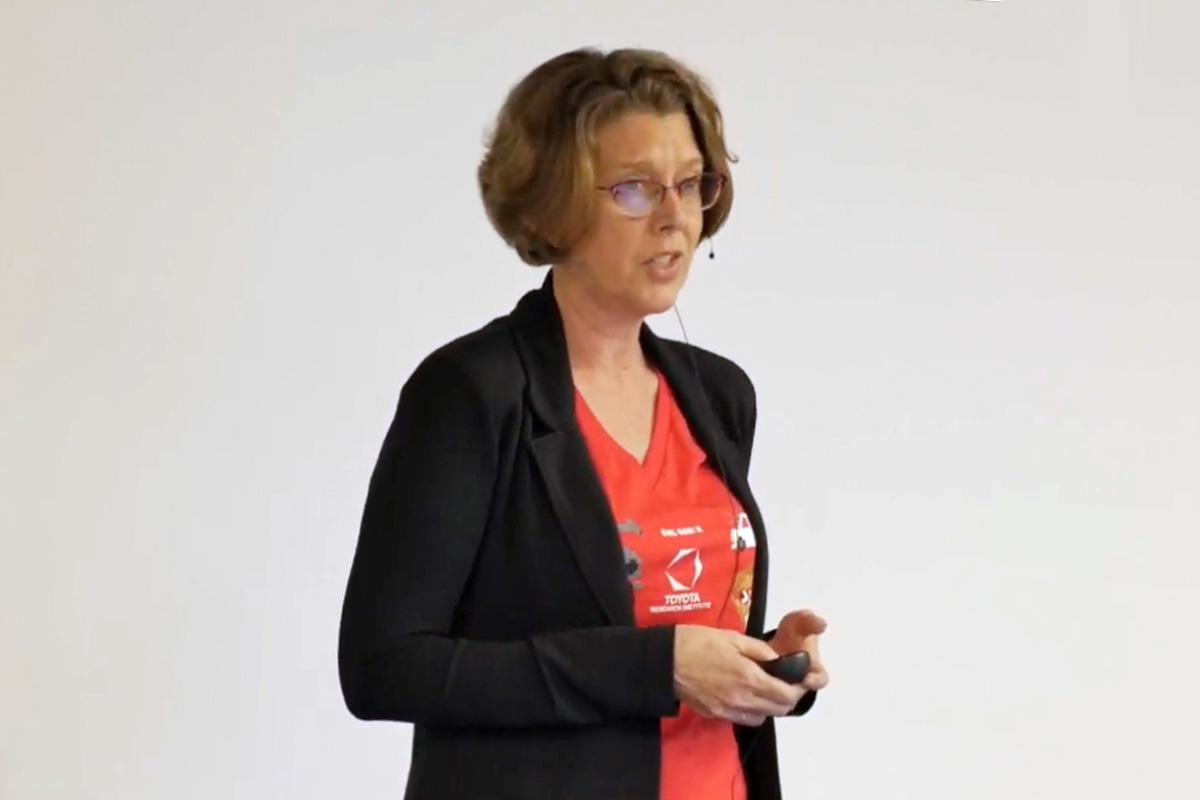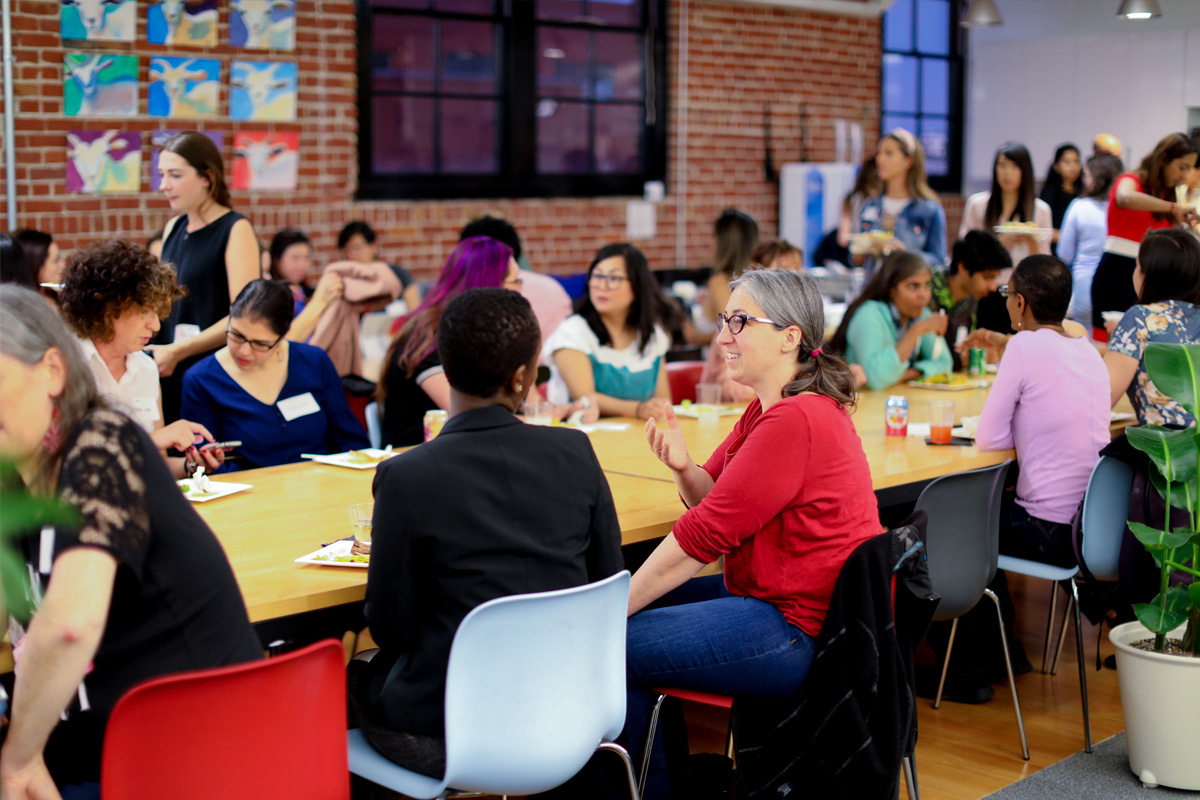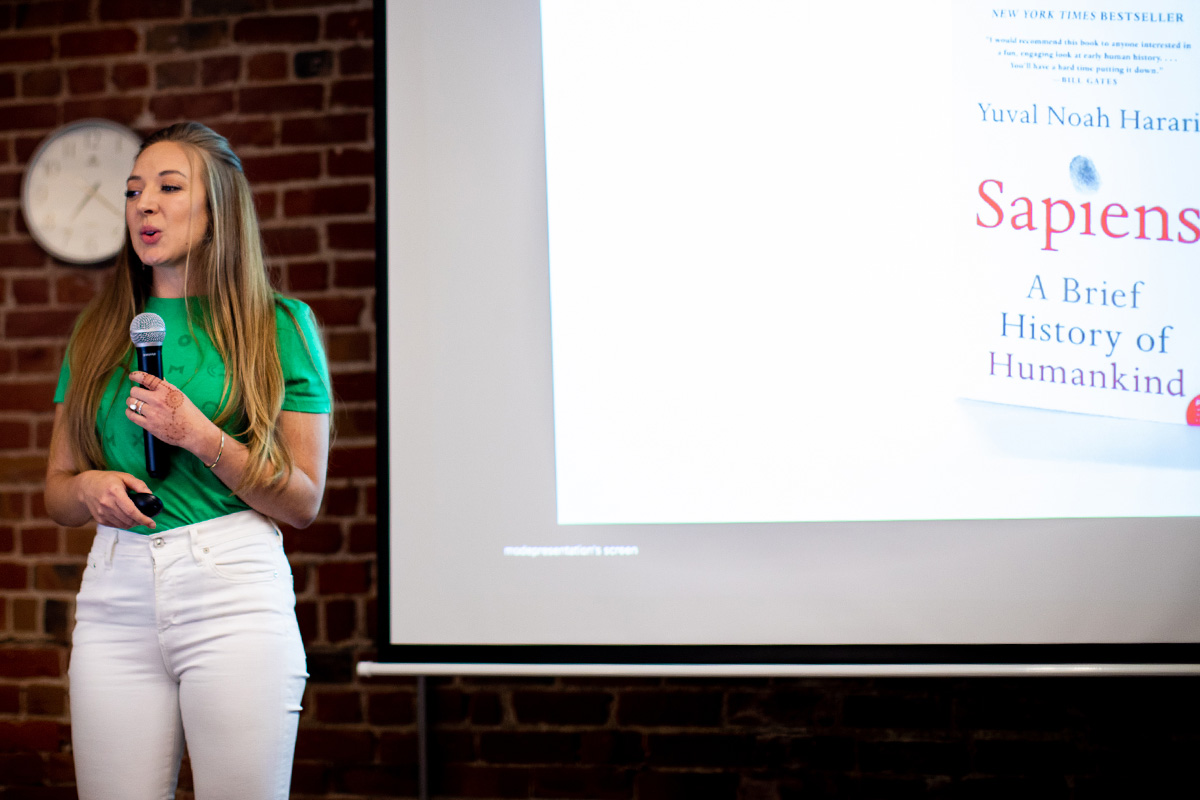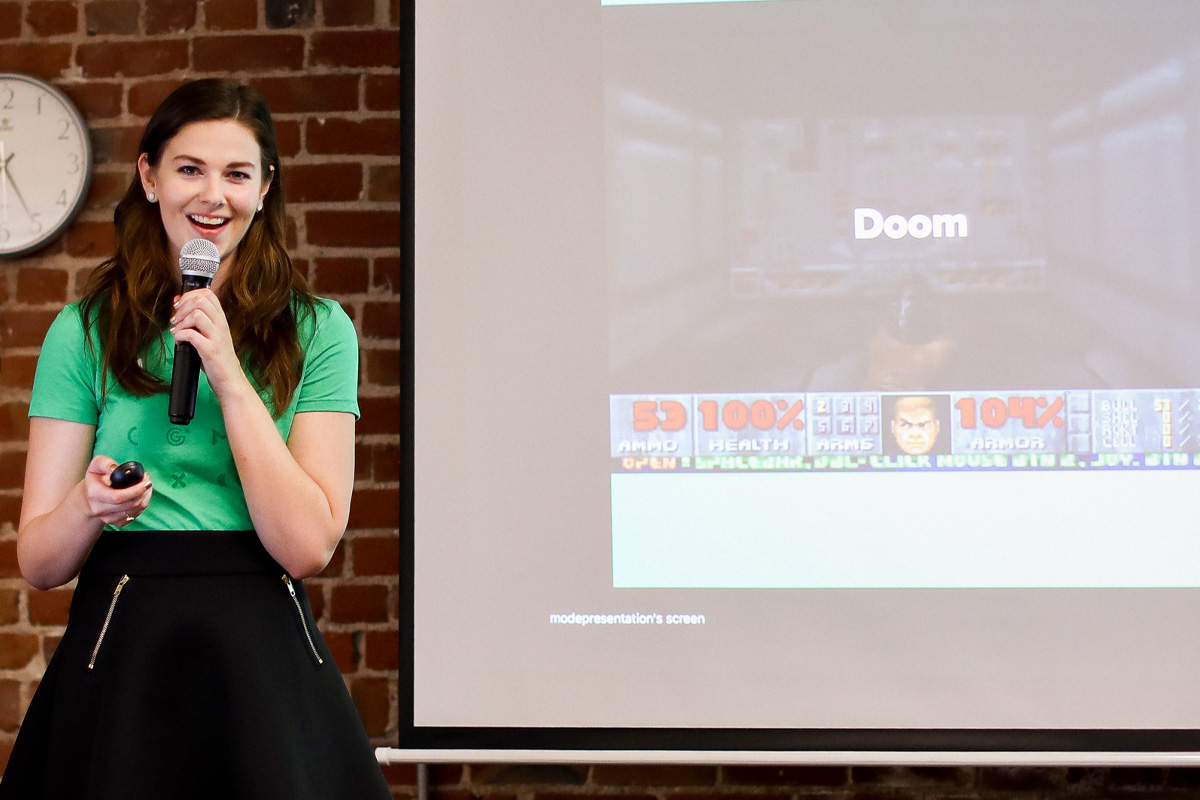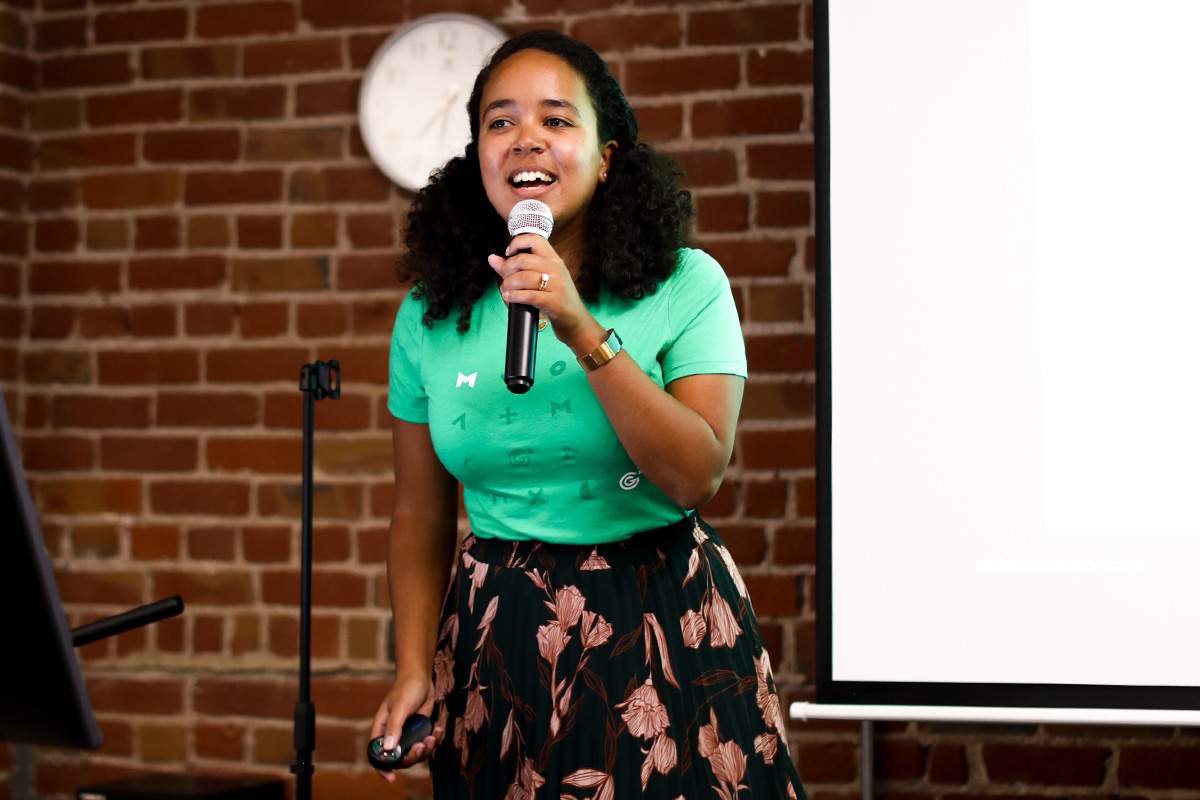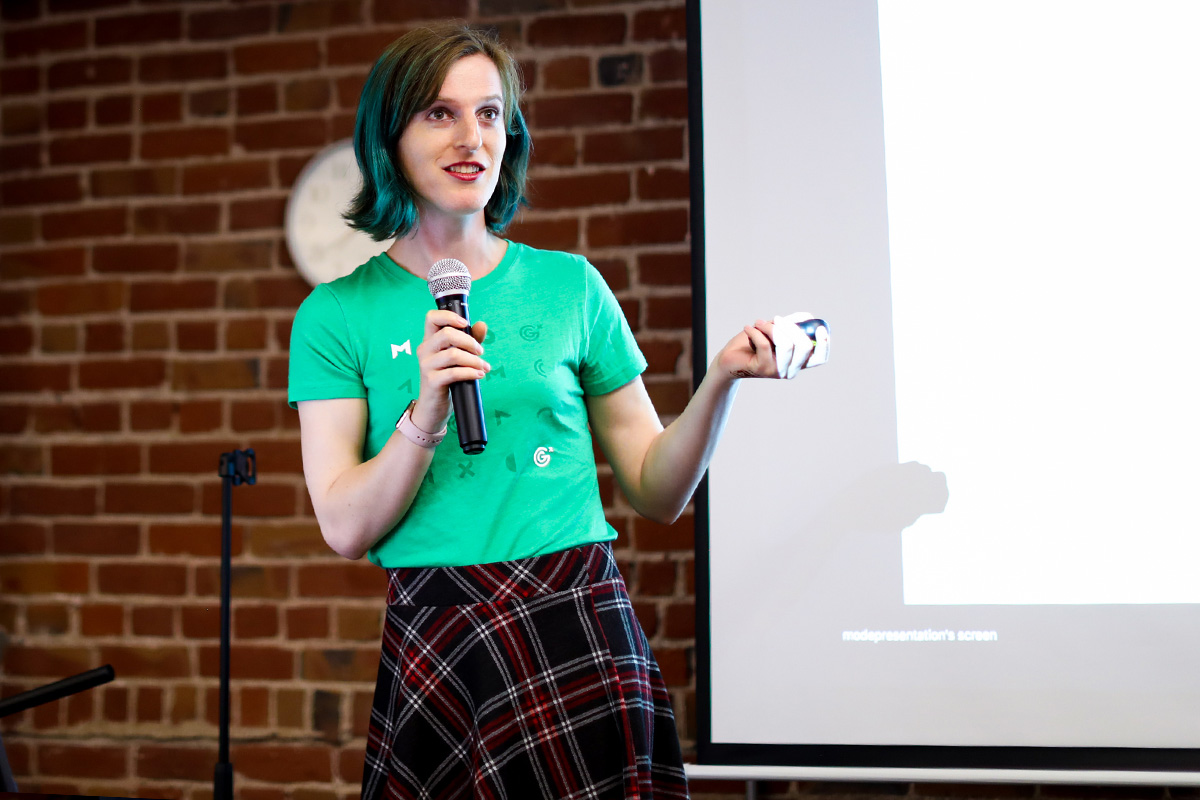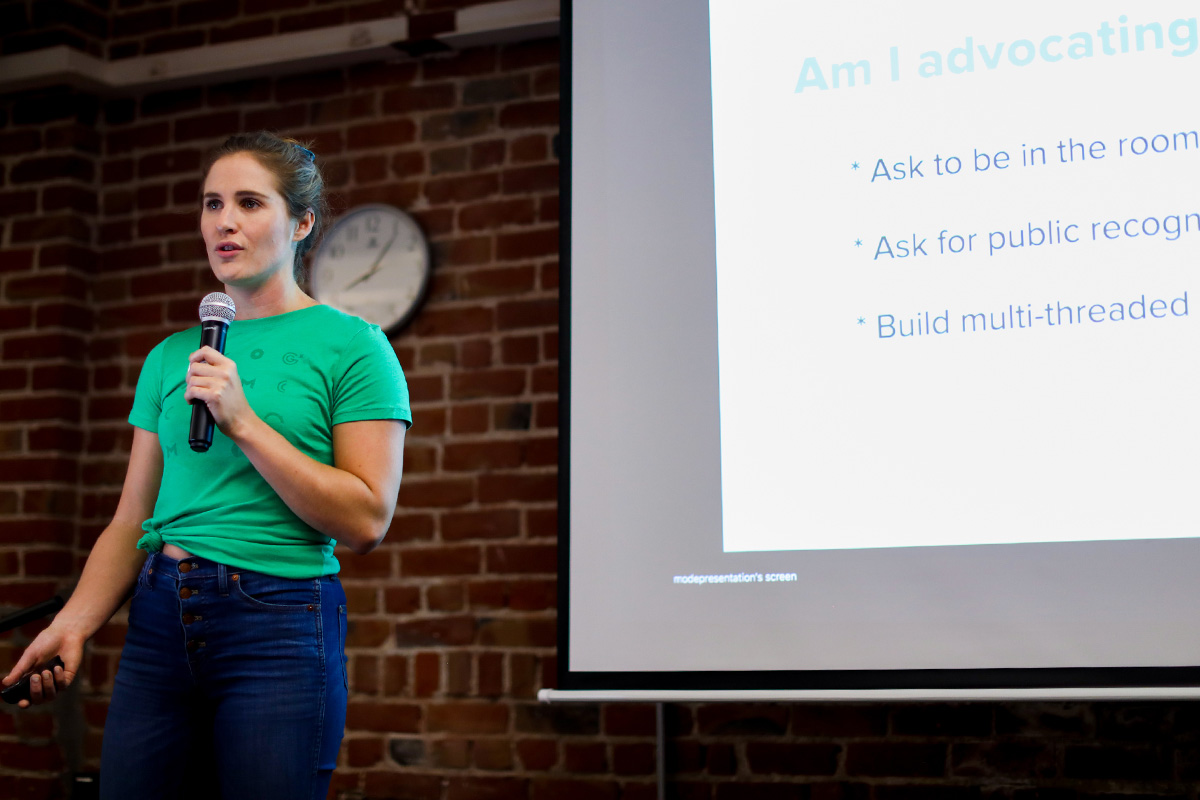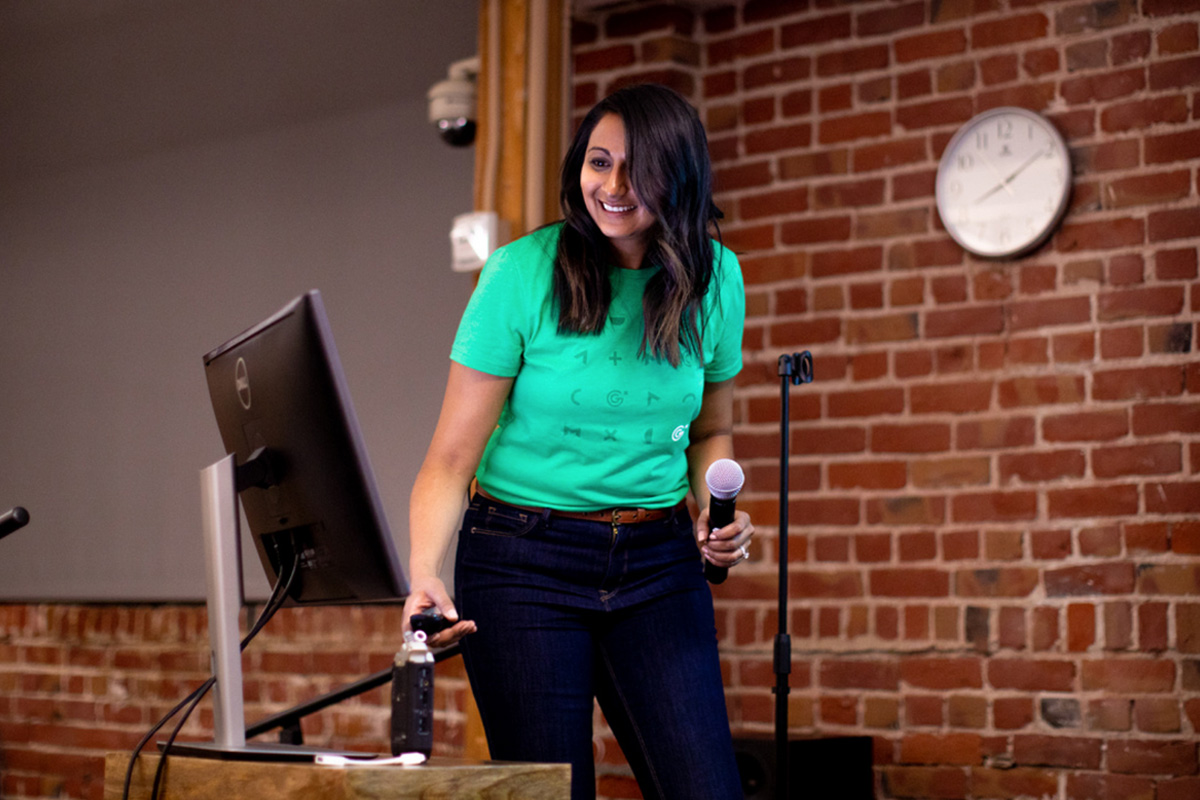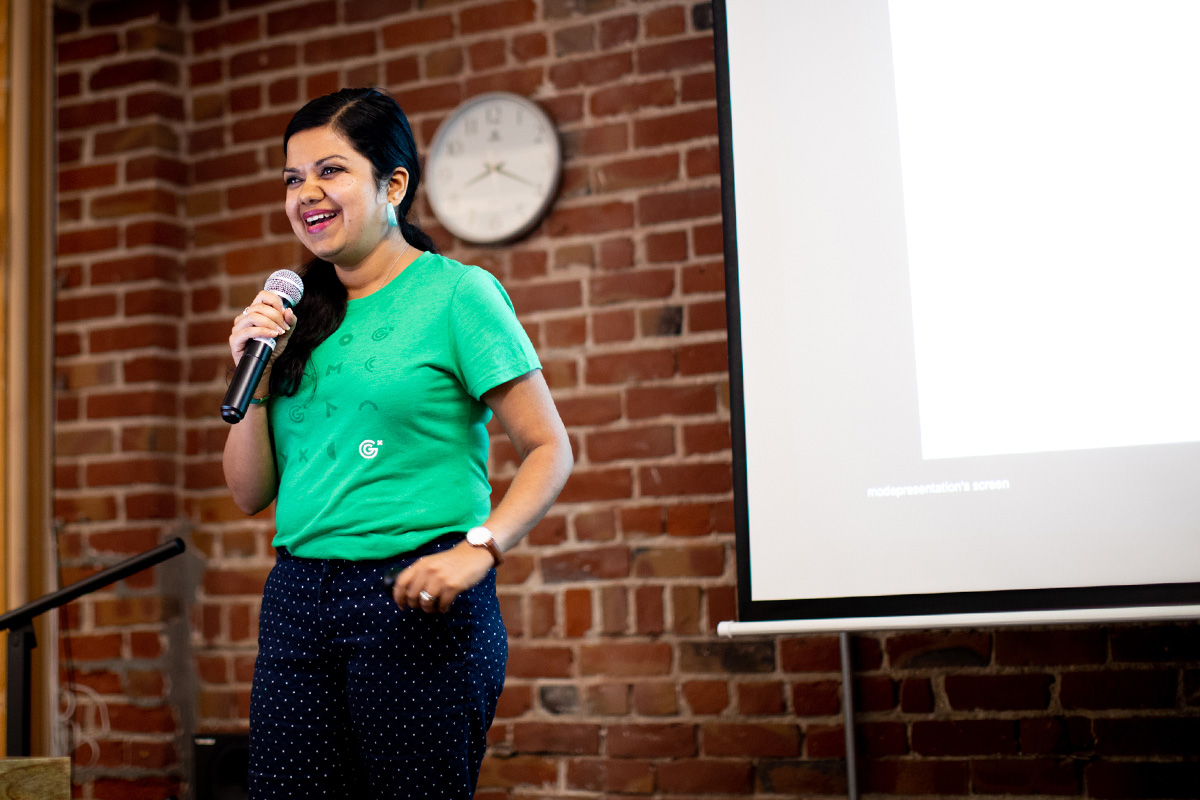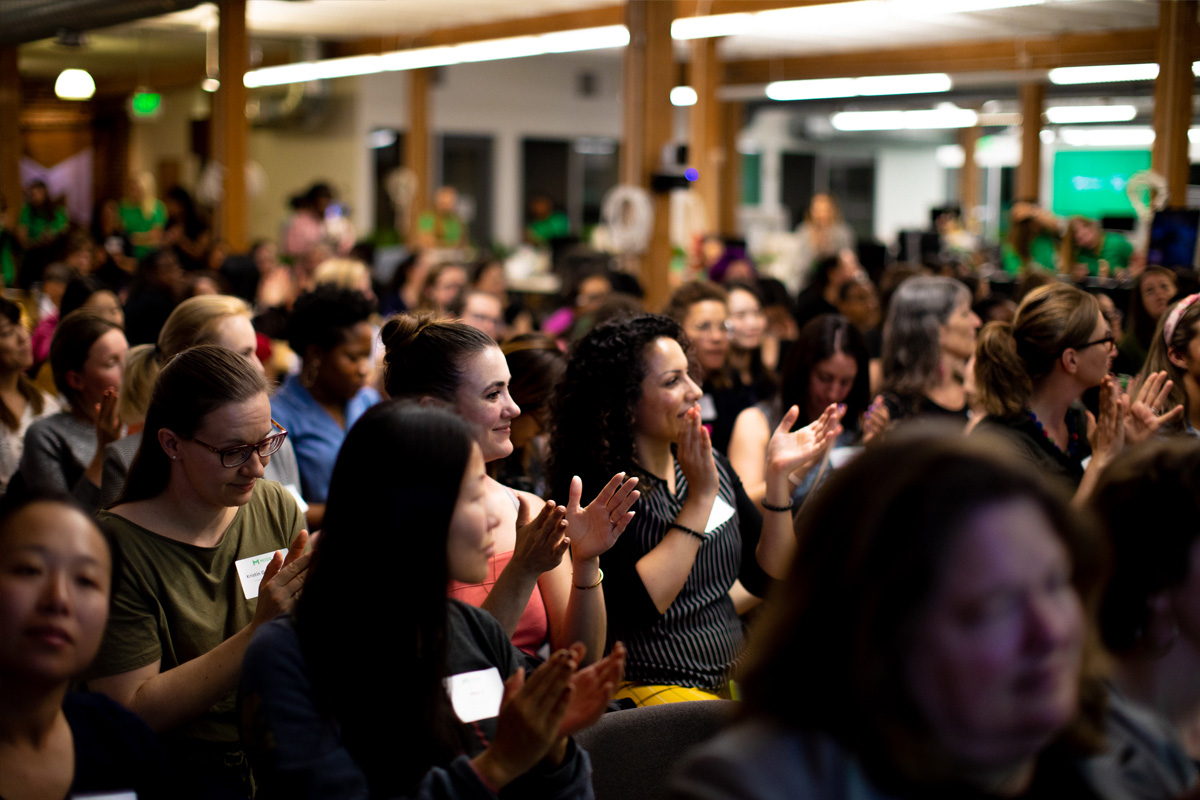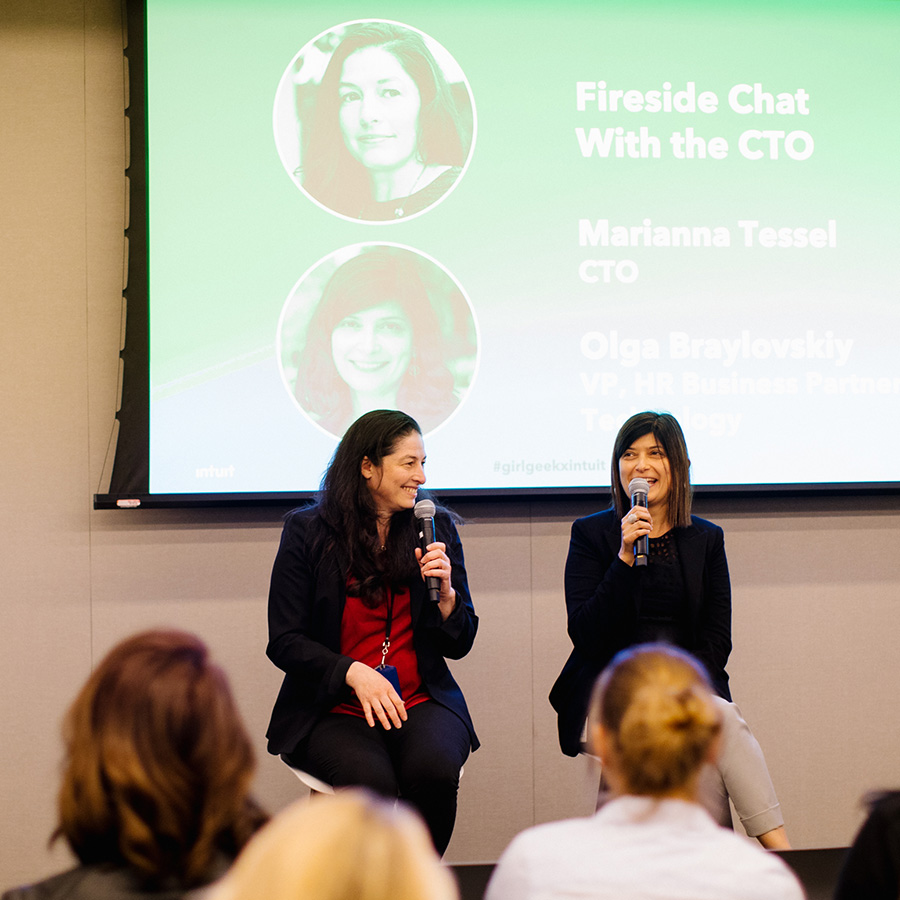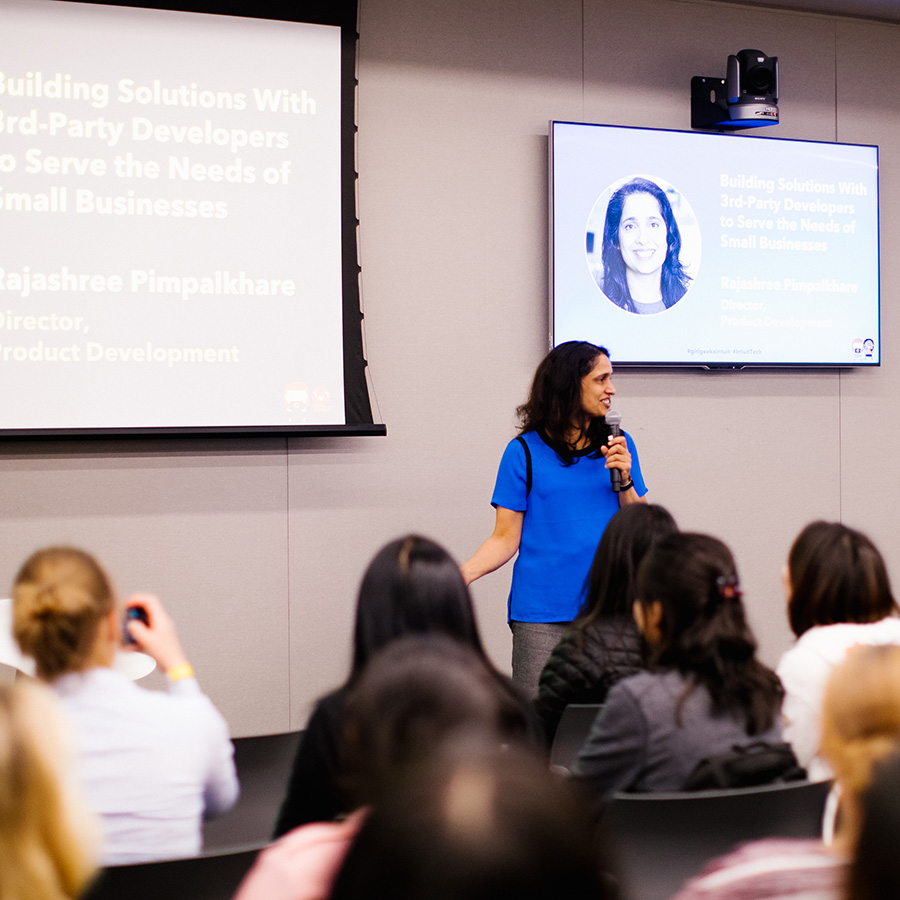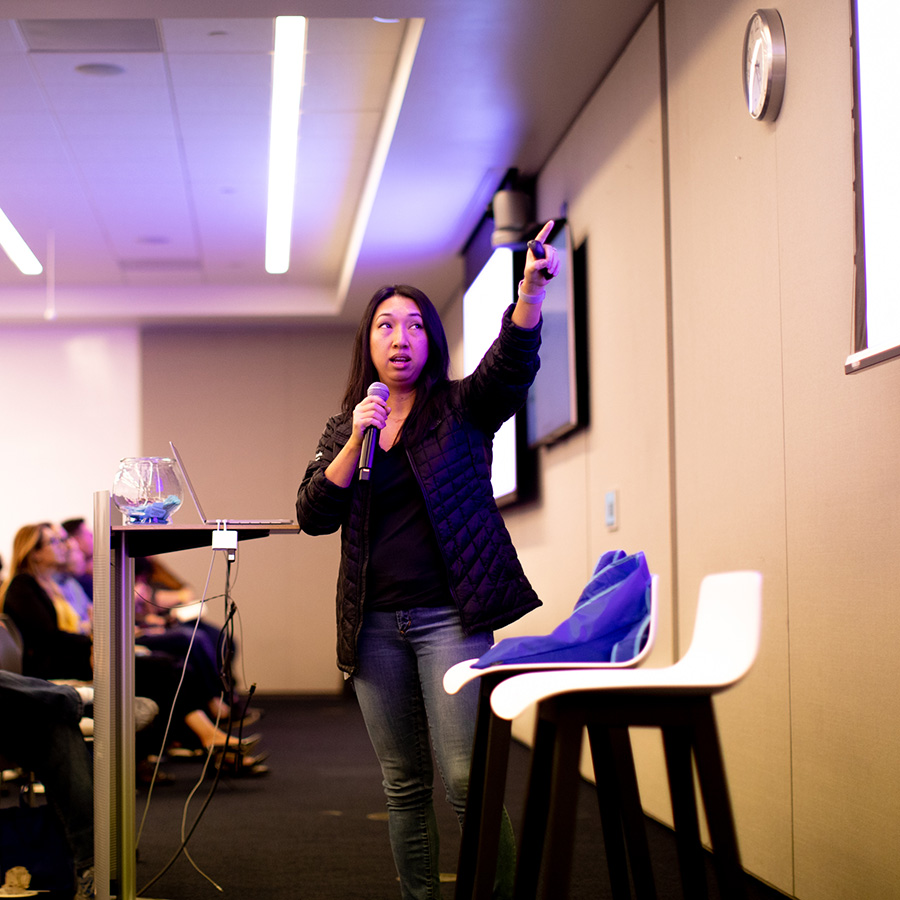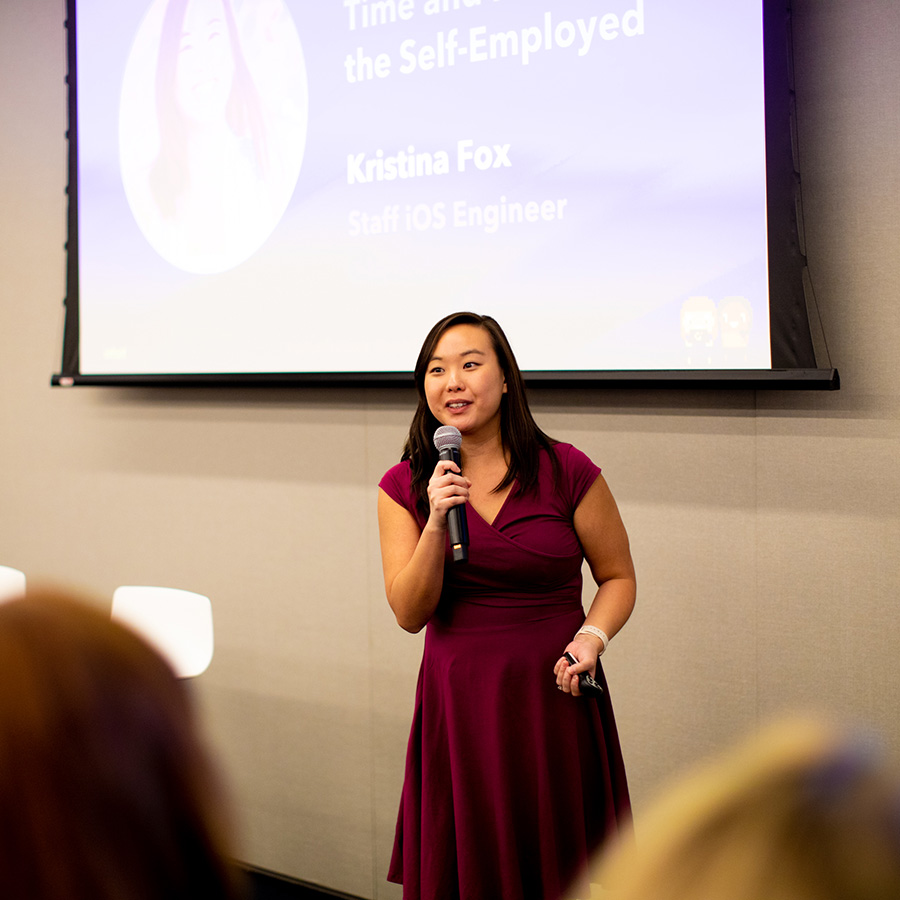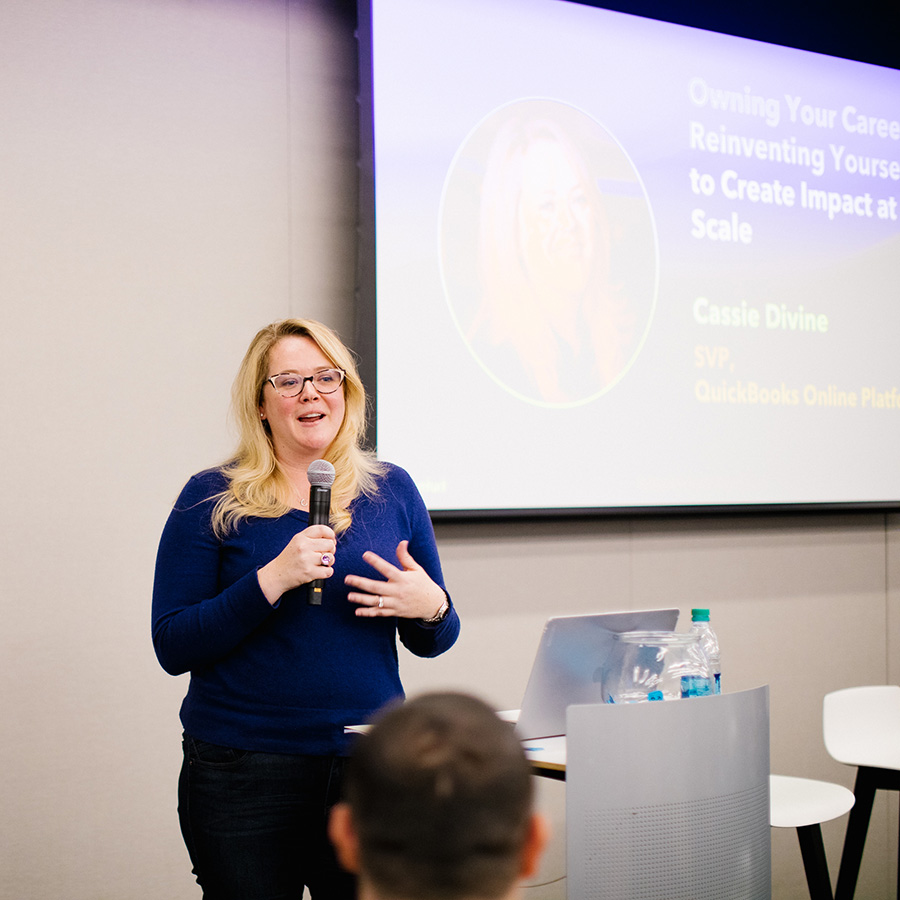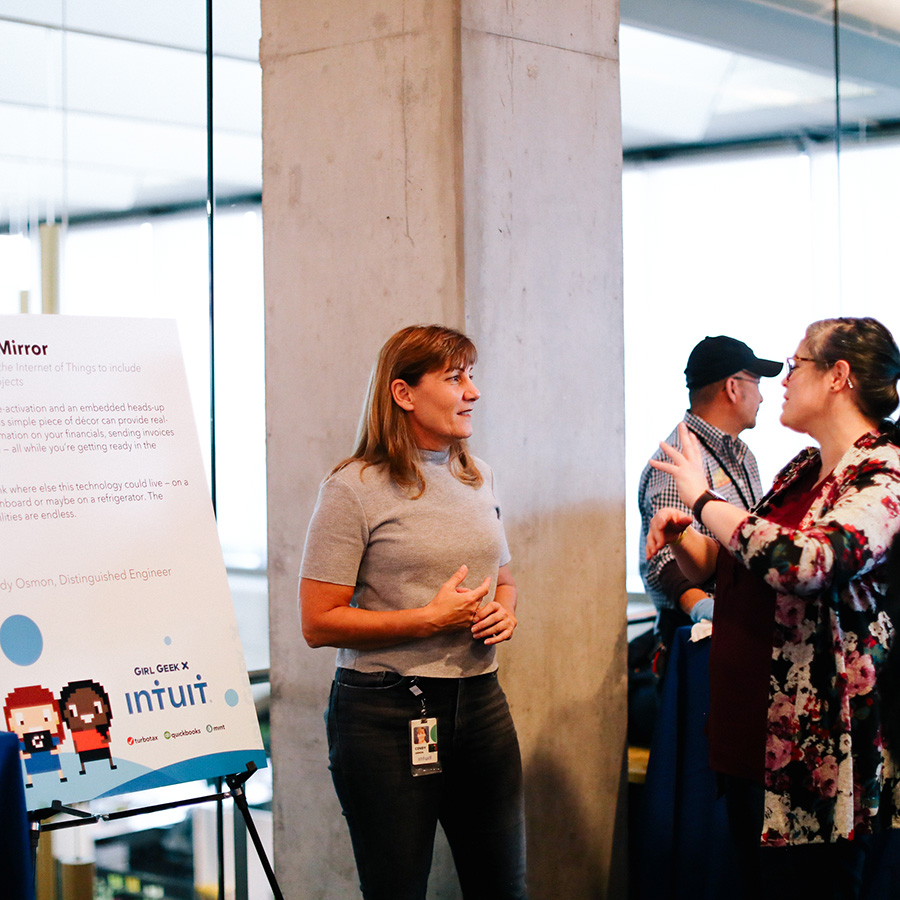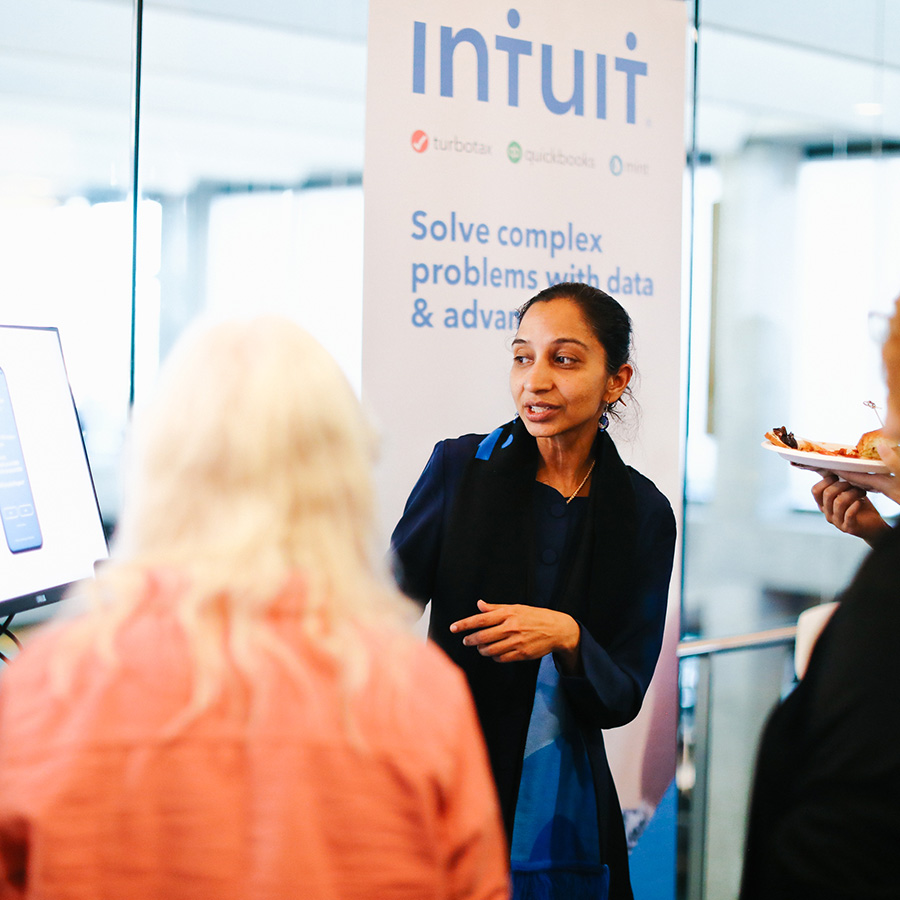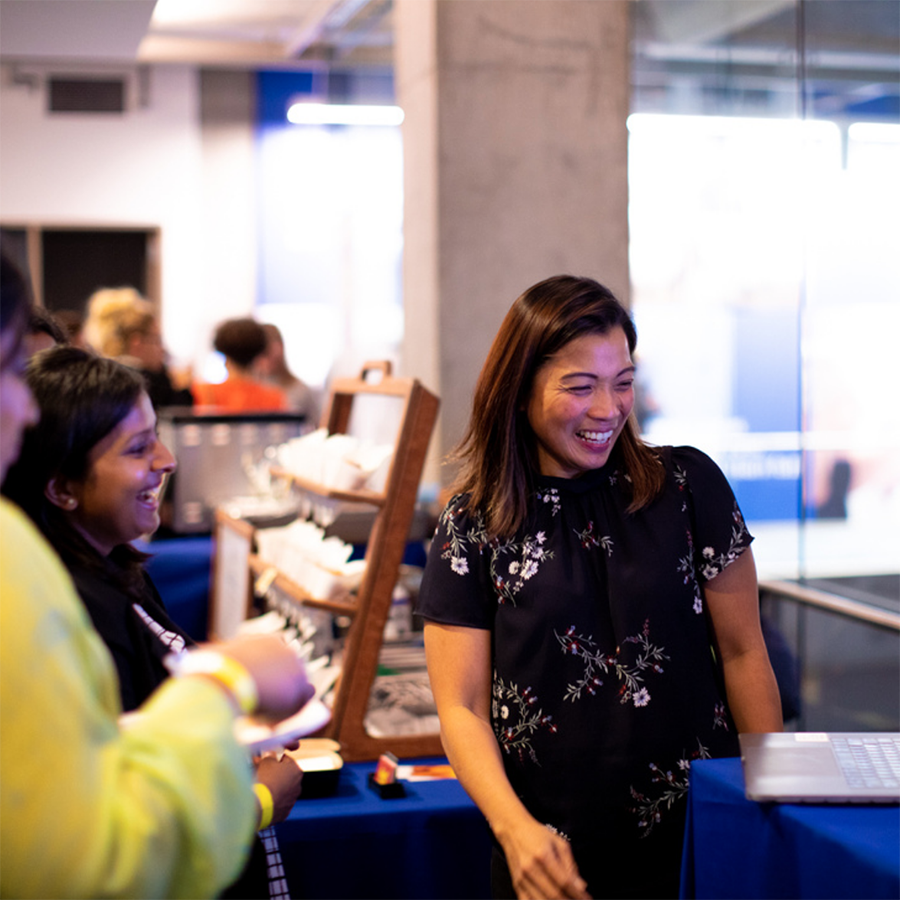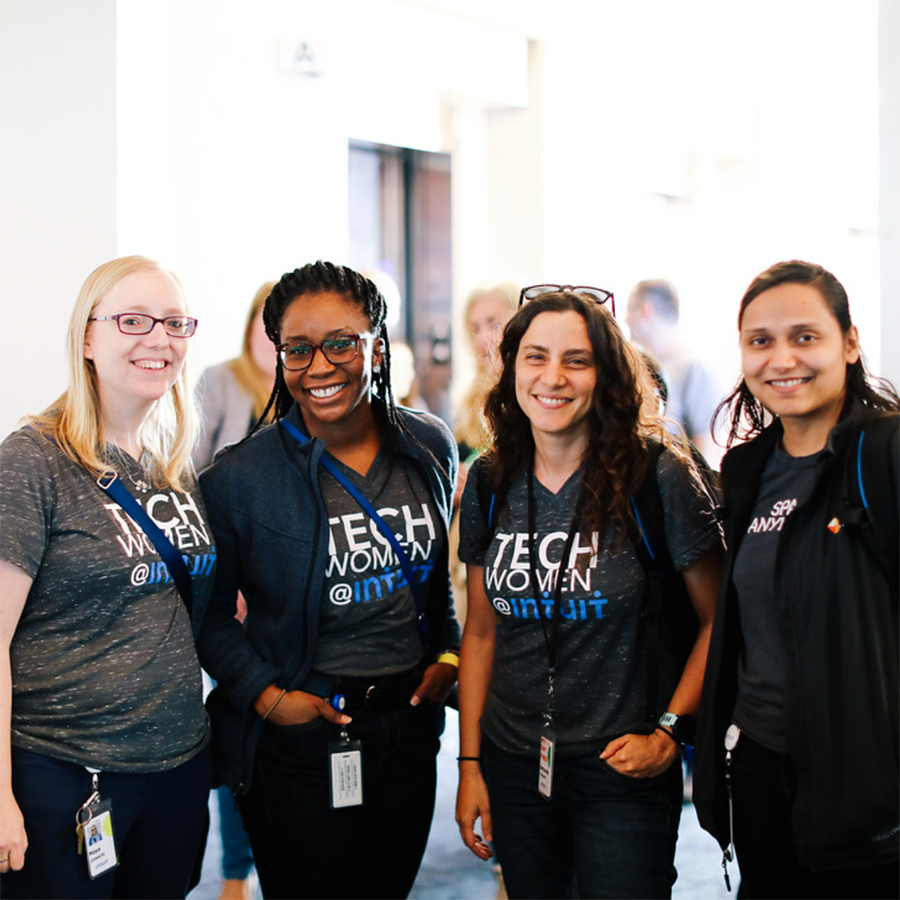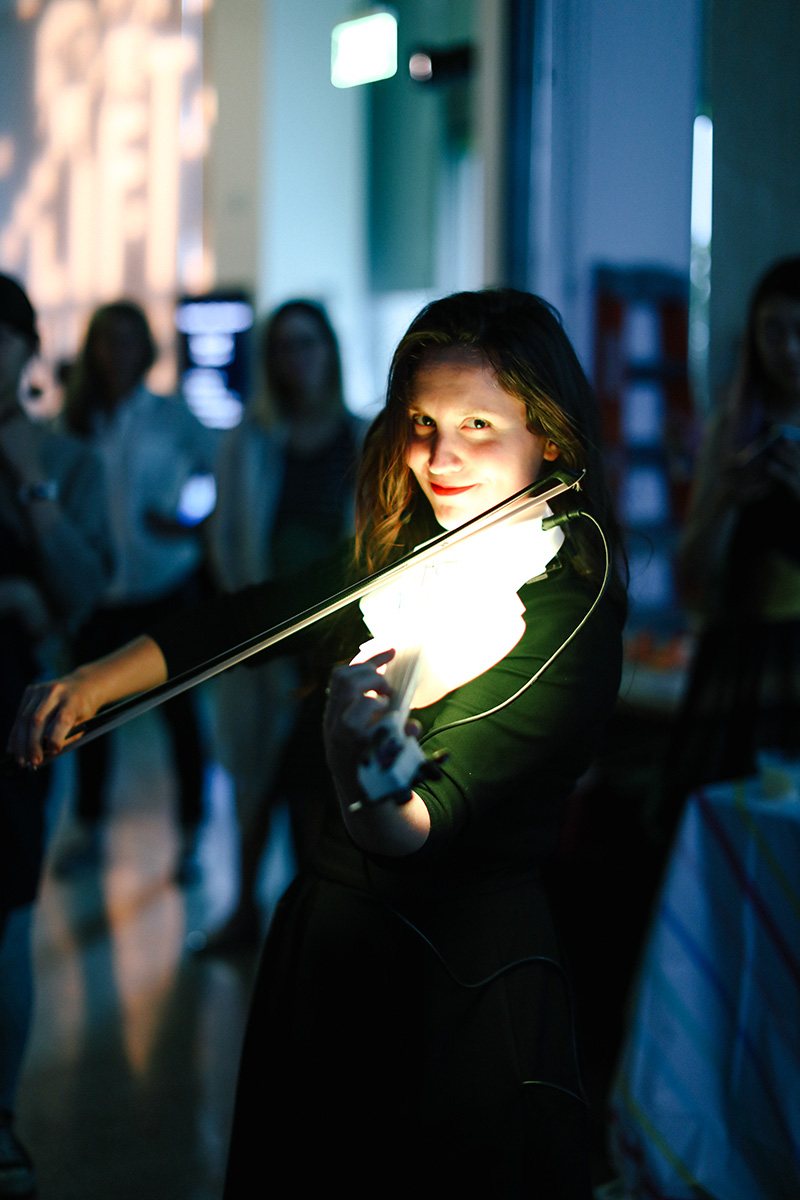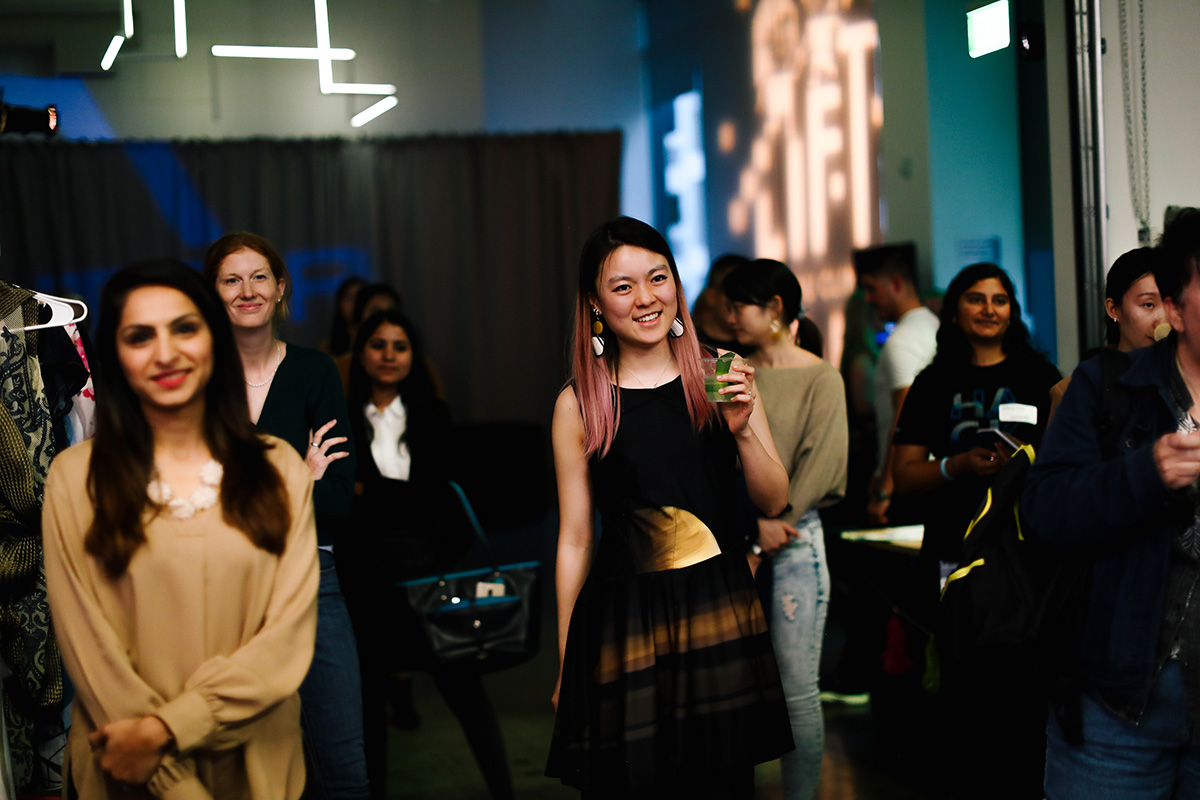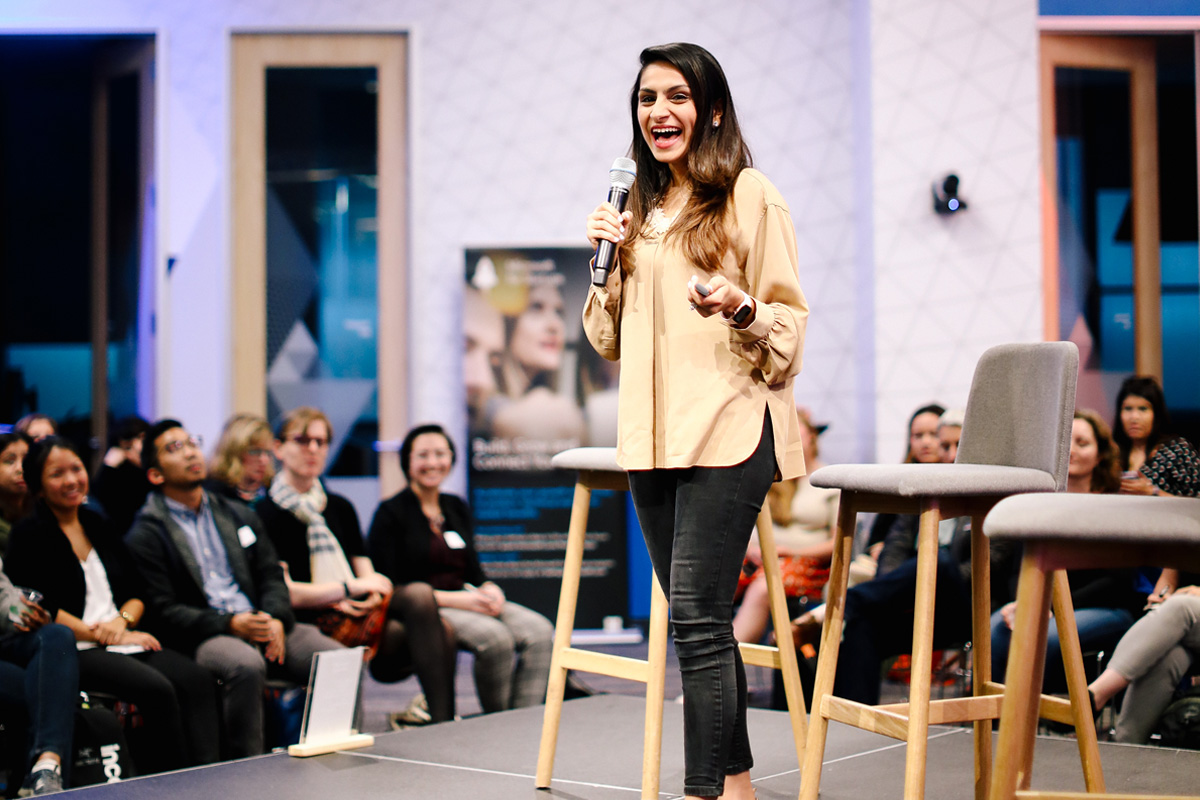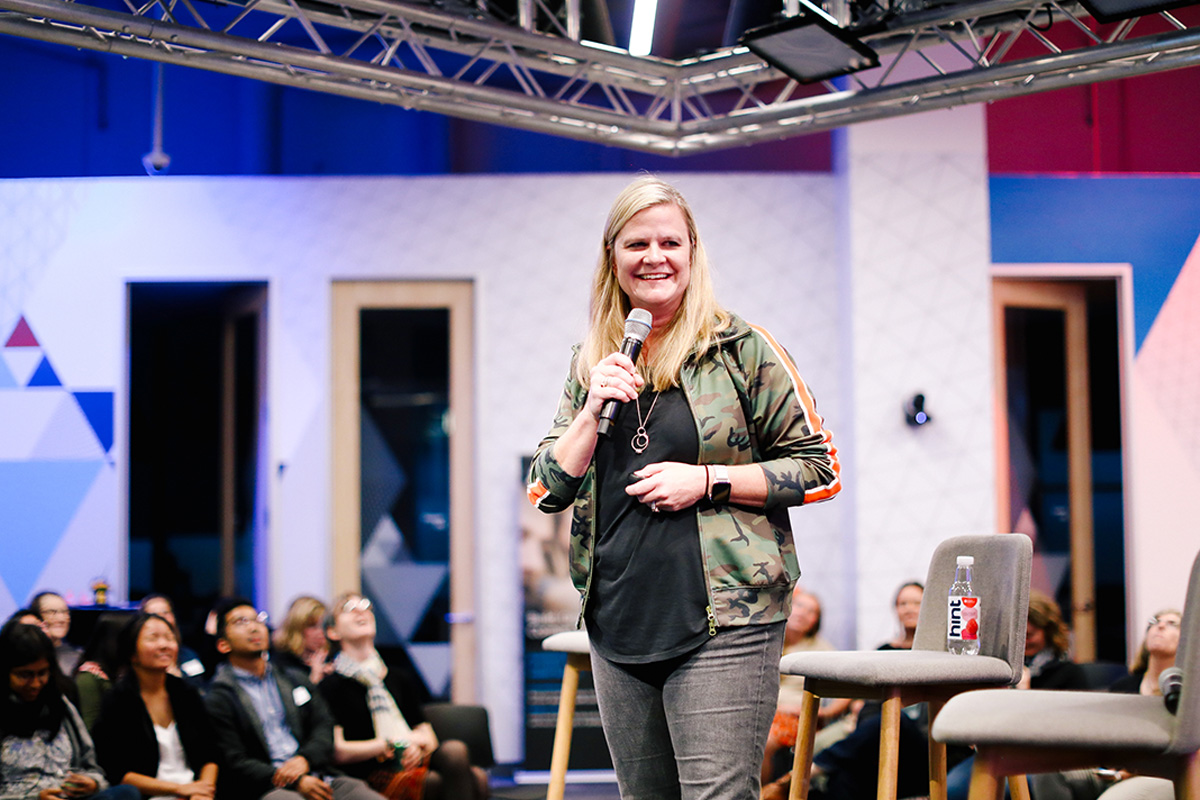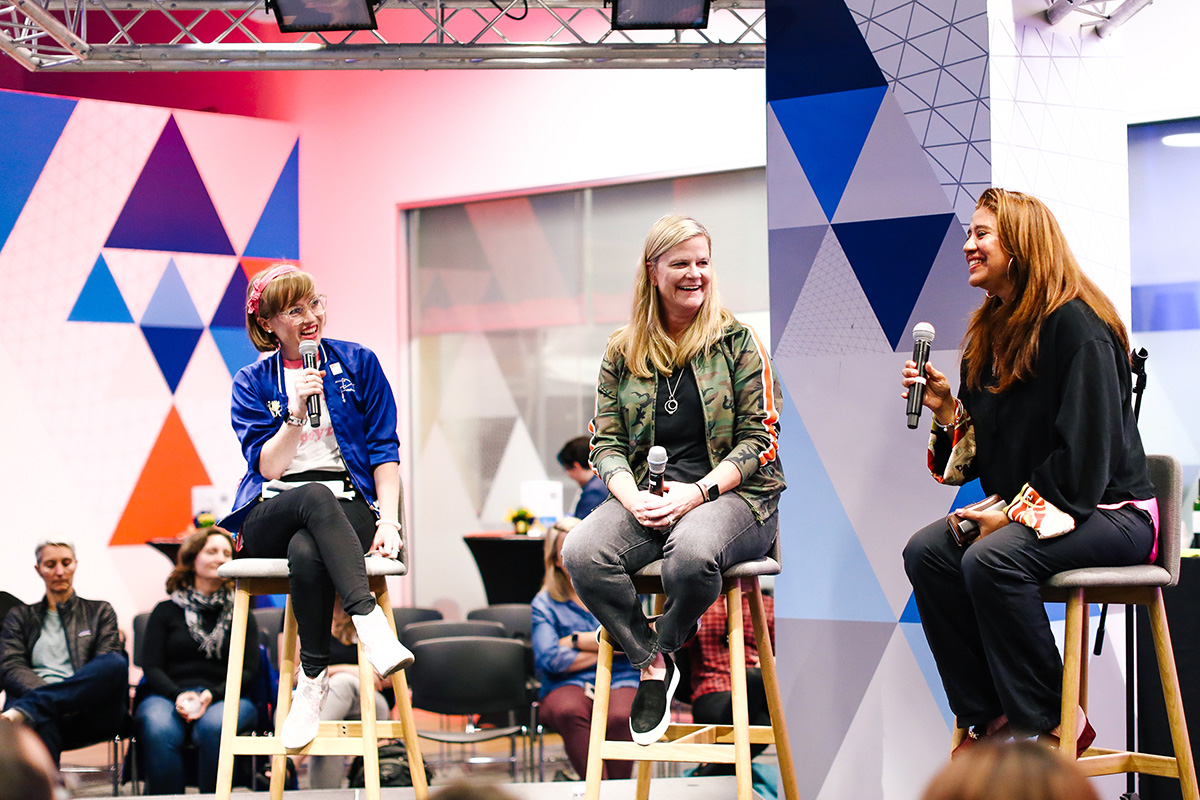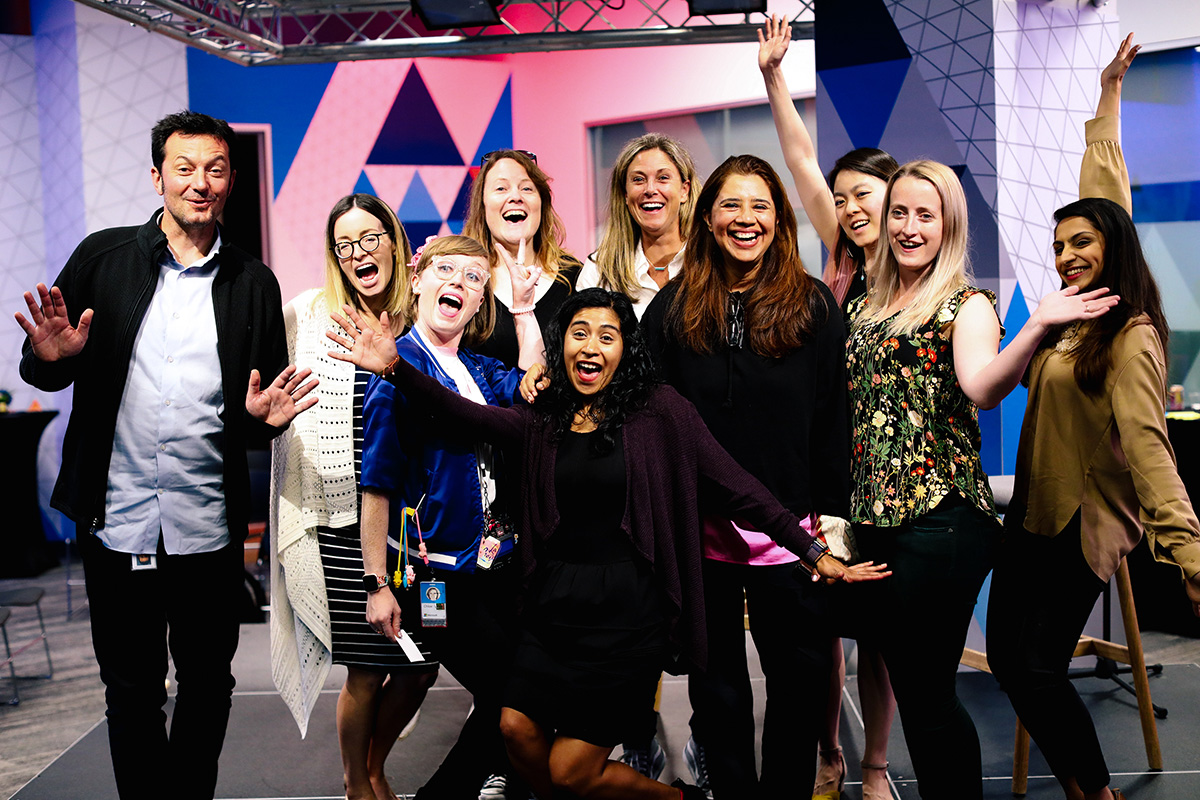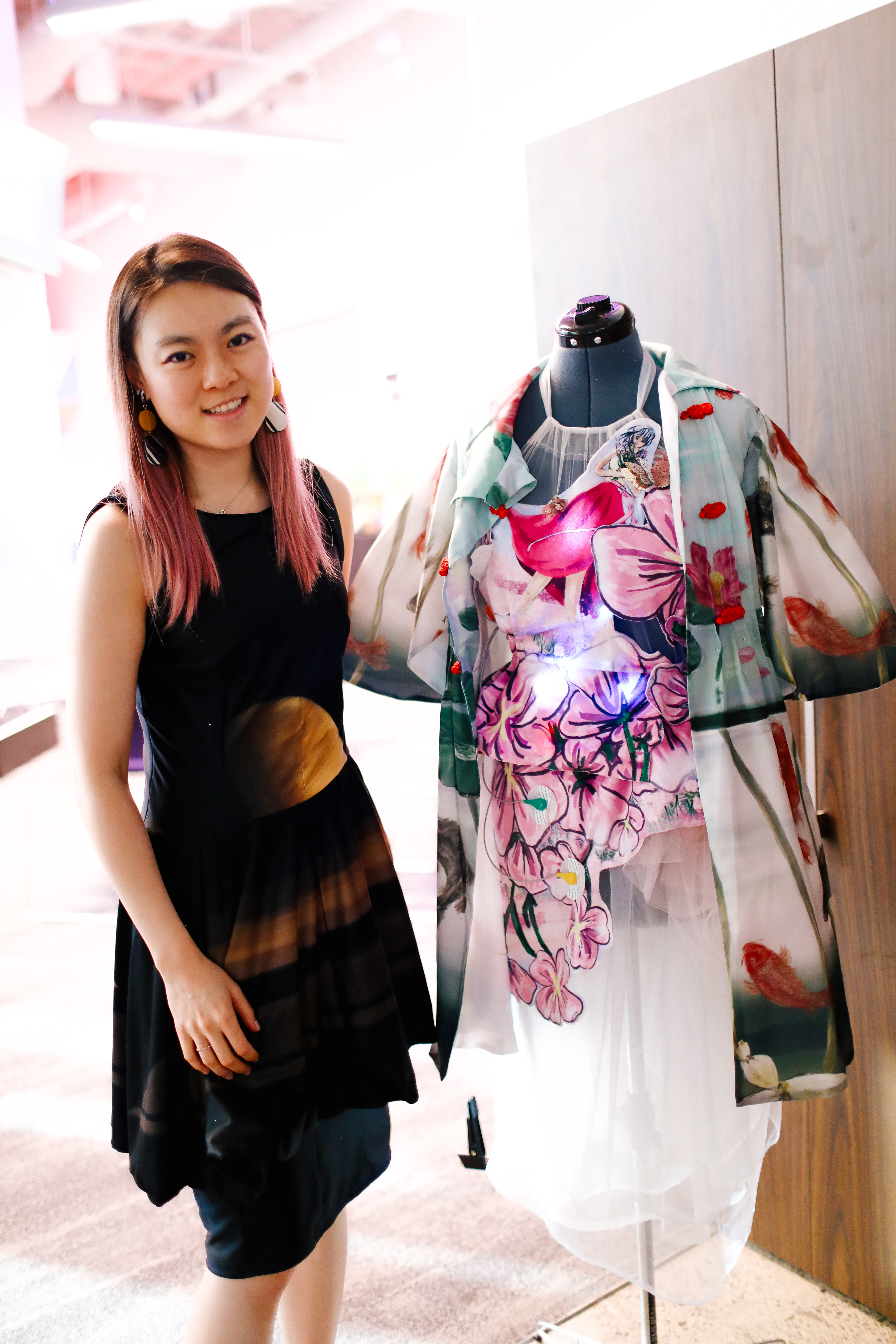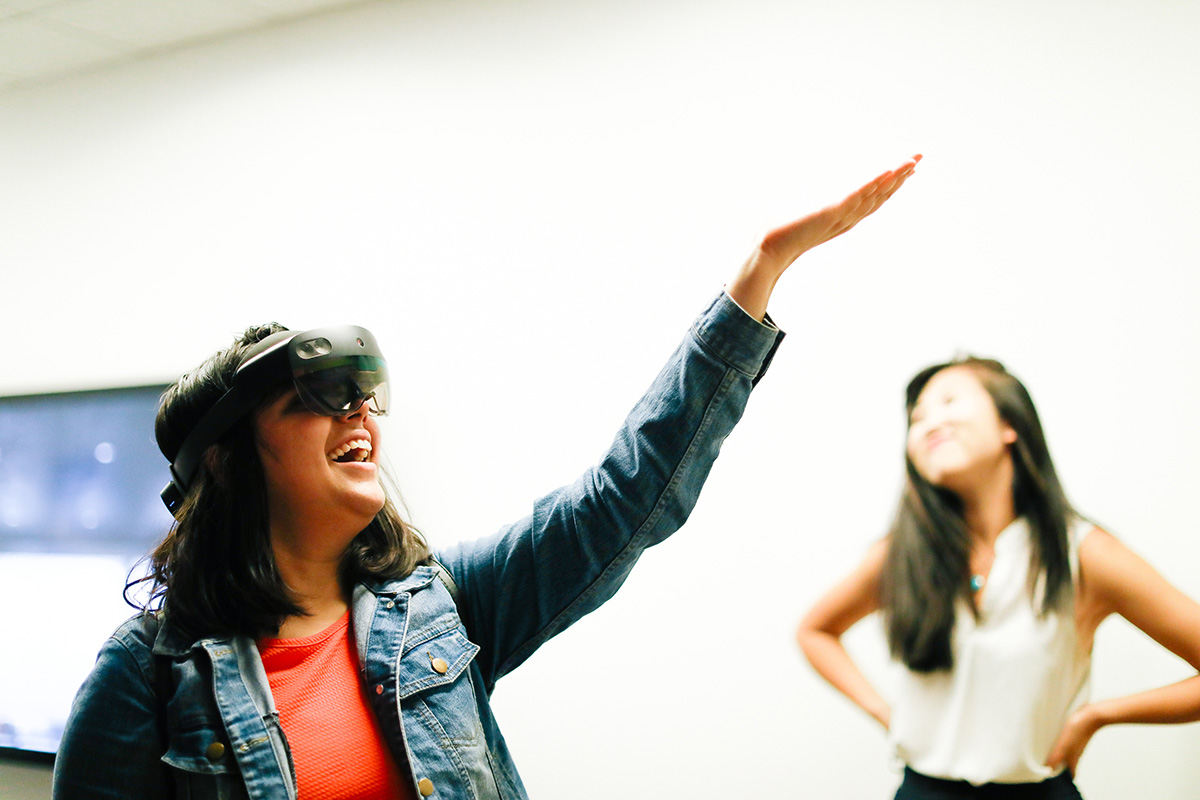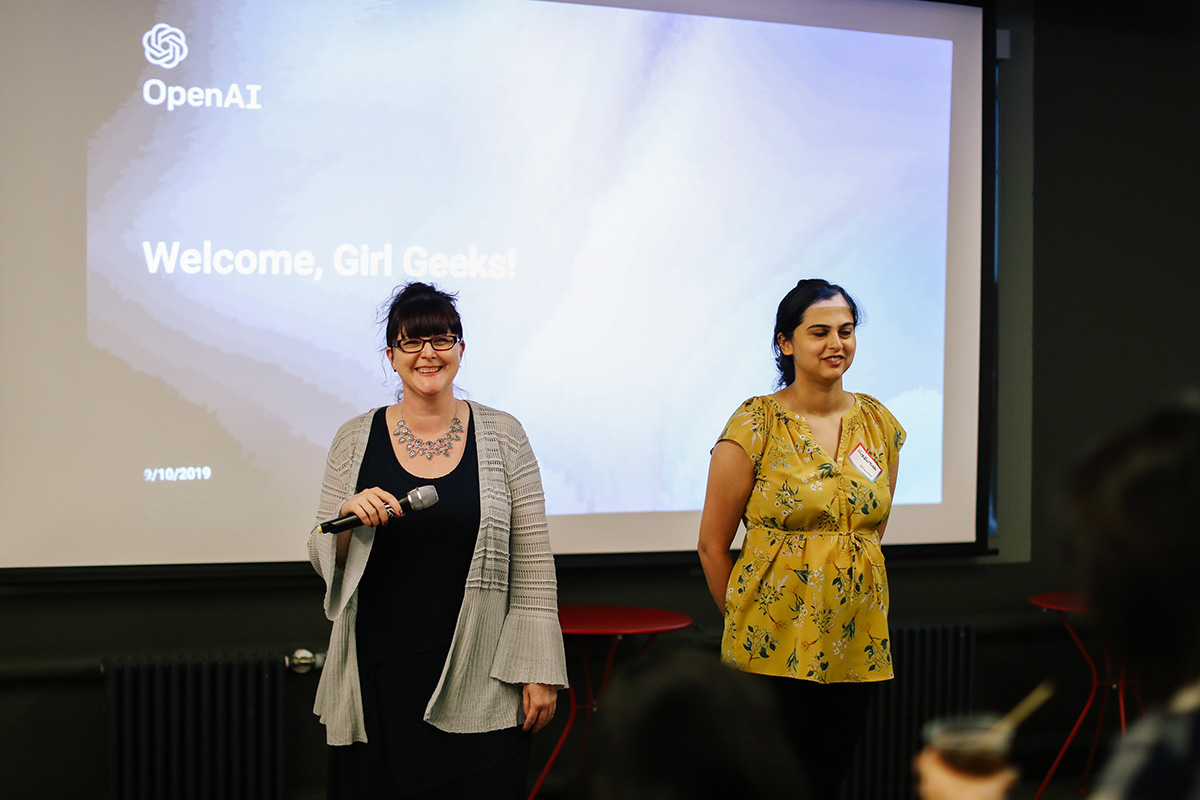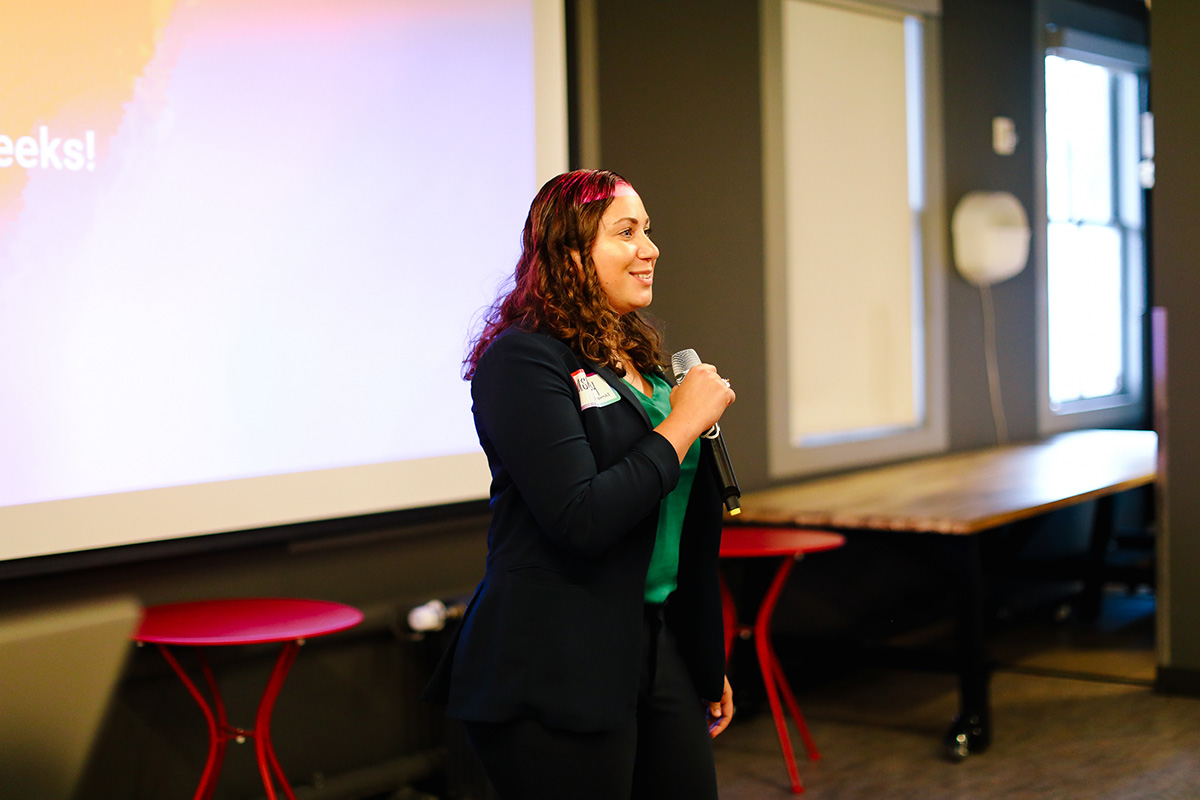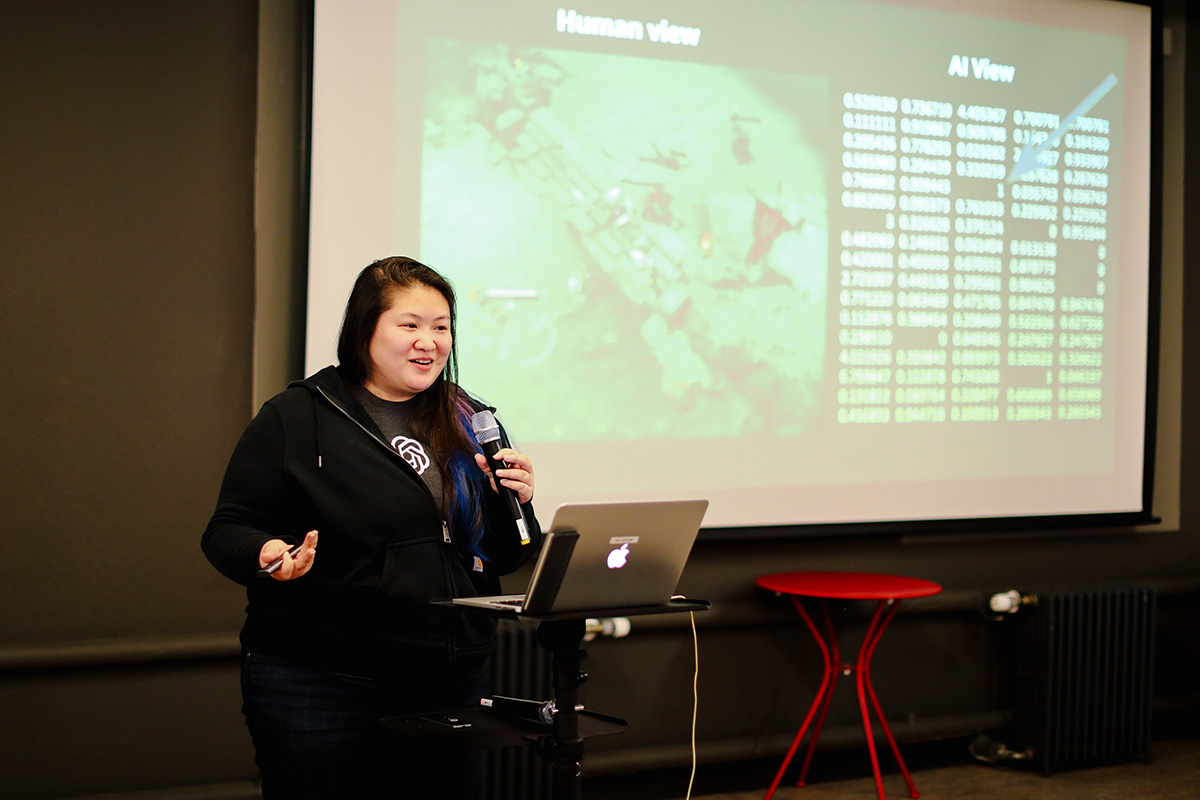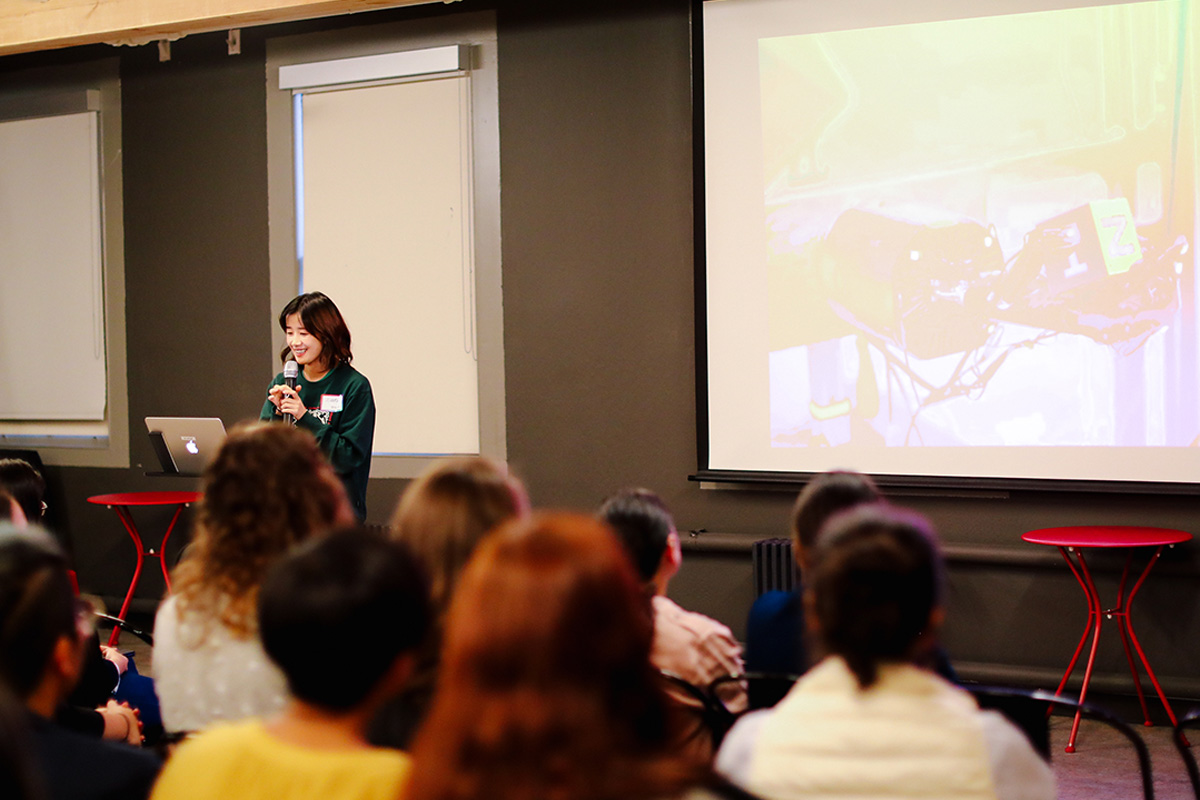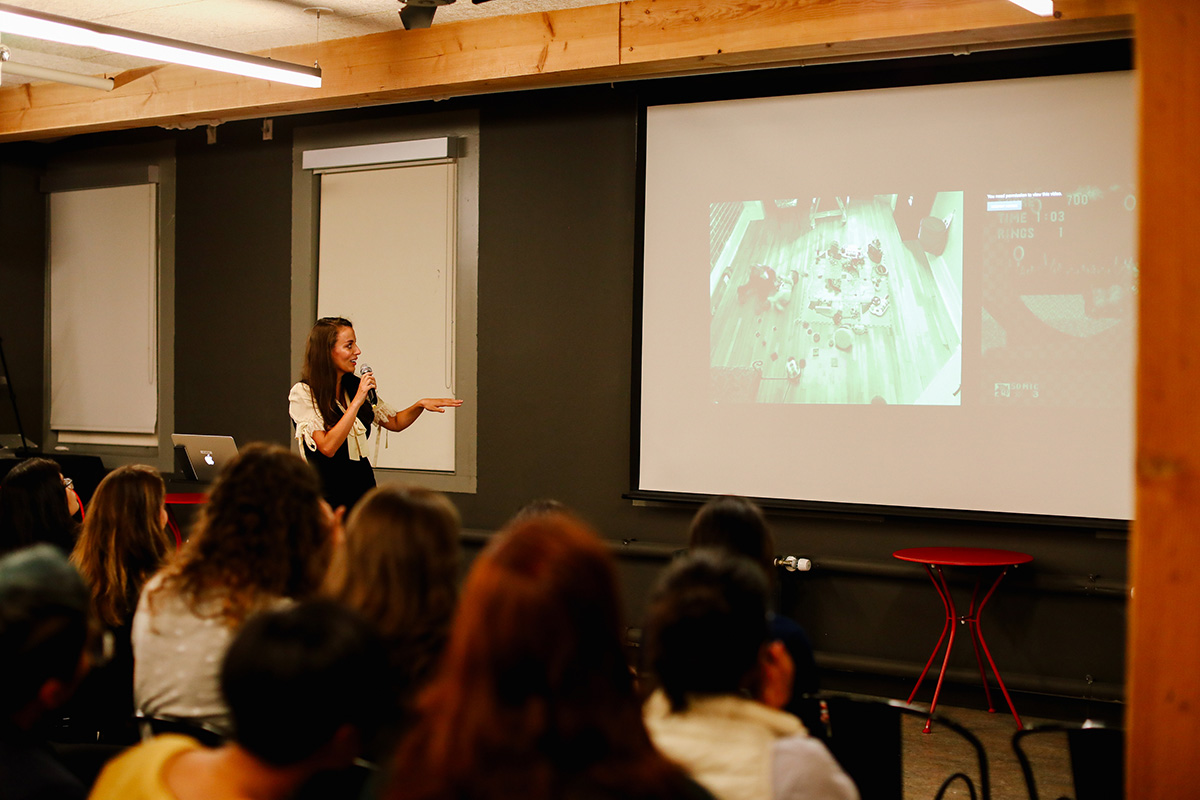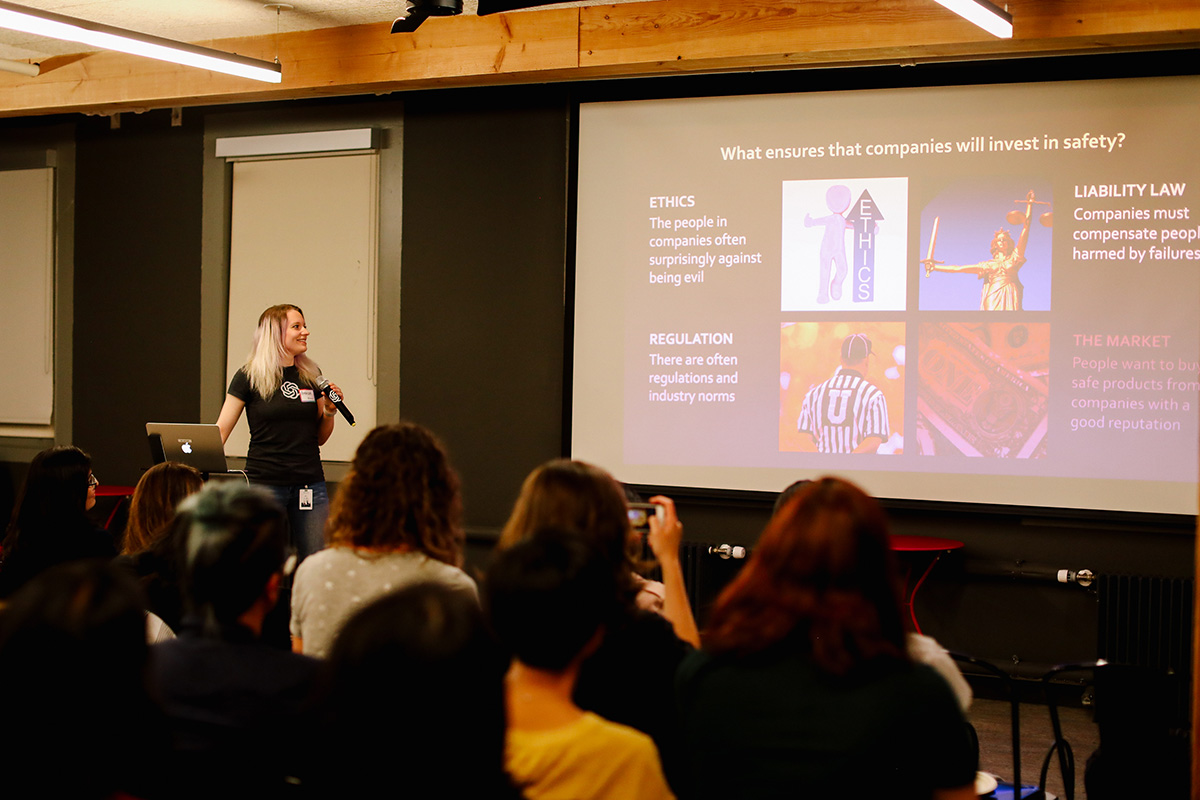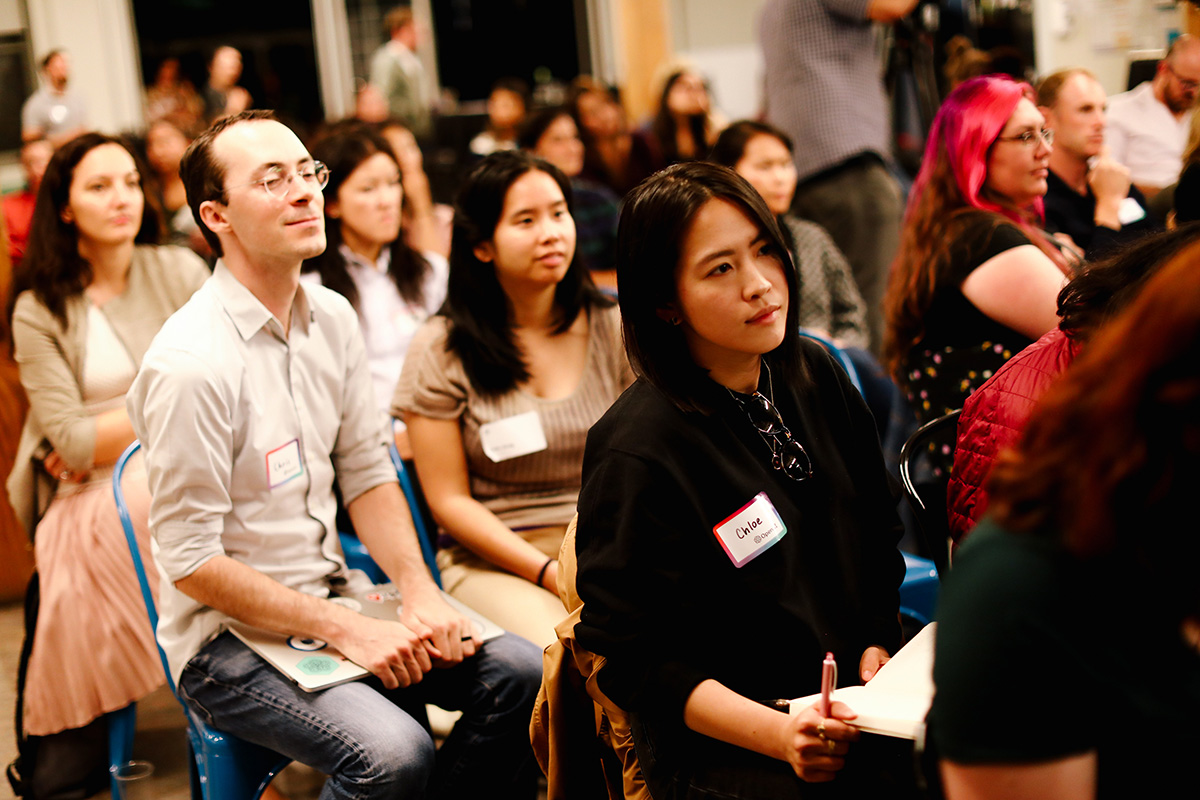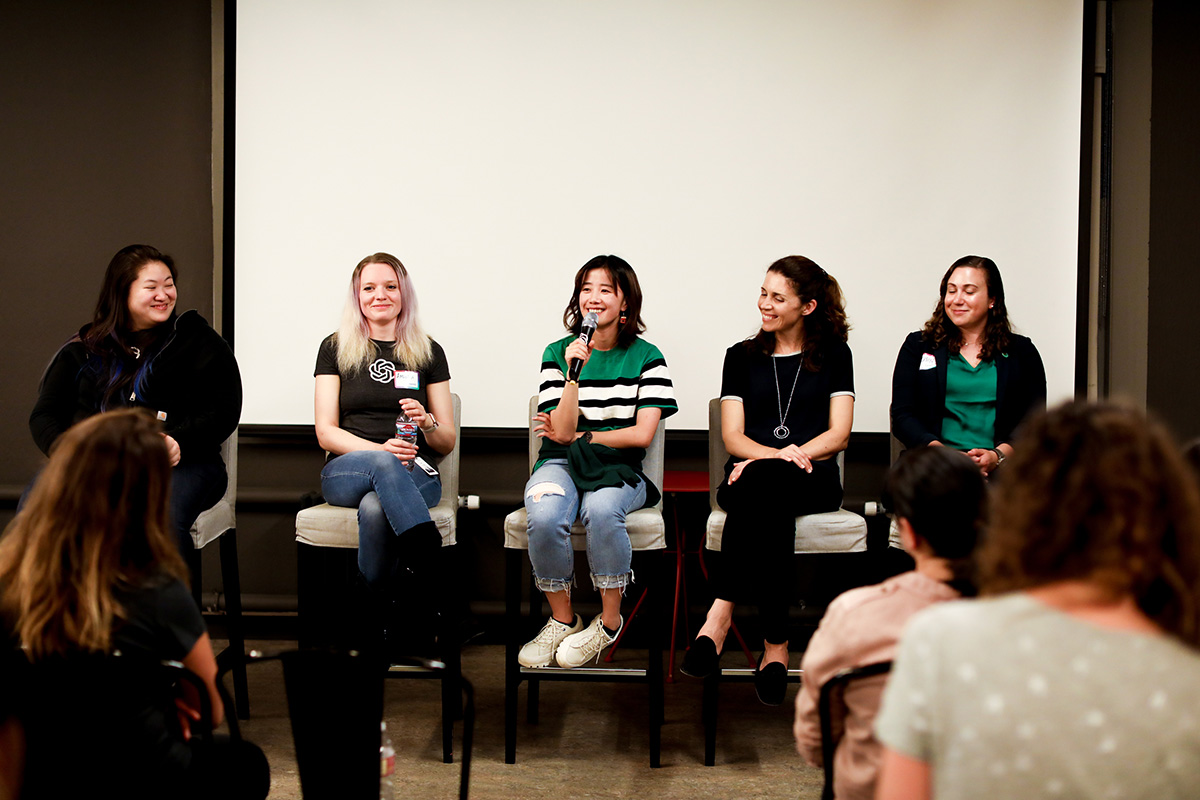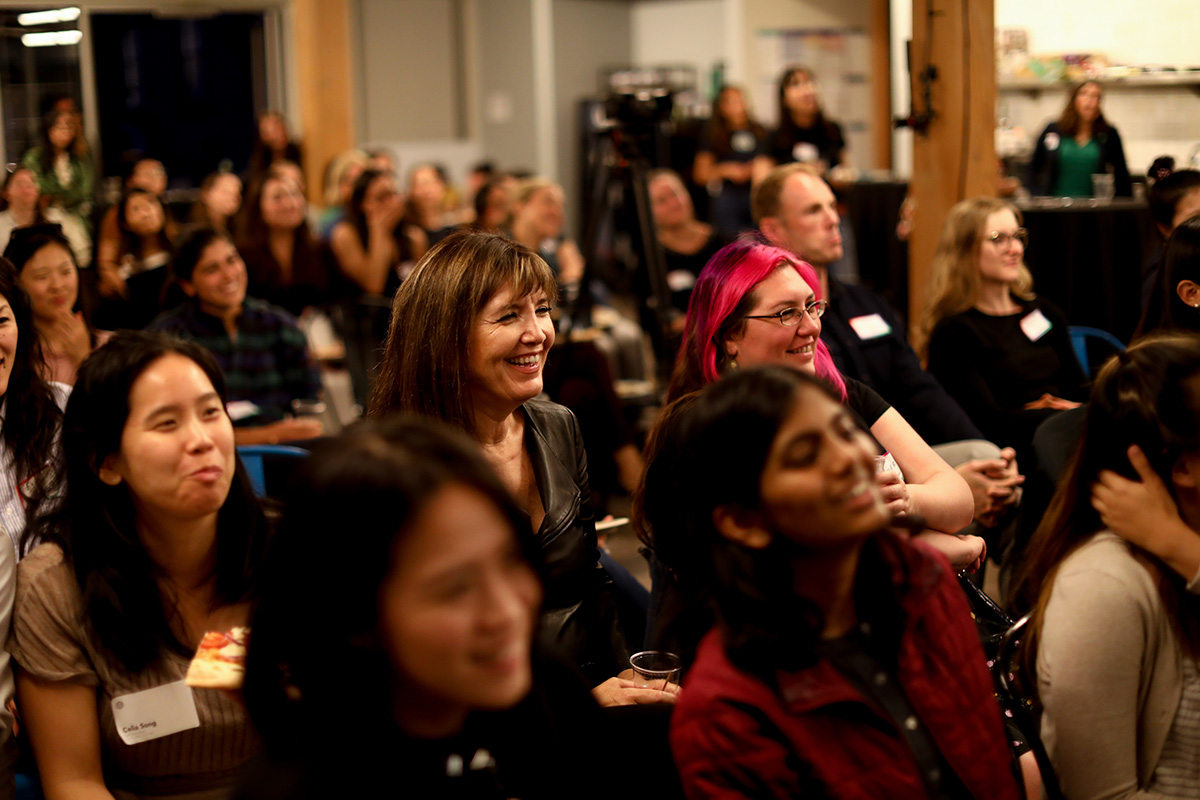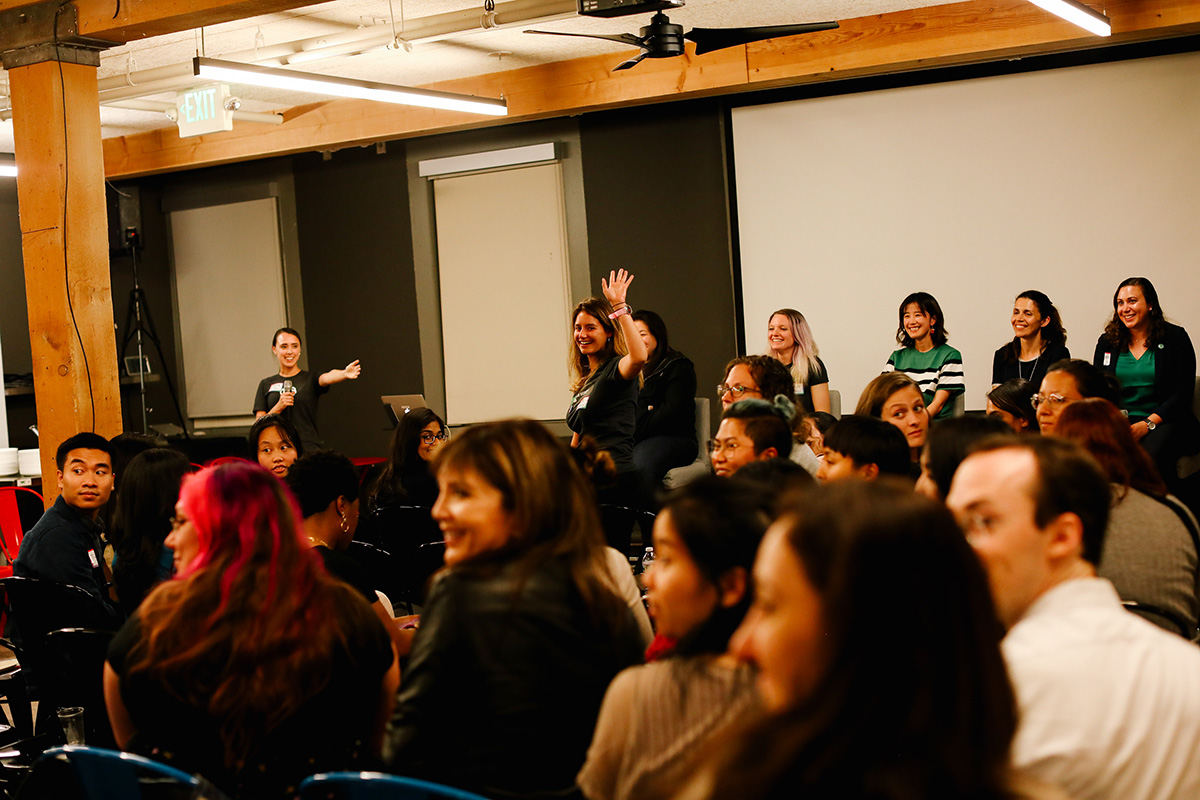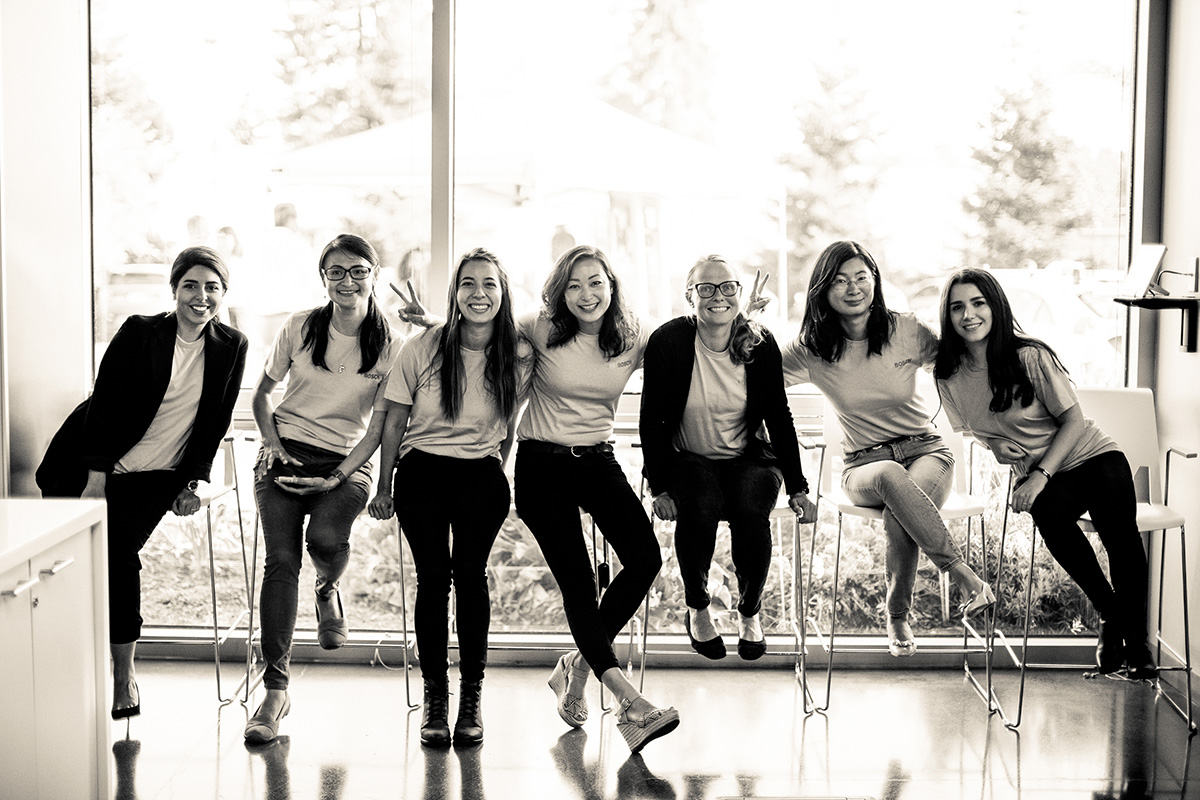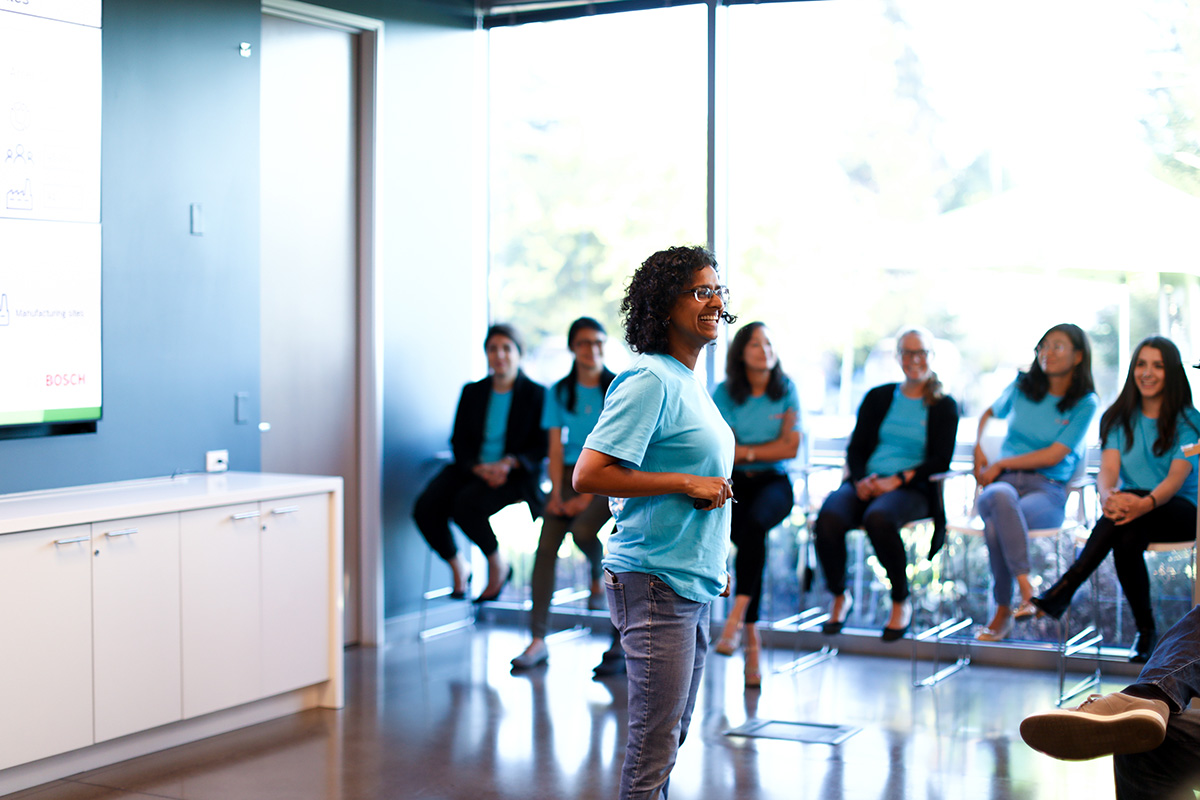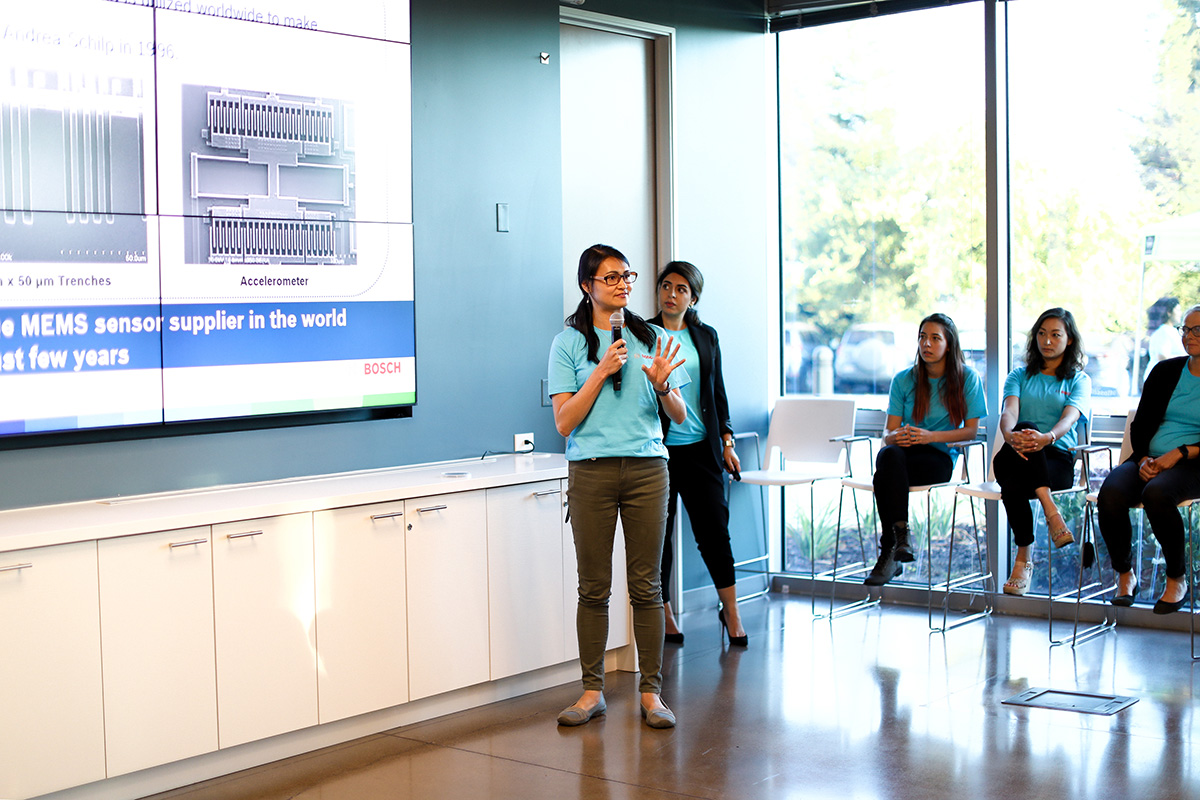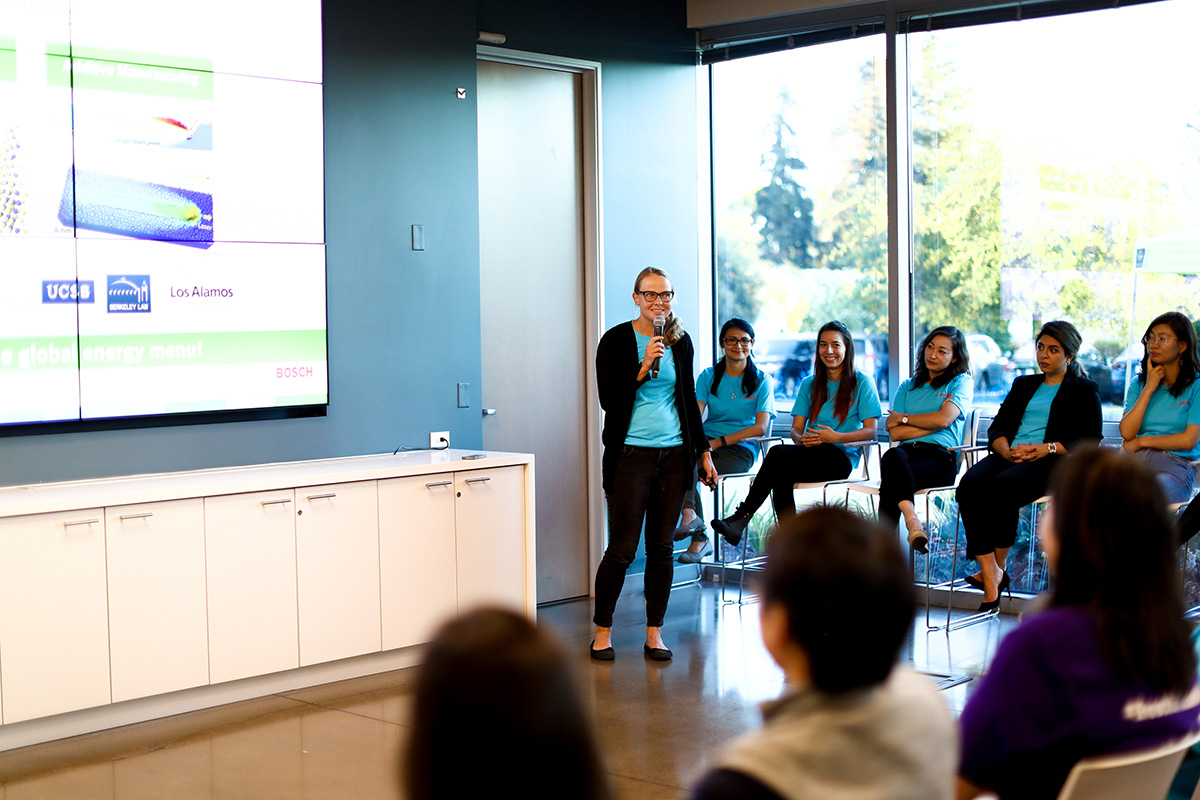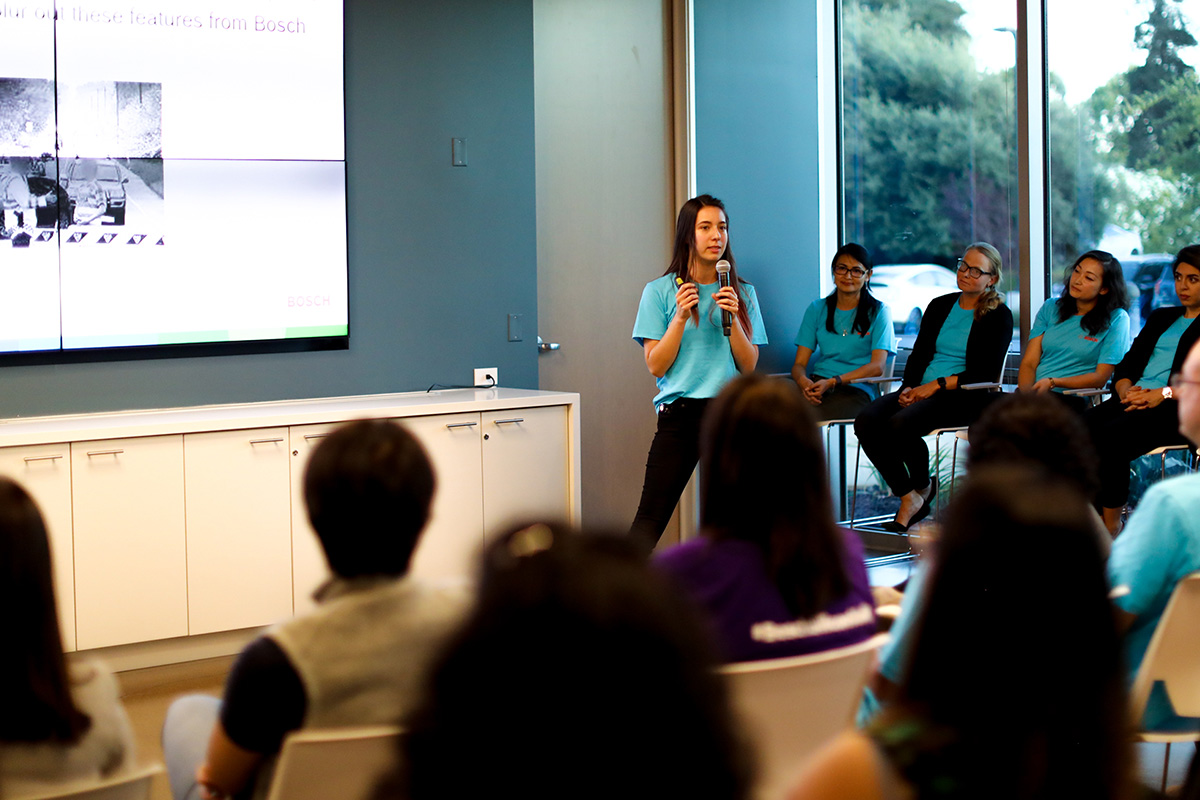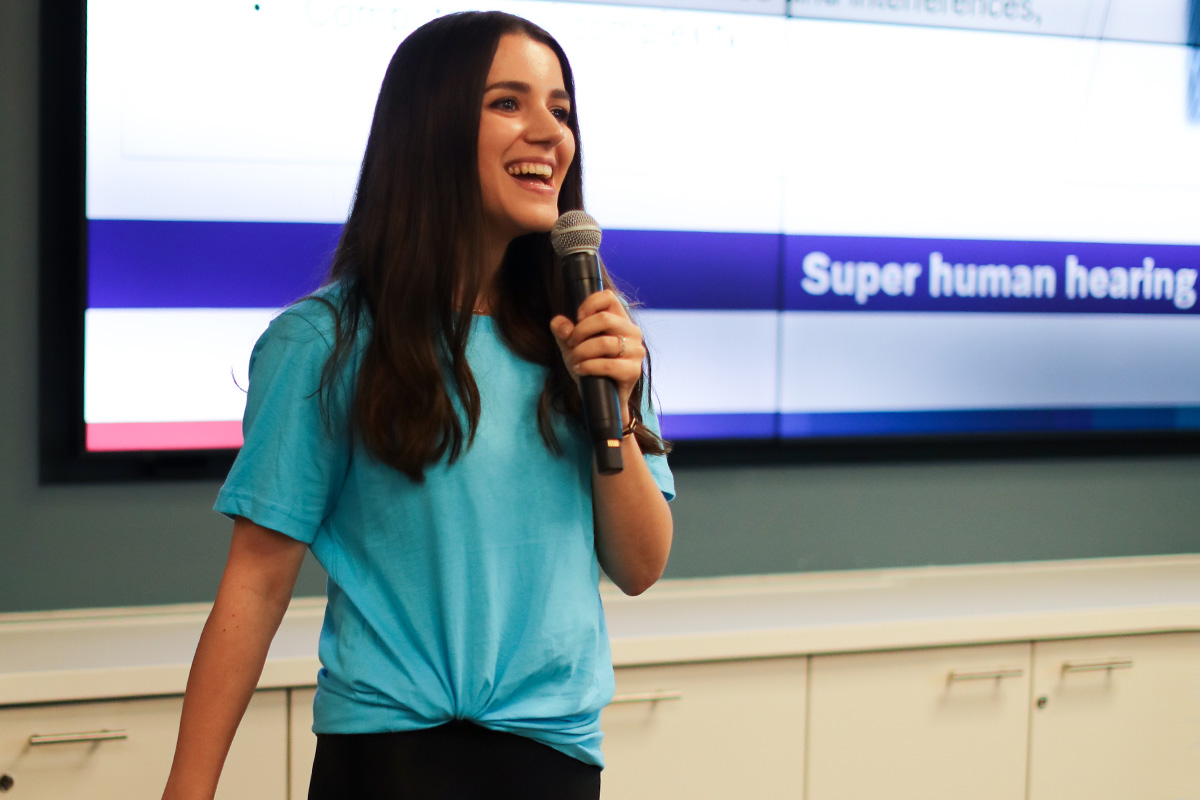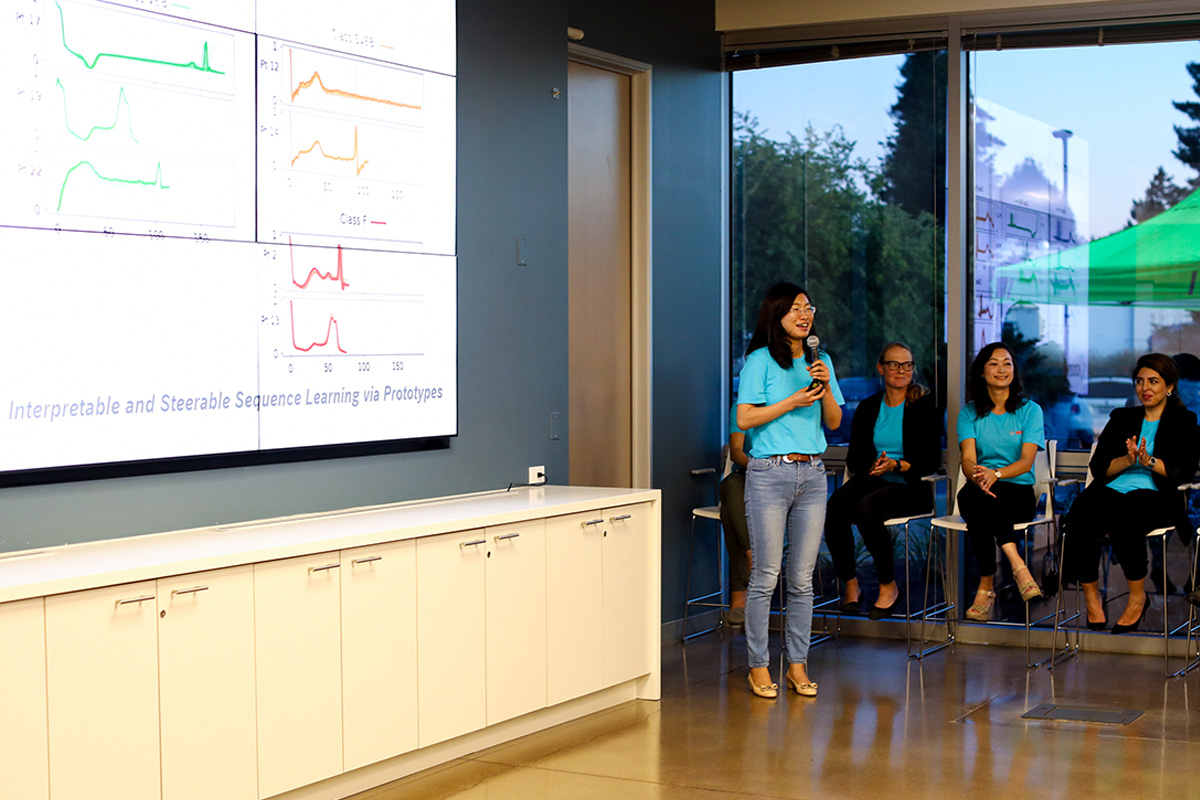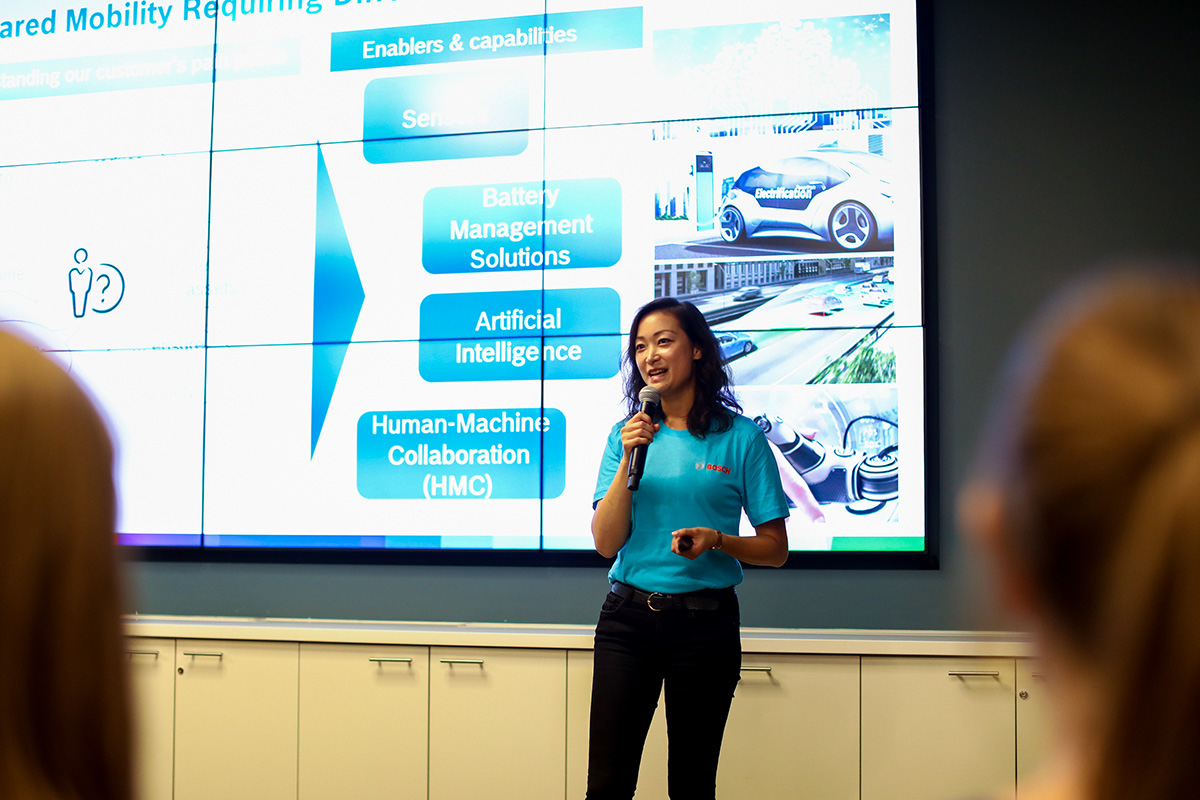Like what you see here? Our mission-aligned Girl Geek X partners are hiring!
- See open jobs at Planet and check out open jobs at our trusted partner companies.
- Does your company want to sponsor a Girl Geek X webinar in 2021? Talk to us!
- See open jobs at Planet and check out open jobs at our trusted partner companies.
- Does your company want to sponsor a Girl Geek X webinar in 2021? Talk to us!
Transcript of Planet Girl Geek Dinner – Lightning Talks:
Angie Chang: It’s six o’clock and that means it’s time for another Girl Geek Dinner, and this time, however, we are coming to you virtually for the first time!
Sukrutha Bhadouria: Just going virtual opens up our access to you and to you to each other, few people in various time zones, some people who say they’re in London at 2 A.M.
Angie Chang: I’m just super excited to be able to partner with Planet and bring this evening of talks to hundreds of girl geeks.
Adria Giattino-Johnson: So today I’m going to talk about diversity and belonging and the climate that we’re at right now and how it’s not business as usual, and rethinking what diversity is going to looks like in 2020.
Lisa Huang-North: And when you do make that leap into your new role, how long do you want to be there? Is there a stepping stone to another bigger career pivot? For example, if you’re moving to a new industry or is it a way for you to grow and really deepen your expertise, for example, within the industry or within the field?
Sara Safavi: Along the way I’ve had to pick up some new habits, some new practices and ways of working in order to make my staye in remotesville as a remote employee sustainable.
Barbara Vazquez: What I’m going to talk about today about agile development and estimation, because I’m a software engineer and we do agile development at Planet. These are some tips that might be useful on a day to day.
Kelsey Doerksen: Today, I’m going to be talking a little bit about how to handle big data in space and the different machine learning projects I’ve been a part of over the past few years.
Deanna Farago: My name is Deanna Farago and my team and I operate a fleet of satellites that are currently imaging the entire planet every day.
Elena Rodriguez: I chose a topic because this is something that I’m always thinking about it, and now I have the opportunity to talk about it and I’m going to take advantage of this – this is how I ended up here, so I’m going to show you my story.
Sarah Preston: Stories are passed to community and understanding. So think about all the stories that you loved growing up. There were some kind of connection that you made, either to a character, to the author or to the setting that drew you in and made it really memorable.
Brittany Zajic: I’m on the business development team here at Planet. Business development means something different at every company. Here we focus strategic partnerships and the commercialization of new markets.
Nikki Hampton: At Planet we have always been committed to diversity, but we are doubling down on our commitment and particularly so looking with respect to attracting and retaining communities of color. For all of you online, we are looking forward to and eager to work with you to tap into a broader network of talented folks that you might want to consider referring to us or applying and sharing with a who you know. But we’re super excited to have been part of this and are grateful that you all attended!
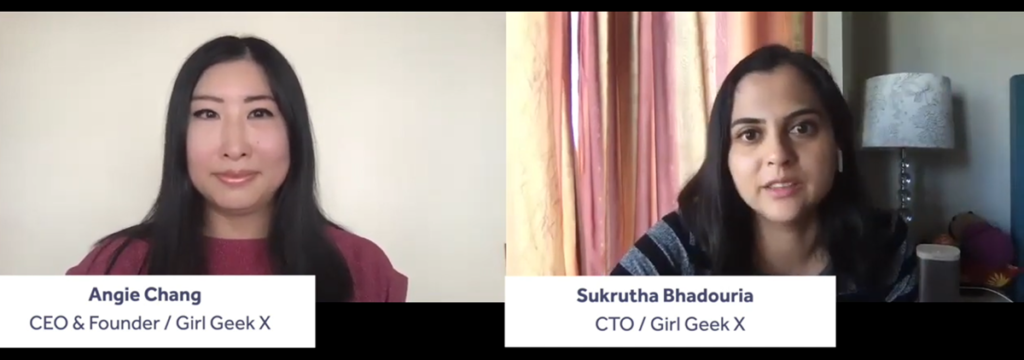
Angie Chang: It’s six o’clock. And that means it’s time for another Girl Geek Dinner… This time, however, we are coming to you virtually for the first time from our homes in Berkeley, California here. Sukrutha, where are you?
Sukrutha Bhadouria: I’m in San Francisco, California.
Angie Chang: And behind the wings we have Amy, who is coming from … Amy, where are you coming from?
Amy Weicker: Pennsylvania.
Angie Chang: Pennsylvania. Awesome. We have a bunch of people coming in. Can you use the chat below and tell us where you’re coming in from? While everyone does that, Oh my God.
Sukrutha Bhadouria: Wow. Orange County, San Jose. [inaudible] India, my hometown. What were you saying, Angie?
Angie Chang: I’m like, normally we get to see you in a beautiful office space. It’s always great to just go to these different companies and go there and meet the people, eat their food, drink some wine — and then hear from their women at the company speaking about what they’re doing at the company. From roles in engineering and product to sales … we’re going to hear from a few sales people tonight .. It’s really great and exciting to hear from many of the women working at the company on what they love to do.
Angie Chang: We learn a bit about the company. I’m just super excited to be able to partner with Planet and bring this evening of talks to hundreds of girl geeks. These videos will be available on YouTube for free later so if you can’t come because you actually had to cook dinner and eat it with your family, you can still watch it later.
Sukrutha Bhadouria: I want to just call out a few people in various time zones. Some people who say they’re in London at 2:00 AM, that’s awesome. India, 6:30 AM. That’s amazing, where in a funny way just going virtual opens up our access to you, and to you to each other 100% across time zones and across a variety of fronts. So that’s awesome.
Angie Chang: Cool. I guess it’s time for introductions. My name’s Angie Chang. I’m the founder of Girl Geek X. I’ve been organizing these Bay Area Girl Geek dinners, as we called them for the first 10 years. Then now we’ve been doing Girl Geek X events. We’ve done over 200 events at companies big and small, at companies you’ve heard of and companies you haven’t. I think it’s really fun to keep doing it all these years because of that. You get to learn about so many companies that you never thought of. You go in there and you hear about all the ways that the company has people working in these different departments that you never knew existed. Suddenly you’re like, “Oh my God, I guess this sounds really cool.” By the end, when they’re like, “And we are hiring,” you’re like, “Yes, I know what you do. I know what team I can join. I heard from people at that company, I know their names. I can now find them on LinkedIn and poke them and send them my resume.” Please do that. They are hiring. Sukrutha?
Sukrutha Bhadouria: Yeah. Hi, I’m Sukrutha. I’m the CTO of Girl Geek X. Angie and I met several years ago when I had just moved to the Bay Area looking for other like-minded women like yourself to connect with. I found out that there was an upcoming event with Girl Geek Dinner and I saw Angie’s name there. I was like, that’s awesome. I should try to go. For whatever reason, I wasn’t able to go that evening, and I instead managed to get the company I was working at to sponsor. Angie and I played phone tag for a little bit, but we ended up meeting and I was like, this is so exciting because that particular event had over 200 women AND men show up — 200 people show up, basically. It was such a great energy in the room. I just couldn’t get enough of it. I wanted to come back.
Sukrutha Bhadouria: That’s where our journey together started. That was dinner number 11. We’ve since had over 200 dinners. I’ve actually lost count. At that point it was one every few months. We ended up having the frequency just go up. We then launched into podcasts. We launched into virtual conferences. So you can see all of that content on our website (girlgeek.io). Just to catch up if you’re new to this, usually what we do in this situation is we survey the room and we ask how many of you are attending this event for the first time. I don’t know how we would do that now, but I’d be really curious to learn from virtually raising your hands. How many of you are attending for the first time? Wow. I can see the numbers, counting now over 40 people are raising their hands as the first time.
Sukrutha Bhadouria: Wow. That number’s climbing, Angie. That’s amazing. I’m so happy to see so many first time attendees. Generally, like for us, it has been amazing because we would get so much out of these dinners, the podcast that we do, as well as the conferences, because the energy from just meeting other people specifically like you, you may not have that access in your company. We were getting so much out of it. We would hear from the sponsoring company, how they were getting access to really motivated, smart individuals like yourself, where they ordinarily wouldn’t have the access to. Likewise, the attendees would come to these events and they’d be like, “Oh my gosh, I didn’t realize that were these many people who are just like me.” And then they started to make friendships. Often Angie and I would talk about how important it is to network before you actually need it.
Sukrutha Bhadouria: I myself was super shy and awkward. And honestly, I still am. Who knows with the pandemic and sitting at home how awkward I’m going to be in real life when all of this lifts, but I do force myself. I learned from Angie, actually, how best to get involved in a conversation and approach people that I know I can benefit from that connection and they can benefit from it, as well. We started to build our circle. From that, I learned concepts like build your own personal board of directors, people who advise you in your career and your work life balance and topics like that. Then people who give you honest feedback on how you can improve yourself. So many things like mentorship and sponsorship and how to go about seeking that for yourself and how not to directly just go up to someone and be like, “Just be my mentor,” but then not give them enough context. So how to go about it the right way. There’s usually tips and tricks like that, that we will benefit most from asking other people who’ve had shared experiences like ourselves. What do you think, Angie? What do you think people get out of this?
Angie Chang: I really appreciate going to Girl Geek Dinners and then Girl Geek events, because we reach a wide range of women who are working in tech and engineering and product. Also a lot of startup entrepreneurs and operations and marketing people. And they all intersect. I think in our careers, which are going to stand for decades, we are definitely going to be changing our jobs, and our roles will be different. I remember when I first met Sukrutha, she was a software engineer in test, and now she’s a senior engineering manager and it’s been years and it’s been great watching her change her career and grow and continue to look for … I think people look for people like them.
Angie Chang: If I were an engineer, which I was 15 years ago, I would go to a Girl Geek Dinner and I’d be like, “I want to meet other engineers,” but then you wouldn’t have that happy chance of meeting other people, women who are working in other roles, but then you’d be like, “Oh my God, this is actually really cool.” These weak ties and these relationships are actually really beneficial in the long run. I don’t think I would have asked for it when I was younger, to meet all these different types of people, but now I really see it’s fortuitous and it pays to be a little broader. I like the Girl Geek X umbrella, instead of saying I’m only in product, which I was for a few years, or I’m only an entrepreneur, which I was for a few years.
Angie Chang: Now, it’s just a great place to meet a lot of people. They keep coming back. We actually keep seeing a lot of faces. There’s always a lot of new people and a lot of people that come back time and again, based on who is hosting. We’ll be having different companies host virtual events moving forward monthly. You can look forward to different companies. But tonight we’re really excited to bring you the Girl Geeks of Planet Labs. I am going to be introducing our first speaker from Planet Labs, Adria.
Angie Chang: Here’s a quick bit about her. She joined Planet’s federal division in Washington, DC as a people partner, where she was able to continue her passion for innovation and data with strategic human capital. She earned her master’s degree at Georgetown university with a research focus on diversity, equity and inclusion in tech. She is co-lead to Planet’s belonging taskforce. Welcome, Adria.
Adria Giattino-Johnson: Thank you so much. I’m so excited to be here. This is such a great event, and it’s my first time. Obviously my first time as a panelist, but my first time attending the event. I’m just so excited to have so many people here listening to our talks and just connecting with women in different industries. I’m excited to just attend future events later on. Thanks so much for the introduction.
Adria Giattino-Johnson: Let’s jump into a little bit about Planet. I’m going to share my-
Sukrutha Bhadouria: Adria, would you like to turn on your video so people can see you?
Adria Giattino-Johnson: Oh, I’m so sorry.
Sukrutha Bhadouria: No worries.
Adria Giattino-Johnson: I think we can all relate. I think this has happened to probably all of us. We’re all in a remote workforce right now. Maybe everyone can raise their hand if they’ve forgotten their video once or twice. Thank you. That made me feel a little bit better. Let me share my screen really quickly with everyone. We will jump into a little bit about Planet and then … oops, sorry … I will jump into my presentation.
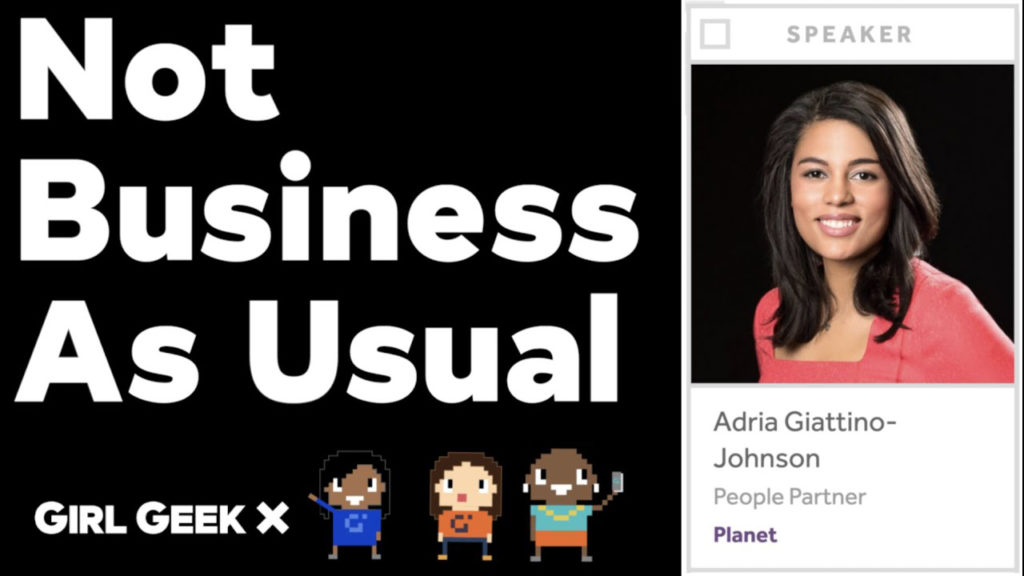
Adria Giattino-Johnson: About Planet, aerospace know how meet Silicon Valley ingenuity. From our spacecraft to our APIs, we engineer our hardware and software to service the largest fleet of earth imaging satellites in orbit and scale our seven plus petabyte imagery archive, growing daily. Planet designs, builds, and launches satellites faster than any company or government in history by using lean, low cost electronics and design iteration. Our Doves, which make up the world’s largest constellation of earth imaging satellites, line scan the planet to image the entire earth daily, which is really cool. We launch new satellites into orbit every three or four months. Most earth imaging companies don’t build their own satellites, but we’re not like most earth imaging companies. Planet designs and builds its satellites in house, allowing us to iterate often and pack the latest technology into our small satellites.
Adria Giattino-Johnson: Complete vertical integration enables us to respond quickly to customer needs and perpetually evolve our technology. Operating one satellite is a challenge, but operating 200 is completely unprecedented. If you haven’t checked out our Ted Talk on YouTube, I highly, highly suggest you do. Planet’s submission is really cool. I’ll dive into a little bit about why I love working at Planet in a little bit, but it really is unprecedented. Our mission control team uses patented automation software to manage our fleet of satellites, allowing just a handful of people to schedule imaging windows, push software into orbit and download images to 45 ground stations throughout the world. Planet processes and delivers imagery quickly and efficiently. We use the Google Cloud platform and enable custom processing so that customers can tap directly into our data the same way we do. Our data pipeline ensures easy web and API access to Planet’s imagery and archive. We make every scene available as a tile service, composite scenes into mosaics, and build time slice mosaics so you can see change over time. That’s a little bit about us.
Adria Giattino-Johnson: I am the first speaker, so I’m just going to dive into my talk. I hope that was a high level overview of Planet. Every person that works at Planet is super passionate about our mission, what we do. I really can say that every time I’m out on the street and I do tell people that I work for Planet, our mission is just so cool, that we build our own satellites and we have daily earth imaging. It really is unprecedented. It’s a really cool place to work.
Adria Giattino-Johnson: On to my talk. I’m the people partner for Planet Federal. I work out of Washington, DC. Planet Federal, it’s the government arm of Planet. We partner with the government. I function as the people partner, which is basically HR. The people partner does function kind of as an HR business partner. Today I’m going to talk about diversity and belonging and the climate that we’re at right now, and how it’s not business as usual. We’re rethinking what diversity and belonging looks like in 2020.
Adria Giattino-Johnson: A little bit about me. I like to use the group identity wheel anytime I do any type of speaking related to diversity and belonging, because I think this is a really good representation, at least for me, the way I like to represent myself and my different group identities. I am a cis gendered woman. My pronouns are she/her. I’m a US national, identify as agnostic. I am a Black, queer lesbian living with disability. I’m a millennial, upper middle class, and I do hold an advanced degree. This framework is really good for me. I think it’s really good for others, just to kind of show places where I’m marginalized and places where different group identities that I am also dominant.
Adria Giattino-Johnson: Let’s jump in. So why I joined Planet. It was an industry jump for me. I had about seven years in human resources. I started as a generalist. I grew into leadership and then I later expanded into consultancy. I’m really passionate about strategic HR and diversity, equity, and inclusion. I began looking for something in the tech industry. I wanted to feel really connected to the mission of the next place that I landed. I was instantly intrigued by Planet and their core values. Why I love working at Planet, and this is what keeps me passionate, keeps me engaged, it’s why I show up to work every day. I love my team. They’re brilliant. I can actually say this globally, across Planet. We just have a really talented group of individuals that work for our company. If we’re at coffee chats or happy hours or whatever you can just listen to people for hours.
Adria Giattino-Johnson: Everyone is just brilliant at what they do, and everyone is so passionate about how they contribute to Planet’s mission. The work that I do is really great for me. It is what I’m passionate about. I get to do that every day. Planet is dedicated to agility and learning, which is something that’s really important to me, especially being in the people department. I love working on the people team because I really enjoy fostering connection and collaboration between teams.
Adria Giattino-Johnson: Let’s dive into the topic today of what I wanted to talk about for this lightning talk, which is diversity and belonging. This year has been a tough year, and I think we’re all in agreement. We face a global pandemic. We’re facing systematic racism and police brutality, political unrest, and let us not forget the murder hornet scare in May. Just in case you did forget, I put a little slide here. It did terrify me, I think, as well as some others. Wanted to add a little bit of levity there. This was an addition to our plates, I think, that we did not need in May. But so let’s dive into the topic for today. We are a nation that’s currently experiencing trauma. Filmed police brutality and racist interactions have flooded our broadcasts as well as social media. It’s something that we’re seeing every day. Many, from all backgrounds and racial identities, have filled the streets in protest to support Black Lives Matter. In response to this, a number of companies have put out statements in solidarity, and it’s forcing many companies, including Planet, to grapple with internal diversity statistics and consequently rethink diversity, equity, and inclusion programs.
Adria Giattino-Johnson: Let’s talk a little bit about statistics. Statistics show that Black employees are left behind. In 2014, Google released their diversity statistics, which many tech companies followed suit after that. But before that it wasn’t something that companies widely released. Statistics over the past six years have shown that despite diversity efforts by most organizations, Black representation remains extremely low with a net change that is almost nonexistent. Statistics do show a slight increase for women in tech, which shows that some diversity efforts are working, but some marginalized groups are still being left behind, which is super important to look at. Let’s look a little bit at the delta for Black employees and tech. So this is a really good representation to just show you over the past five to six years there really hasn’t been a change, despite companies having large funding towards diversity, having diversity programs in place.
Adria Giattino-Johnson: The numbers still remain extremely low. There has been, as I said, an increase for women in tech. It’s been a small increase. There’s still so much room to go, but there has been some strides made there. So just wanted to show a little bit of visual representation of that data. Let’s talk about why diversity efforts are failing. This is what I mean when I’m talking about diversity, quote, unquote business as usual. This is what companies have been doing for decades. Despite a few new bells and whistles that came about in the ’90s, companies have been essentially doubling down on the same approaches that they’ve been doing since the ’60s, which is diversity training to reduce bias. I think many of us have held trainings like that if you’re in people operations, like I am, or maybe you’ve attended a training like that. Hiring tests and performance ratings that limit bias, and putting grievance systems in place for employees to challenge managers.
Adria Giattino-Johnson: These tools are really designed to preempt lawsuits. I think that framework is even in the wording. When we do attend these trainings, it’s very fear-based, I would say. They don’t dive further than that. They don’t dive further to promote equity and inclusion. Now we’re seeing a shift. Employees are demanding change. Companies can no longer operate business as usual in diversity, equity, inclusion, and belonging. Employees don’t want a PR statement from the organization, but rather they want to see a clear action plan related to inclusion and anti racist efforts. This really falls in the wheelhouse of the people team.
Adria Giattino-Johnson: It is an organizational wide effort, but it’s something that I’m proud to be involved in. I wanted to talk a little bit about that today. Moving toward belonging and the new landscape for diversity, equity, inclusion, and belonging. I really, really love this framework and I wanted to make sure I included in this talk. Diversity has no meaning without inclusion and belonging. Diversity is like being invited to the party. Inclusion is being asked to dance and belonging is dancing like no one is watching. Belonging is really being able to show up at work as your true self, and being able to be your authentic self in the workplace. We spend so much time at work that really having this piece where you’re being invited to the party without having these other pieces, it doesn’t mean anything. This is exactly why these diversity efforts are failing.
Adria Giattino-Johnson: I’m not going to dive super into the inclusion framework here, but I did want to include a visual of the sweet spot for inclusion, which is a high level of belongingness and a high value in uniqueness. What that results in is an individual being treated as an insider, and also allowed and encouraged to retain uniqueness within their work group. Let’s talk a little bit about definitions, because a lot of times, I think you can get these trendy words that are happening within diversity or even happening within HR, within people. Belonging can be pegged as a trendy word and it’s really not. I wanted to be explicit about the definitions. Belongingness has to do with whether or not a person is and feels treated as an organizational insider. Uniqueness is measured by the degree to which an individual feels he or she can bring his or her full self to the work without needing to assimilate to cultural norm.
Adria Giattino-Johnson: The degree to which an employee can fully engage, feel safe, and feel connected in the workplace greatly depends on these two categories. And like I said, these can often be left out of diversity programs. So let’s dive a little further into diversity without belonging. Like I said, diversity without belonging inclusion allows marginalized groups into the organization, but then it forces them to fit in to the existing dominant culture. Many Black employees, for example, experience a pass on promotion, noting that they should get to know other managers more, or network more, or connect more. There’s really not explicit definitions in terms of what that really means. For many marginalized groups, Black employees specifically, they report not feeling safe to connect at work and be their authentic self due to cultural difference and fear of bias or repercussions. There’s a real barrier there. Statistics show that attrition rates among Black employees and those of other marginalized groups are much higher. A 2017 report surveyed over 2000 tech employees who left their jobs. It found that many people of color felt that they had unfairly been passed over for promotion, faced stereotyping or bias related to quote unquote fitting in or connecting with others.
Adria Giattino-Johnson: Let’s talk about getting it right. I mean, that’s what I really want to talk about in this talk. When belonging and inclusion are embedded in company culture, it no longer forces employees to fit into the dominant culture, but rather it builds a culture around everyone’s unique identities. Rethinking strategy. Belonging becomes the heartbeat behind an organization’s culture and core values. I’m proud to say that that’s something Planet is working towards and I think that they value. I am the co-lead on the belonging task force. I can really say that that is embedded in Planet’s core values. Without inclusion and belonging, employees do not feel as though they can show up as their authentic self at work, like I said before. This inhibits recruitment, retention, and promotion of marginalized groups, and it also inhibits diverse voices from speaking up and being heard. Let’s talk about creating sustainable change. An internal and external audit is something that must be done.
Adria Giattino-Johnson: Companies, including Planet, must take a long, hard look in the mirror and they must sit with what they see. What are the diversity statistics amongst marginalized groups, specifically Black employees in this climate? What are the attrition rates amongst these groups? How do these systems that organizations have in place contribute to oppression of these groups? Creating a safe space for employees and fostering belonging is also really important. I’m sure a lot of you have heard about employee resource groups, or maybe you’re a member of one.
Adria Giattino-Johnson: They’re a great place to create a safe space for employees to connect. They’ve actually been in effect since 1964, and they were established as a response to anti-black prejudice following the 1964 riots in New York. They’ve continued to be a huge part of the tech community, but companies must really be careful to utilize these groups as a safe space, rather than placing extra burden on them by forcing them to do organizational diversity work and education on top of their jobs. Especially with us being women in tech, sometimes the burden can fall on the marginalized group to do the education, to do the work on top of their jobs. That’s not really the purpose of an employee resource group. It’s to create that safe space, to create belonging, and to create connection. Employers should really watch that and be careful of putting that burden on the employees.
Adria Giattino-Johnson: Looking at the internal and external pipeline of candidates is also really important. Talent and recruitment reform, I think is the biggest part of this. You want to audit your hiring practices, and broadening the schools that you recruit from is really important and including HBCUs, it’s also really important. Recognizing bias against HBCUs and other university programs as being seen as a lower bar is the first step in that. I think that’s something that a lot of tech companies are looking at right now. Also auditing referral programs. So I think referral programs sometimes can fall by the wayside, especially in tech. If a workforce is already homogenous, referrals can further contribute to this as referrals from employees tend to be within their own identity groups.
Adria Giattino-Johnson: I challenge everyone on this video to think about when you’re referring people into your organizations, are you amplifying diverse voices? Who are you referring, or is it homogenous? This is something that even as employees, we can be thinking about when we’re bringing people into our organization.
Adria Giattino-Johnson: Addition of external efforts, and this is something I’m really proud to partner or be involved with Planet. Recognizing the disparity of marginalized groups in tech and committing to investment in community partnerships and education is also huge in creating sustainable change. An example of this is investing money to give black and LatinX students exposure to geospatial and STEM studies and potentially creating an internship pipeline based on such programs.
Adria Giattino-Johnson: The last portion I want to talk about is mentorship programs. I think Angie highlighted, it was either Angie or Amy, highlighted mentorship in the beginning of this. People in senior roles tend to want to mentor and groom people who look like them or remind them of themselves. This is implicit bias. It’s unconscious bias. It’s not on purpose. But this means that people in marginalized groups often do not have someone to advocate for them. Organizations and managers within these organizations, if you’re a people leader on your team, you should be intentional about diversity in mentorship programs rather than leaving it up to senior management.
Adria Giattino-Johnson: The last portion is stamina. This isn’t a checklist. This isn’t a quick fix. This isn’t a measurable ROI. ROI is like always what executives want to hear is if you’re on the operations team or maybe you’re a people leader on your team I’m sure you talk a lot about ROI, building business cases for everything that you want to pass through. But that’s not the case here. This is systemic change that we’re trying to create at the organizational level, which is sustained over years of hard work to see measurable results. Companies must commit to sustainable change over time at every level of the company to value and prioritize diverse and inclusive workforces.
Adria Giattino-Johnson: I’ll end this just by saying, I am so excited to be a part of these efforts at Planet. I look forward so much forward to seeing sustainable change within our company, and I hope that your companies are also working to create sustainable change. I hope that your voices are being heard. This is a really important time for all of our companies, especially within the tech community. I’ll be excited to see what type of change happens within the tech community in years to come. So thank you so much.
Sukrutha Bhadouria: Hi. Thank you so much, Adria. That was wonderful. It was really inspiring for sure for me. We’re going to switch over to our next amazing panelist, Lisa Huang-North. I’m going to do a quick introduction and then we can jump into Lisa. Wow, great background, Lisa! Lisa is a product and program lead at Planet. The team is responsible for delivering product solutions that help customers scale their business. Before joining Planet, Lisa worked for over a decade in strategic consulting, finance, digital marketing, and full stack software engineering. In her free time, you can find Lisa building Lego Technic sets, coaxing her sourdough starter, and dreaming of the day when we can all travel to see friends and family again. Oh my gosh, don’t we all? Welcome, Lisa.
Lisa Huang-North: Thank you very much, and thank you for the intro. Let me share my screen. Hopefully, everyone had a great time listening to Adria’s talk. I’m really excited to be following such a fantastic speaker. Can you all see my screen?
Sukrutha Bhadouria: Mm-hmm (affirmative).
Lisa Huang-North: Hopefully, yes. Okay, wonderful. Yeah. Really today I’m hoping to speak with you around pivoting, and I think especially with 2020, it’s really thrown the spinner. I think a lot of people’s plan, whether that be life plans or career plans and career pivots, there’s never really a good time for it, but it’s even more stressful when there’re uncertainties around that. I’m hoping today I can share three lessons from our satellite operation team and really get you to think around how you can plan for your career pivot.

Lisa Huang-North: To start, let’s see. Here we go. All right. Firstly, about me, I’m currently a product and program lead here at Planet, and I’m also a part of our wonderWomen ERG group that Adria mentioned earlier, [inaudible] taskforce. I call myself a Pivoteur with five career pivots. Prior to COVID shutdown, I loved to travel. Hopefully that’s something that resonate with everyone. And here, I just included a short quote because that was part of what inspired my brief or the talk, was Robert Frost’s poem around traveling or taking the road less traveled.
Lisa Huang-North: The first lesson, what are your areas of interest? A lot of the time for our satellite operation team, the first thing they need to know about tasking on satellite is, where do you want to look, and what do you care about? I will use two use case to try to explain. The first one, perhaps you’re in agriculture. Perhaps you are a farmer, in which case, the area that interests you could be roads. You’re trying to find the roads that will help you travel to your farms versus if you’re a civil government, for example, someone in San Francisco who is doing city planning, the things you care about will probably be buildings or infrastructure, and not so much about the road itself to a farm land area.
Lisa Huang-North: Using these sample lessons similarly for you, when you’re planning your career pivots or career changes, that will be my question to you, what are your areas of interest? That can be an industry, a vertical, perhaps you really tech or you want to try out finance or non-profit. Maybe it’s a skillset that you want to gain along the way, or perhaps it’s really about a national or geographic location, you want to move to the city or you want to be closer to family. So those are interesting points to consider around your area of interest.
Lisa Huang-North: In my case, it was a combination of all of those when I did my first two career pivots, I will say. I started off in Chicago, my career as a mutual fund data analyst. So, that was at Morningstar. And one of the things that I personally felt was really important was a chance to work abroad because I think it’s important to learn about different culture and get a chance to work and live in those places [inaudible 00:39:30] traveler.
Lisa Huang-North: And that’s what brought me to my first opportunity where the company went through a merger and acquisition and I volunteered, interviewed, and ended up moving to Cape Town, South Africa, where I headed up the data operations for our Sub-Saharan African office. And that’s the picture on the left. And after doing that for a couple years, I realized, hey, data analyst is great. I get to learn a lot about data operations and logistics and business analytics, but I really want to do something more creative now. And I love something that’s more customer facing and somewhere where I can work on my marketing or communication skills. So that was my second pivot where I moved and became a food writer. I know, I know a little off course, but it was something fun. I was in my early twenties and for me, it was about the skillset that I wanted to gain and in the immediate format.
Lisa Huang-North: All right, lesson number two, what are your time of interest? A lot of the time for our satellite operation team, they need to know what the targeted time period for our customers, our users will want to see imagery of. Again, going back to the earlier examples, if you’re in agriculture, for example, a farmer. Your time of interest is probably quite seasonal. For example, with this picture, you actually see a lot of the circular fields. That’s what you’ll spot throughout the U.S. And in their case, their time of interest would probably be spring because they’re planning for the growing season and they really need to know what the health of their fields are. However, going back to civil government, if you’re looking at zoning or city planning, or even thinking about where do I want to develop the city, building more infrastructure, building new highways, some of those time of interest could be longer term instead of a season. You’re looking at your own year or even multi-year horizons.
Lisa Huang-North: So think about that when you’re going through a career change or planning for it, what is your time of interest? Are you looking at something that will happen within the next 12 months, two years? And when you do make that leap into your new role, how long do you want to be there? Is there a stepping stone to another bigger career pivot, for example, if you’re moving to a new industry or is it a way for you to grow and really deepen your expertise, for example, within the industry or within the field. And feel free to put your thoughts in the Q and A as well, it’s always fun to make it interactive as you are pondering through these lessons.
Lisa Huang-North: So in my case, I would say while I was becoming a food writer, I fell into digital marketing because a lot of writing and communication are augmented by social media. And from there I discovered one of my passions, which is in public speaking. So for me, my time of interest at the time was really to hone my public speaking skills and communication skills. And one of my capstone projects or goal I set for myself was to speak at the TEDx event. And at the time Cape Town held or organized various TEDx events. There’s ones organized by the university and there’s ones organized by the city itself. And I was able to, again, submit the talk proposal and be selected and really presented. And that was where I had the unique opportunity to meet Archbishop Desmond Tutu, as well. Still one of the highlights in that time of my life.
Lisa Huang-North: And carrying that forward, now my next time of interest was looking at two to three year horizon where I said, “I have my data analytic skills down. I have my creative marketing skills down. What do I want to learn next?” And I really wanted to be able to build a product so that I’m not just talking about it or selling it or analyzing it if I can build the end to end user experience. And that’s where it brought me to my next pivot into a full stack software engineer role. And I went through a coding boot camp where I really learned the full stack where on the backend learning Ruby and on the front end learning JavaScript, using frameworks such as Ember.js and React.js. And that’s the photo you see on the top right. Again, I like to have milestones or capstone project for myself, and for that one, I really wanted to present some fine learnings in the form of a conference talk. And I was able to present at GDG in Madrid, that’s Google Developer Groups, during my travels when I was in Madrid. Think about the time of interest as you pursue your next career change.
Lisa Huang-North: All right, lesson number three, and I think this one is actually one of the most important one. And it’s a reasonable or logical extension coming from area of interest, time of interest, and now what are your success criteria? Using the earlier examples, if we are looking at those as an agricultural farmer. This image on the screen, it’s probably not very successful because I don’t see a lot of farming or agricultural land near San Francisco downtown. Whereas if the photo was of [inaudible] with garlic farming or even of Napa Valley with the wine industry there, that probably makes a lot more sense and that image will be successful, right?
Lisa Huang-North: But again, going back to city, if you are San Francisco government and you’re doing city zoning and infrastructure development, this image is probably perfect for your use case. You’re able to see downtown, you’re able to see Embarcadero. And in fact, you can even see Presidio on the top and the bridge, The Golden Gate Bridge. And even with Karl the Fog, the clouds, we’re always looking up for cloud covers at Planet, even though the cloud obfuscate the left side of the city, you really get to see 90% of the city.
Lisa Huang-North: So this image for civil government will be successful. So link in to that, what are the factors for your success criteria? Is it about the job, the scope of the role, maybe it’s about salary because you’re at the time of your life where you need to provide for your family and financial stability is key. Or perhaps if you’re younger and earlier in your career journey and for you, personal growth and learning is the key factor for your success criteria. So think about that as you’re planning your career change and planning for the next pivot.
Lisa Huang-North: In my case, I would say that through those different career changes, initially the success criterias were pretty immediate. Which are, what skills can I learn? And am I having fun with it? Am I having fun while I’m changing these different jobs or learning new things? And I would say on the top left, this was at a friend’s wedding in Durban, South Africa. And for me at the time, the social aspect was a huge thing, too. I really wanted to meet people. I wanted to experience different cultures and those, my lifestyle choices, were integral pieces to my success criteria beyond professional growth.
Lisa Huang-North: And slowly as I moved back to the U.S., I would say that my success criteria has changed over time. And now, instead of just focusing on perhaps immediate and personal gains, I’m really looking at how I can integrate or how I can be closer to families and what that means for my lifestyle and what I want in the longterm, starting a family, for example, mentoring other women in tech. And that’s how I’ve been involved in Women in Product and Tech Ladies. And in some ways, still trying to get connected with my roots from when I ran the startup by attending startup conferences and just keeping fingers on the pulse about what’s happening in the startup space. So that was really key shift from personal growth lifestyle to professional, family, as well as any mentorship impact.
Lisa Huang-North: And that ultimately was what brought me to Planet. I think, as Adria mentioned, a lot of us here at Planet, we are fully aligned with Planet’s mission. And one of the success criteria for me when I went through the latest round of job search was around impact. I really wanted to join a company where I myself can be contributing to something that is impactful at the global scale. And really, Planet way surpassed that and some more because I would say beyond global, this is really a planetary and specie level. And I think hopefully with the use case I have shared, you can see how it impacts industries at the time. And I’m sure some of the speakers later will share even more interesting story such as forestry or crisis management. And you’ll get to hear a lot more. So take this time in the question Q and A area, if you can think about what your success criteria are, start sharing that with us.
Lisa Huang-North: So finally, savor the journey. I think bringing back the three lessons about area of interest, time of interest, and your success criteria, another thing to remember is that while we are in the midst of career change or any pivot, the uncertainties are probably quite stressful. And you may feel like you don’t really know where you’re going, or if you are going to be able to attain the goals that you have set out for yourself. But as a famous saying go, hindsight is always 20/20. And while you’re in it, you may feel like you’re going through a rough divergence, snaking around from place to place. And it doesn’t feel like a linear path, but looking back, or if you zoom out and take a bird’s eye view, you’ll probably realize that you’ve made something beautiful and you have created this fantastic journey for yourself, where all those different skills and experience you pick up along the way were pieces of the puzzle. And ultimately when you piece all of them together, they look really stunning.
Lisa Huang-North: So I hope that will help to lessen some of the stress, anxiety you’re feeling as you put it through these uncertain times. And to close, obviously, if you have any questions, feel free to reach out and let’s chat. You can connect with me on Twitter, on LinkedIn. I will be here for the networking event later on as well. So definitely reach out and we are hiring. So always happy to chat about Planet. Thank you.
Angie Chang: Thank you, Lisa. We are running a little behind, so we’re going to skip the Q&A but feel free to ask the questions and we will ask Lisa and we will share them later in a blog post with everyone. But right now our next speaker is Sara. And we’ll bring her right up. Hey, Sara.
Sara Safavi: Hey, how’s it going?
Angie Chang: Good. How are you?
Sara Safavi: All right.
Angie Chang: So… you can get your slides…
Sara Safavi: Mm-hmm (affirmative).
Angie Chang: Perfect. So Sara, by means of intro and [inaudible]. She leads the developer relations team at Planet Labs. Welcome, Sara.
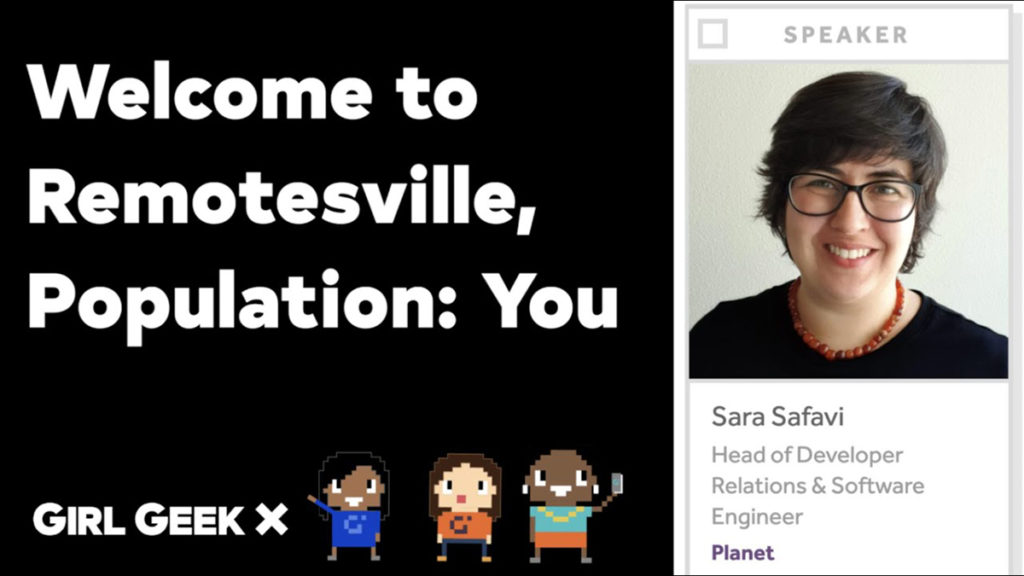
Sara Safavi: Thank you. All right. So yes, I will get started. Like Angie said, I lead the DevRel team here at Planet Labs. And what I want to talk to you all about today is my experience working remote. I’ve been working remotely, both here at Planet and prior to Planet for about five or six years. So about three years here at Planet and then a couple different companies before. Along the way, I’ve had to pick up some new habits, some new practices and ways of working in order to make my stay in Remotesville as a remote employee sustainable.
Sara Safavi: Tonight, I just wanted to share some of those tips with you and go through them really quick. I want to give you a starting point, not so much teach you everything, but a starting point you can reference if you’re also somewhere at the beginning of this journey. I know a lot of us are, especially in the last couple of months, so it’s a topic that we’ve all been talking about. And this, if you ask somebody for their one tip for working remotely, this one is probably what you’ll hear most of, establish a routine, make sure you have a routine.
Sara Safavi: I’m putting this first because it is so common that you’ll hear it. I have a couple of things I’ll mention after this less common, but I do think that this is important. But something important to notice here is that we’re new because I’m talking about establishing a new routine. You need to develop some new routine that works for you because this isn’t the same as your pre-Remotesville routine. Your life is no longer in the same patterns. You’re not going to get up in the morning and pack a lunch, probably. You’re not going to get into your car, stop at the gas station on the way. You probably not even going to put your shoes on in the morning.
Sara Safavi: So it’s completely different scenario, which means it’s going to take a different routine. But routines are still important because our brains can be stupid. And we want to trick them. A routine helps you trick your brain into understanding that we’re getting ready for work, we’re going to work, we’re no longer sitting at home in bed, it’s not the weekend, it’s still a weekday. So taking that time to get dressed in the morning, do your hair, put on something that makes you feel powerful and professional. It really helps separate that situation in your head between home and work.
Sara Safavi: So build a morning routine that takes care of you. Maybe do some yoga, meditate, go for a run, whatever it takes to establish that new routine. But some other things that people don’t necessarily talk about, a friend of mine shared this concept with me a couple of months ago, and I really love it. So I had to stick it in here. Teach yourself and give yourself permission to put your body first. What I really mean by this is a lot of times when we’re working solo at home, it can become really easy to just stop listening to our body’s needs. If we’re not changing what we’re doing or interacting with other people, if we’re just sitting at our desks for eight hours a day with a cat or a dog sitting under the desk, then you can really start ignoring your own body’s needs.
Sara Safavi: So if you catch yourself feeling out of sorts or not able to get into that workflow like you usually do, or just feeling like something’s wrong, or you keep beating your head against the same bug for 10 minutes, take a minute and check in with yourself. See if there’s some body’s needs that you’ve been ignoring. Did you skip lunch? Have you not stood up from your desk for four hours? Since you don’t have like a water cooler to walk towards, maybe you forgot to get a drink of water, hydration is important. But just take a moment, check in with yourself because a lot of times, the ways that we’re feeling are actually directly related to ignoring what our body’s asking for.
Sara Safavi: And similarly, talking about stepping away from your desk, when you’re working remotely, you really have to make space for scene changes. If you’re in an office, many times a day, you’re going to get up, you’re going to go to a conference room, you’re going to go visit your coworker’s desk, you’re going to go to somebody else’s desk and ask to see what they’re working on. You’ve got all these opportunities to change your scene, but when you’re working at home, you don’t have those opportunities anymore. So you have to deliberately make space for them. Schedule them into your daily routine. Maybe you’re going to take your dog for a walk for a half hour every afternoon. Put that on your work calendar. Or maybe every Monday morning, you water all your plants, put that on your calendar. Put dancing breaks on your calendar, I have friends that do that and I love it. You’re working remotely though, your schedule can be flexible, maybe you can do a yoga class at 1:00 PM. Maybe you have the freedom to do that, but you have to deliberately seek out those opportunities to change your scene.
Sara Safavi: Similarly, you have to seek out connection. You really have to rethink what it means to make connection. If you’re working remotely, like I said, you don’t have those coworkers desks to walk to. You don’t have a water cooler. You don’t have a break room to go make a cup of coffee or grab your lunch and heat it up. You don’t have those natural opportunities for connection. So as a Remotesville citizen, you need to be deliberate and intentional about this. Instead of just telling a coworker on Slack, “Hey, we should get coffee sometime,” you should send them a calendar invite for 2:00 PM on Wednesday and say, “Hey, I’m going to be on Zoom, having coffee. Let’s chat.” Make it an intentional and easy way for them to accept and say, “Yeah, let’s connect.”
Sara Safavi: Find opportunities to network. Find a network of other people working remotely, whether it’s at your current company or friends that you know who are in different companies. And if you don’t have a network already and you can’t find one, maybe that’s a perfect time for you to make your own. Something that’s really great that we overlook in remote work is coworking. It can be really great to just cowork with somebody. And I don’t mean an active Zoom chat, like a coffee break, where you’re talking back and forth, but maybe you just open a video call with a coworker and you guys just sit there in silence doing your own work together. It’s really companionable.
Sara Safavi: So rethinking what we mean when we’re thinking about human connection and then being deliberate and intentional about it, is what’s going to make that remote work environment more sustainable. Something to watch for is to be aware about the creeping attraction of home comforts. So if you’re working in Remotesville, you’ve got a comfy couch, you’ve got a comfy bed, you’ve got all of the comforts of home, but I strongly recommend that you don’t work from your bed.
Sara Safavi: So I know Deanna is going to talk to us later about satellite operations from bed, and I totally fully endorse it. I think that’s awesome. But what I mean when I say don’t work from bed is, don’t make this your normal Monday to Friday, nine to five office space. Like I said, brains are stupid. You need to trick your brain into understanding home versus workspace. You have to use sensory cues to signal that difference. You have to let yourself close an office door at the end of the day. So maybe you don’t actually have an office at your house, but maybe you have to mentally be able to close that door.
Sara Safavi: If you’re working from your bed all day, it’s super comfortable. It’s awesome. Maybe you’re even really productive, but then the problem comes when it’s time to go to bed and you want to sleep, but your brain is like, “Oh, this is where I’ve been working all day.” So you start thinking about work again, and your brain starts turning the last problem you’re working on over in your head. And it’s really difficult to have that isolation. So maybe at home, you don’t have a lot of space, maybe you’re working from your dining table. That was me for the first two years of my remote career. But something you could do is put a lamp on that table and turn that lamp on only when you’re working. And when you’re done working, the lamp’s off. Little stuff like that, those sensory cues can really make a difference in being able to mentally close that office door.
Sara Safavi: I’ve given you a lot of advice and I do want you to remember, these are interesting times where we’re living through right now. This isn’t the normal time that you would be switching to working remote in tech. So give yourself permission to practice a little self compassion and be kind to yourself, but also be honest because compassion doesn’t mean lying to yourself. So if you forget to step away from your desk for eight hours, or maybe you fail to put anything besides coffee and LaCroix in your body since 8:00 AM today, it’s okay. But it’s important to be honest and name that and understand that it happened and then just try again tomorrow. You understand that it’s important to listen to your body, to stay hydrated, to take those opportunities for scene change, and just try again tomorrow.
Sara Safavi: So try to create a routine that works for you. A new routine. You’re not going to make your old routine work here. Take breaks. Remember to move around. Listen to your body and brain’s needs. Intentionally seek out human connection and make invitations to people that are easy to act upon that are not passive. And don’t let comfort creep overtake you. Try not to work from bed all day every day. Don’t ignore your body and your brain’s needs. Don’t skip meals. It’s okay to take a break and step away from your desk, but above all, don’t be too hard on yourself.
Sara Safavi: So I don’t know if we have time for Q?A. I would love to take questions if I can, but otherwise that’s my contact info. I would love to hear from any and all of you.
Sukrutha Bhadouria: That was great. Thank you so much. We’re definitely going to take questions later, like Angie mentioned, but thank you so much. All right, next up… Barb is a software engineering manager and developer on the applications team at Planet. Take it away, Barb. Welcome.
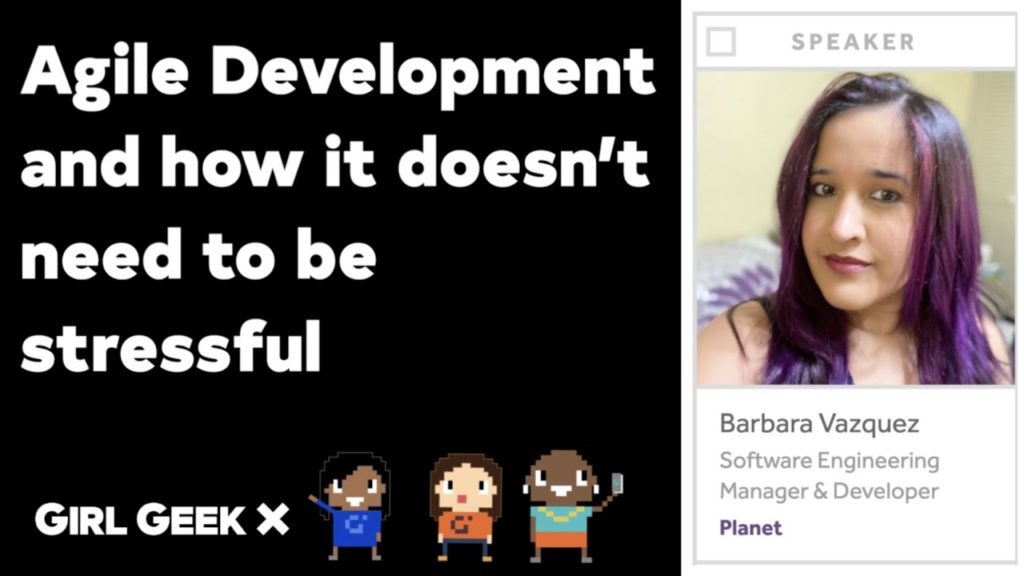
Barbara Vazquez: Thank you. Hey, everybody. My name is Barbara Vasquez. I go by Barb and I’m a software engineering manager and developer, as well, at Planet. A little bit about myself, I was born and raised in Puerto Rico. I have been working in the geospatial industry as a software engineer since 2008, when I moved to the DC area. And I have been living right now, I’m in Maryland, but I’ve been in the DC area since then. I joined planet about three years ago in 2017. And I’m part of the web applications team. We build some of the tools that help people have easier access toward data.
Barbara Vazquez: The main thing that, if you’re familiar with Planet, is an application called Planet Explorer. If not, go check it out, planet.com Explorer. Now what I’m going to talk about today, it’s about Agile Development and estimation. It’s mostly focused because I’m a software engineer and we do Agile Development at Planet. And these are some tips and things that might be useful for people doing Agile. Even if you’re not doing Agile, thinking about estimation and how much something will take you to do is useful on a day to day. But with further ado, if you’ve done Agile Development and you do the daily scrums or the daily meetings, you’ve had these thoughts, what are points?
Barbara Vazquez: Why are people asking me so many questions so many times, when will it be done? Why do I have to give status every day? And it can get tiresome. And you might just want to flip the table and say, this is not what I signed up for. This is not why I want to do software engineering. But through the years, I’ve learned that it can work in your favor. It can actually help you be more organized and communicate better, to have less stress.
Barbara Vazquez: So estimating with points, if you’re not familiar with Agile or Points. Points is a system that tells people, mostly managers, how difficult do you think a thing is and how long it will take you. But in my perspective, yes, that’s one benefit, to tell your manager when things will get done, but it will help you be honest with yourself.
Barbara Vazquez: Can I really do this? Is two weeks enough? Or however long you have to develop something. That doing the mental exercise will get you in a better spot where you might not need to pull all nighters. If you have to work weekends to meet your deliverables, you’re probably signing up for too much. Or you might be underestimating what is being asked from you.
Barbara Vazquez: In Agile, the way it works, you sign up for work and you have X weeks to do something. I’ll use our example. We do two weeks of development. If after those two weeks, every time you’re rolling over things, rolling over means that you did not complete it. That means something is wrong in the process. It’s not necessarily you. It’s a team thing. It’s being underestimated.
Barbara Vazquez: Scope creep happens. You’re midway. You’re almost done. And then somebody is like, did you think about this? What about you do that? And you go on a tangent and you forget about your original goalpost, or the biggest one that nobody wants to admit is you probably don’t have enough information, but how do you tell your manager that you don’t have enough information?
Barbara Vazquez: Shouldn’t you be able to do it on your own? Not really. That’s what the whole point of Agile and team development should be. And points are there to help you communicate that.
Barbara Vazquez: How to start doing better estimates. One thing I do with my team is ignore numbers. Just give me T-shirt sizes, small, medium, large, or extra large. Extra large, can I do this in two weeks? If it’s an extra large, no. It probably needs to be broken apart. You probably need to talk more about it. A large size, will probably take me the two weeks. I’m threading there on borderline not completing it, but let’s give it a shot and let’s see how it goes. Medium, I can get this done. I don’t know how long it will take me. It’s definitely going to be more than a day but I can get it done. And small is I can do this with my eyes closed. It doesn’t matter.
Barbara Vazquez: That’s my rule of thumb. When I go to do estimates, it’s give me a sense, how do you feel this is so that we can have that conversation of how long it will take. As soon as you do this mental exercise, you’ll get in a better habit and you’ll start recognizing better. I don’t have enough information or this is super easy. Why am I even thinking about it? Let’s get it done.
Barbara Vazquez: So once you get the T-shirt sizes down, you can map this to whatever point system your team uses if that’s the preferred methodology. A lot of people use the Fibonacci sequence where it’s one, two, three, five, up to 13, where a 13 is the extra large equivalent.
Barbara Vazquez: So this once you get used to, and you’re like being able to do t-shirt sizes, you can move up to doing the point systems. In any case, even if you don’t do Agile, thinking about your tasks in t-shirt sizes can help you think about difficulty, can help you keep yourself organized and just do that mental exercise of what do you need to get done that week?
Barbara Vazquez: The other point, two points, no pun intended, is keeping your other responsibilities. Add some buffer. You might be able to sign up, just keeping with the example, two medium things, because life happens. Add some buffer, COVID has taught us that life is unpredictable and your normal cadence is not the same anymore. Distractions happen, you might have family at home. Take that into consideration as well when you’re doing these estimates.
Barbara Vazquez: And the other point, the other thing to think about with points is it helps you negotiate. It helps you make sure priorities are clear of what needs to be done first versus what needs to be done later. If your plate is full, whether it’s with actual tasking, if it’s with life, use the points to help you drive conversations. I can only do so many mediums stories. If I sign up for one more, I will definitely roll it over because that’s what I’ve learned.
Barbara Vazquez: And in the end, having slightly more predictable cadence is valuable for everybody. And again, I say slightly because life happens and we cannot be 100% predictable, but we can get there. And that’s all I have. Thank you everybody. I know we don’t have time for Q and A, but that’s my email, barb@planet.com. If you want to reach out or we can talk later.
Angie Chang: Awesome. Thank you, Barb. That was really great. I’m going to find Kelsey. Video, it’s perfect. Great. We can see you. So Kelsey is a space systems engineer at Planet. Welcome, Kelsey.
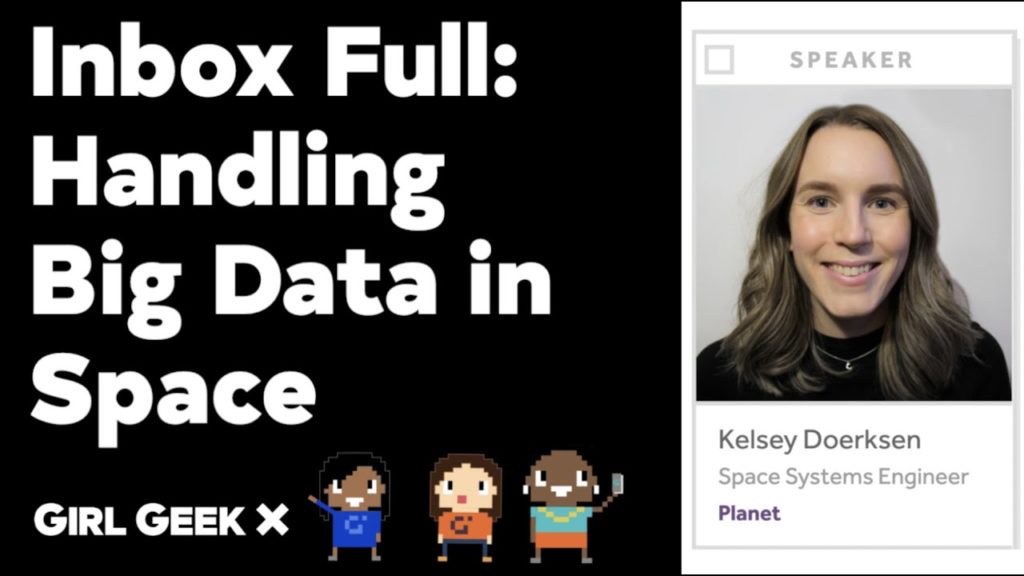
Kelsey Doerksen: Thank you. Perfect. So good evening, everyone. My name is Kelsey Doerksen and I am a space systems engineer at Planet. I started about four weeks before work from home was an order for the San Francisco office. So I got only a little taste of what it was like to work in the physical San Francisco office, but I’m really happy with my past five months being a part of the team.
Kelsey Doerksen: And today I’m going to be talking a little bit about how to handle big data in space and the different machine learning projects I’ve been a part of over the past few years. And so I’m just going to jump right into it. So first I wanted to start off with what is machine learning and what do I really mean by big data?
Kelsey Doerksen: So big data is really just that, it’s a large volume of data or a lot of data. And we use machine learning with this big data to seek statistical patterns, to enable computers and algorithms to make either a classification, such as differing between pictures of dogs and cats, or prediction about the data.
Kelsey Doerksen: I really like this three step image here that basically breaks down what machine learning is really at a high level, where you start with this big conglomerate of data, you can’t really make sense of it or extract any meaningful information from it. You apply analytics to it. And in this case it would be a machine learning algorithm. And from those analytics, you’re able to make informed decisions about the data in question.
Kelsey Doerksen: I’m going to be talking about three different projects I’ve worked on at a very high level. Don’t be worried if you don’t know anything about machine learning. And I’m going to start off with my first project I worked on, which has to do with machine learning on Mars.
Kelsey Doerksen: For those of you who are unfamiliar with the Mars exploration Rover mission, this was a NASA mission that launched in 2003, and it sent two twin Mars rovers, Spirit and Opportunity, to the surface of Mars. Unfortunately for the Spirit Rover, its wheel actually got stuck in the Martian soil. You can see in that black and white gif image there that is taken from the Spirit Rover itself. And unfortunately the mission was lost in 2010 for the Spirit Rover because its wheel was stuck in the sand and they weren’t able to get it free.
Kelsey Doerksen: How could we have used machine learning in order to prevent this from happening for future Mars Rover missions? As we know, Perseverance is launching, hopefully soon, barring any delays. This is a project I worked on at the NASA jet propulsion lab called the Barefoot Rover project. Essentially what the Barefoot Rover project purpose was, was to use what is physically felt by the Mars Rover wheels, to be able to detect different things about the surface it was rolling across of.
Kelsey Doerksen: My work was specific to making sure the wheels were not slipping or sinking into the different types of sand material we had at the JPL campus. And it was also, I worked on the terrain classification and detecting if there’s any subsurface rocks that could possibly penetrate the wheel and cause damage to the wheels.
Kelsey Doerksen: How this worked from a machine learning perspective at a very high level, essentially what we had was a yellow pressure pad wrapped around the outside of the Mars Rover wheel. And we took those pressure pad readings and trained that in a classifier to be able to detect these things that are on the bottom of the slide there. So we were able to tell the hydration content of the soil, anomaly detection, safety, and stability of the Rover, slip and sinkage, which is what I worked on, terrain classification, rock detection, and other different tear mechanical properties.
Kelsey Doerksen: This is a really cool project I worked on and it’s going to be implemented on future Mars Rover missions. The second project I’ll talk about is machine learning for the sun and for our Earth atmosphere. So this very terrifying image you see on the slide here is a picture of a Coronal Mass Ejection event. What a Coronal Mass Ejection event is, is a huge explosion on the surface of the sun.
Kelsey Doerksen: And essentially what happens is these huge explosions send out high energy particles into space. You can see there, Earth is to scale in terms of the size of a Coronal Mass Ejection and the sun as compared to the size of our Earth. The distance is not to scale, but the size of the two planetary bodies is. So why this is of concern other than the fear that it strikes of course from this image, don’t worry. It’s not going to cause any … The flames will not reach our surface. But what they do do is send these high energy particles to our Earth’s atmosphere that essentially push our satellites around. So from a satellite operator perspective, the satellites can actually be moved off of their orbit path and collide with other objects in space, which is obviously really detrimental to the satellite operators.
Kelsey Doerksen: How can we use machine learning to tackle this sort of problem? Well, we can’t stop these Coronal Mass Ejection events from happening, pictured there is a gif image from the Soho telescope that is showing what a Coronal Mass Ejection looks like. So we can’t stop these huge events from happening, but we can at least try to learn as much as possible about them and how they are affecting our satellite. And this was my master’s thesis work using the satellite accelerometer data to detect these solar storms. So I mentioned before that these solar storms send out huge amounts of high energy particles and they reach our Earth’s atmosphere. The way you can think about this is if you’re walking outside and it’s very, very windy and you’re getting blown back by the wind, that’s kind of is what’s happening to our satellites when these particles reach our atmosphere.
Kelsey Doerksen: And that can be captured in the satellite acceleration data. The two graphs I have pictured on the slide here, the top graph, it shows the acceleration of the satellite when there’s solar storm happening. So you can see the signal is quite erratic and it’s actually doubles and above in the linear acceleration of the satellite itself. Whereas during a period, when there is no sort of solar storm, the satellite is very periodic and the signal isn’t fluctuating at any alarming rates.
Kelsey Doerksen: The last project I worked on and want to introduce is, of course, using Planet data, and this is machine learning for our Earth. So I’m really happy to be a part of the new partnership with the Frontier Development Lab and Planet, which is an eight week research sprint with the NASA and SETI Institute, and Planet is working with the Waters of the United States team, which is using Planet’s daily imagery with machine learning, to assist with drought detection and prediction in small streams in the continental United States.
Kelsey Doerksen: Pictured here is the Seminole reservoir in Wyoming, United States. And the first signs of droughts can be identified in the small streams that branch off of large bodies of water like these. So by comparing pixel values in these streams using Planet’s daily imagery of sites, similar to this, the team of researchers will be able to detect and predict future droughts across America with the aim to scale this work to other areas across the globe.
Kelsey Doerksen: I can’t get to my … There we go. I really hope you were interested and able to follow along with those three different projects I worked on. I think machine learning, it’s such a new and growing field and space is the perfect application for machine learning because we have so much data. And if you have any questions, you can feel free to reach out to me, and thanks very much for your time.
Sukrutha Bhadouria: That was excellent. Kelsey, are you seeing the comments? Awesome, Kelsey [crosstalk].
Kelsey Doerksen: I can’t see them, but thanks a lot.
Sukrutha Bhadouria: Someone said I want to be all the speakers. That was just amazing. I learned so much. So moving on to our next speaker, Deanna. Deanna leads the team at Planet responsible for operating and maintaining the over a hundred imaging satellites, or Doves, currently on orbit. Welcome, Deanna.
Deanna Farago: Thank you. I’m so happy to be here. This is my first Girl Geek event. I’m excited also just to hear from other Planeteers because, sadly, it’s a large enough company that you don’t automatically know everyone. I love hearing everyone else’s stories, as well. All right, so I will present. Hopefully everyone can see that okay.
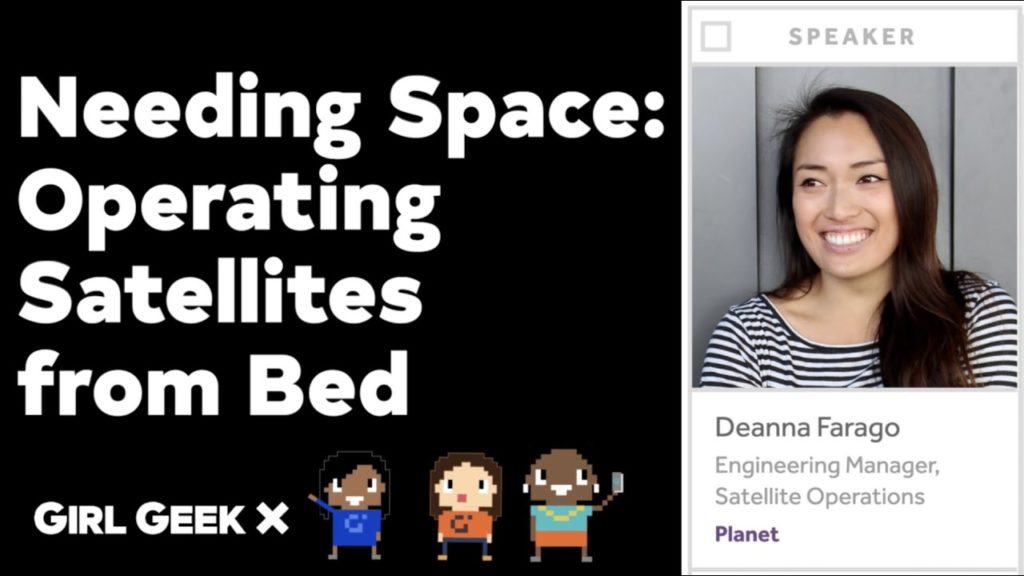
Deanna Farago: All right, as I mentioned, my name is Deanna Farago and my team and I operate a fleet of satellites that are currently imaging the entire planet every day. And, traditionally, satellite operations can be very time and resource intensive. For example, in order to operate one spacecraft, you could have a room full of engineers around the clock, 24/7 monitoring, telemetry and contacts, and just system performance.
Deanna Farago: And our satellites operate in a different paradigm and risk posture. This has allowed us to be able to automate a lot of the operations. Even before COVID, we could operate essentially anywhere as long as we had a good internet connection and our laptop. Before I describe what that looks like, it’s important to understand what the mission is and the scale of our operations.
Deanna Farago: Our company’s mission one is to image the entire planet every day. And you need a lot of satellites in order to do that. And we actually, in addition to operating satellites, we design, build, and test all of our satellites in house. And this is a big advantage for us as operators, because if and when we run into issues on orbit, we can work directly with the engineers that designed the satellite in order to troubleshoot the problems and help come up with on orbit mitigations, as well as design out these bugs/features in the next spacecraft iteration.
Deanna Farago: And then once in space, we use just a little bit of atmosphere that we have to use something called differential drag to space out the satellites over time. And as one satellite images over a strip of land, the one right after it should image this strip of land, just adjacent to it. And this essentially creates alliance scanner. What you’re seeing here is a 24 hour snapshot of what the imaging strips could look like that the satellites are capturing. And we have a distributed team operating our satellites. We have four people in San Francisco, one person in Toronto, and a team of four in Berlin. And we send tasks to the ground stations, which then send the schedules up to the satellites. And just a fun fact for this group that at Planet, we have three satellite operations teams and they’re all managed by women.
Deanna Farago: The concept of operations is actually quite simple for these Doves. We don’t image over the ocean. We only image over the land, but basically anytime they’re overland, they just point down, take pictures. If they’re over ground stations, we downlink those pictures in logs and we communicate with them. And then in the background we’ll just run maintenance activities, essentially thinking of them as like tuneups and checking in on like subsystems and keeping an eye on any degradation that might be happening or running experiments. And, in theory, if the satellites are performing well, they should just be as easy as this man’s rotisserie grill, where we just set it and forget it. We can even run it custom experiments, and we set up the tasks and not have to worry about it.
Deanna Farago: However, things don’t always go smooth. There’s a lot of fires that can happen. And that’s kind of how we know we’ll never really be able to automate ourselves out of a job. These are just some examples of issues that we’ve seen on our satellites. So a satellite suddenly starts spinning up, and we have to figure out why is it spinning up? And we need to de tumble it. We noticed that the satellites have low battery, that’s voltage, and we need to take action before they start browning out and rebooting rapidly. We see that telemetry sensors are reading zero value. Is this a real thing? Or is the sensor it just being faulty? And we have to reset it. Or sometimes satellites just are unresponsive out of the blue and we have to spend time to figure out, did something change, did something break on the satellite?
Deanna Farago: Or can we just set up some automation to keep an eye on it? And all of these actions started out as manual. We would detect these problems and then operators would spend time triaging it and then eventually taking action. And now our teams have automated responses to all of these so that they trigger off of just telemetry on the satellite. As soon our automation sees like the driver readings are reading up. Then we know the … Sorry, the robot just basically sends a task to respond to this, so an operator doesn’t actually have to. And this decreases latency in the system and gets the satellite back into production as quickly as possible. And there’s always going to be unknown unknowns, and we’re constantly trying to find these new problems and automating responses to it.
Deanna Farago: What does a day in the life of an operator? Well, we work nine to five and we have a checklist that we rotate among the team members. This enables our team to be able to have weekend or holiday coverage. Even though we’re working normal office hours, we want to make sure that there’s always going to be satellite operators, eyes on the system every day. And for this number of satellites, we have to aggregate our data. Aggregating our data is key. What that means is we build lots of dashboards based off of our telemetry, and off of our logs from the satellite. And it allows us to be able to easily see if there’s any satellites that are responding and acting out of family. And that will then trigger an operator to say this one’s not behaving the same as its fellow satellites. I’m going to dig in further and try to triage it.
Deanna Farago: We have weekday team standups and we’re supported by amazing other teams in mission control. And those teams also have their own on-call. And so if something does break in the middle of the night, that affects the whole fleet. Those teams help support us. I wanted to show this because it’s one of my favorite things that we’ve taken a picture of at Planet. And it’s actually a series of pictures that we stitched together into a video. And just before a rocket launch, we’re able to opportunistically schedule a Dove to take a series of images of a rocket delivering more Doves to space. Just a real quick cool shot. And that’s shot by one of our satellites. So very cool. And then sadly, we won’t be doing any missed high fives and hugs and mission control in person anytime soon, like our former coworker here Rob Zimmerman. But we can still enjoy having first contacts and commissioning with one another virtually. And this is our, I guess, equivalent version of that from a few years ago when we were able to successfully make contact with 88 satellites right after launch. And with that, that’s all I really wanted to share. I couldn’t go into too much detail, but I’m happy to answer questions. If you’d like to email me. I am at deanna@planet.com. Thank you for having me.
Angie Chang: Thank you, Deanna. That’s really awesome. And you … Let’s see. And now we are going to bring up Elena, who has over two decades of experience in sales and she’ll be telling us her journey.

Elena Rodriguez: Excellent. Good evening, everyone. I’m so happy for this invitation. I just joined Planet three months ago and I really wanted to talk about … sorry, this is my first time, I wanted to talk about the adventure of making a decision, how important it is for our career. But first, let me introduce what I do here at Planet.
Elena Rodriguez: As I said, I joined the company three months ago, I’m this salesperson for Mexico, Central America, Ecuador, and the Caribbean. I have been in the business for more than 20 years, and I am so, so honored to be part of the Planet team. I’m so happy and so proud of working for the company that is offering solutions that are critical to mitigate some of the main challenges that we are facing right now, like climate change, food crisis, fighting poverty, so many applications, and I feel so proud to talk about our business when I go out there and meet my clients and listeners. So I chose a topic because this is something that I’ve been always thinking about it. And now I have the opportunity to talk about it. And I’m going to take advantage of this — is how I ended up here. I want to show you my story.
Elena Rodriguez: Ever since I started back in the 80s, I have all the dreams like I wanted to be a fashion designer, because that’s something that I really enjoy since I was a little girl. And I took … but it was difficult for me because fashion was a very expensive career in Venezuela, and I had a scholarship, and I moved to Seattle from Venezuela to study sales and advertising. I have no choice. So let me tell you that, that was the first time I didn’t make any decisions.
Elena Rodriguez: I had to choose what I thought was available for me that time. So I remember my sales teacher, Mr. Fine, it’s impossible to forget him. That he was always saying that a good sales person is capable of selling anything anything. Selling water to a fish. I wasn’t growing that idea of on my mind, but I was thinking, I don’t know if I’m really right for this career, sales is like — I don’t know — However, I was already thinking like when I was a little girl, I was drawing paper dolls and I was selling those to my friends at school. I was making bracelets with the colorful telephone wires, and I was selling those. I was a sales person already!
Elena Rodriguez: I went back to Venezuela and I graduated, but I was still thinking, I don’t know what I want to do, this is my passion. I want to be a fashion designer. And it took me four years to graduate. It was the beginning of this career in Venezuela. And it was a lot of work. It was very expensive. There were times that I couldn’t sleep, doing all the drawings, the designs, and making all these dresses, this yellow one, and the one along here, I made them. And I was so inspired, because that’s exactly what I wanted to do.
Elena Rodriguez: But then something funny happened during this practice — is that every time my friends called me and asked me for a dress, because they chose the fabrics, I have my [inaudible] they chose what they liked. And I made the dresses. Then when they came home to pick them up, I didn’t want to sell them! I was like no, I keep them. So I decided that’s not for me.
Elena Rodriguez: It took me a while and I was thinking, you know [inaudible] what am I going to do? We are almost through this and I need to make a decision. I needeed to plan because I had a strong pressure from society, my country, and I made a decision — I thought it was time for me to have a family. And that was a decision that really, I thought about it a lot, because I know what it meant for me at the time — that I had to give up some things that were important for some time.
Elena Rodriguez: But those changes, I always ask myself — once I start with passion to adapt to a new reality, because I had that question on my mind. And the answer is definitely no, I was just growing up. And it was time for me to make that decision and get prepared and be responsible for the decision that I have made.
Elena Rodriguez: In 1995, it was a huge revolution in Venezuela because that’s when Internet arrived to our country. It was the time also when my boy was born, he’s 25 right now. And I remember I was taking care of my son and I was hearing all this noise outside — my husband and his friends talking about Internet — let’s go, let’s navigate, let’s check — They were looking for some topics and they were celebrating and I was feeding my baby and I was thinking, Oh my gosh, I think I’m losing something, something’s happening here, and I don’t know, I don’t want to sound selfish, but I had that on my mind. You know, so what am I going to do with technology, but I don’t know if I can even think about that! Would I ever touch a computer again? I had all these questions at that time. [inaudible] years things turn to be kind of difficult in my country. And I had to work. I had to live outside definitely my [inaudible]. And I had to go outside and find a different job, something because I needed to bring money to… because I had a family and things were difficult, and I was ready to get back on track, but I wasn’t ready for the technology. I had missed one year of all these changes! So selling was becoming more challenging, new terminologies, services, a new way of communicating… communication skills.
Elena Rodriguez: The first job I got out there was for selling ads for the magazine called Computerworld with names like Microsoft, Sun Microsystems, IBM, HP, and those that were never familiar to me — it started to be new and that was nice — I was into a completely different world. This job was the one that allowed me to meet the people that helped me, that guided me, that inspired me to be in this field. And to be honest, selling was never had never been so much gratifying for me.
Elena Rodriguez: Five years later, I had to make a very difficult decision that by the way, this week when I was practicing this presentation I found out how, I mean, how your country, your family, your culture really touched you. And I was like, I didn’t realize before, it’s like I was keeping that into myself, but it was a big decision. It wasn’t something that I was prepared for, but that was the time where the political situation in my country was unsustainable and started to be not sustainable even worse. I had a job offer in Mexico and I didn’t think twice. I moved here. And as you can see, the picture was… I think that was my first week here in Mexico. And you can see all the disaster. And remember I was asking if I would ever touch a computer again.
Elena Rodriguez: Well, here is a computer, but I was only able to touch it because it was impossible to carry, so heavy. Everything has been changed as we know, that’s funny. So that’s when I started. It was like, for me, that was my own revolution, geospatial, learning new terminologies. It was such an exciting world. I was working with geographers, engineers, and so many people that I met in the industry. I really was in love with this new market. I was, like, wow. And I’m very proud because I participated in the first high-resolution satellite sale to the Mexican government. And I had all these questions from people. I mean, what is that you do? Are you a spy? What is it and that was very funny. But every time I had more challenges, it was time for me to learn more.
Elena Rodriguez: And that’s really… That was very interesting. I don’t regret. I’ve been doing this for more than 20 years now. I still live in Mexico. I’ve met such interesting people, nice people, being in this environment. And I feel the pride to sell something, that I know that it’s going to go there to help people, to make people make good decisions. And this is something I feel so proud about it. And I’m here. This is what I do now. The geospatial world got me. I’ve been doing this work for, as I said, for more than 20 years, I’ve been in the drones industry, as well. I learned how to fly the drone. I was so proud about it. This picture here — in the mining, it was something very scary because I was in Peru and I had to sleep there. So, many nice adventures. I am so happy that I got… That I decided to stay here. I don’t [inaudible] change from fashion designing to the geospatial world. I can always be creative and I use the fashion designing for myself. So I like clothes. I like that. I mean, that’s inevitable. I can’t leave that behind, but this is, the right decisions brought me here. No regrets how I did it. I don’t know.
Elena Rodriguez: As you see, sometimes we need to do what we need to do. I’ve been humble. I know that I’m not an expert. I’ve been learning and I always learn. It’s very challenging, this work. I rely on those experts that are willing to teach me and I take that very seriously. I understood that there are ways, many interesting ways to explore different options. I learned that we have to capitalize the knowledge because after you invest so much time in learning about something, changing probably is not such a good idea.
Elena Rodriguez: Well, I don’t want to discourage the people that are doing this, but for me, I said, no, this is what I’ve learned, took me a long time. I want to be here. I wanted to be… to decide to be part of the change was very… That’s something that really pushed me as well. So that keeps me investigating and asking. So I’m curious about the technology and especially about the things that I do. Every time I made the decision, of course, I had to ask myself how it was going to benefit or affect my loved ones and understanding that it’s not always about me, that I have to care for my family. The company that I work for, there’s a world outside.
Elena Rodriguez: I have faith in people. Trust me, I believe in people. I think we can always… We are a big team and I have a real engagement for environment. And I don’t know, I take care of my garden, my little dog, and I actually care about that. And, well, that’s it. Thank you. I think we don’t have time for questions. Thank you for listening.
Sukrutha Bhadouria: Thank you so much, Elena. That was amazing. We learned so much from you. So our next speaker is Sarah Preston. Sarah is a marketing manager at Planet Labs, exploring how to use space-based imagery to improve life on Earth. Just pulling Sarah up. Hi, Sarah, how’s it going, right in front of the Golden Gate Bridge?
Sarah Preston: Thanks. Out here in San Francisco. You can hear me alright, right?
Sukrutha Bhadouria: Mm-hmm (affirmative), Yeah. So, welcome.
Sarah Preston: Okay. So I’m going to share my screen and… Okay, can you all see that?
Sukrutha Bhadouria: Yep.
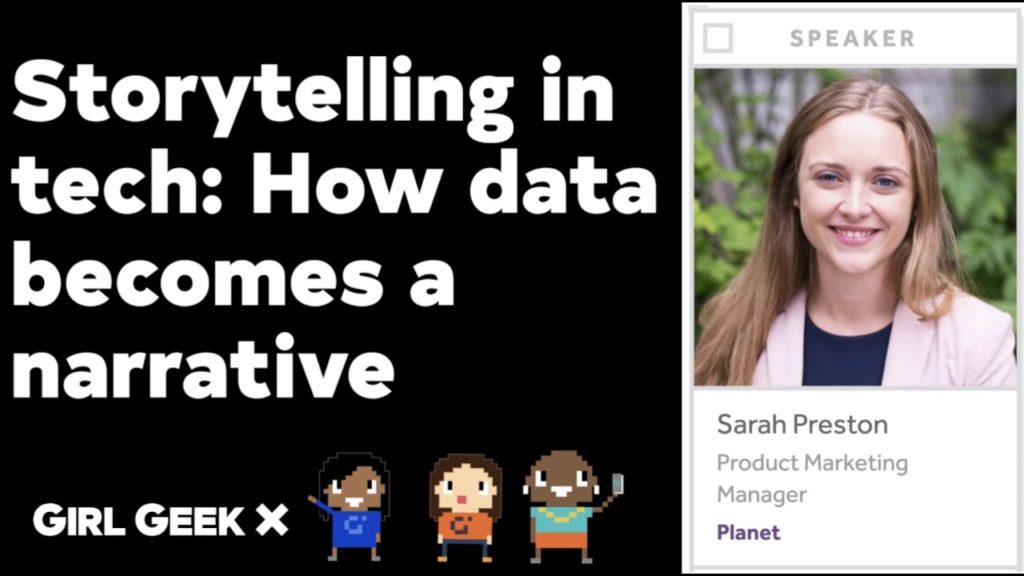
Sarah Preston: Okay, great. Thanks. Yeah, my name is Sarah Preston. I’m a product marketing manager at Planet. Now, a product marketing manager… Product marketing can mean a lot of different things in a lot of different organizations. But what I do is I work across our product and our marketing team and our sales teams to really find the right fit for our imagery and to understand what our prospects and what our audiences need out of imagery, even if they don’t know it yet. As you can imagine, narratives are extremely important part of what I do. So, I’m super excited to be here with you all to geek out about data-driven storytelling.
Sarah Preston: Okay. First, why do we tell stories in the first place? Stories are paths to community and understanding. Think about all the stories that you loved growing up. There was some kind of connection that you made, either to a character, to the author, or to the setting that drew you in and made it really memorable. You joined that community that was telling that story. And within that story, whether it’s fact or fiction, there was information, and you got to learn from others in that community and to build an understanding about the world around you.
Sarah Preston: What is a good story? So, “a good story is driven by emotion and balanced by fact.” That’s one of my favorite quotes, actually, that I heard. I can’t claim ownership of it, but, really, when we listen to a great story and we create a connection to a story, we’re really feeling some emotion and emotions can be extremely powerful motivators. I think, in or outside of the workplace even, an emotion can be excitement. It can be fear. It can be confusion. It can be ambition, but also a very human desire to understand the world around us. Emotions, they get us engaged in a story and interested. But facts and data, they keep us grounded.
Sarah Preston: As an example of how you might be able to see this, Planet took this image of Pripyat, Ukraine back in April. Now this was when Pripyat was experiencing massive wildfires and this was right outside of the Chernobyl exclusion zone that you can see in the center there. It was an extremely dangerous time, already a dangerous area. Radiation levels had spiked 16 times more than usual and Ukranian officials were telling the world, basically, that these fires had been controlled, extinguished. Clearly not the case. Now hearing this, when we talk about emotions, hearing this story in the news, you can’t help but feel a sense of fear, maybe helplessness and anxiety, and all these emotions that are driving, maybe not necessarily the international community, but driving officials to understand what is happening. How can we solve it? Well, Planet came in and we captured this image and this image has a lot of data in it to help move these decisions forward, to help these move and capture these emotions.
Sarah Preston: When we look at this image, we can see where the smoke is drifting. That tells us where the wildfire might be spreading to. We can see how far the wildfire has already spread on a grander scale. We can see how close it is to the Chernobyl exclusion zone. How radiation levels might continue to increase. And it tells us a lot about where we can deploy resources and where we can deploy flame retardant and, at the same time, keep all of our first responders safe. We had these emotions that we were feeling at the beginning, and a really good way to think about it is: Emotions, they move us forward. They encourage us to do something, but facts and data, they move us forward in the right direction. They give us an idea or an insight about where to go.
Sarah Preston: How do we craft great stories? Great stories is really about taking our audience or, on a business scale, our prospects, on a journey from ignorance to understanding. Now, there are not three key points to creating a great story. This could be an hour long seminar and I’ve been to them before. It’s such a fascinating subject, but, given the time we have, I narrowed it down to three points that I think are really important.
Sarah Preston: Know your audience. You want to understand what are their motivations? What are their expectations? Maybe what do they feel themselves on a daily basis? What’s their vocabulary? How do they communicate with each other and interact with the rest of the world? You want to really clarify the problem. Every story has its key conflict. You want to understand: what exactly is the conflict of the story you’re building and what is driving it, whether that is the emotions. And then you want to create some insight. What is the data showing us? This is the second half of the storytelling. How do we get past the conflict and use that data to create insight, to move us all forward?
Sarah Preston: And here is an example, also at Planet, of how we recently used those points to create a broader story. We started work with the New Mexico State Land Office and they were looking to monitor permitting activity in the Permian Basin. You can see that on the right side of the screen, the sample image. And there’s a lot of mining activity out there, but they just couldn’t see in the way they wanted to.
Sarah Preston: First, what we did here is we had to know your audience, right? We understood, and came to understand, how exactly the office itself functions, how it fits in with the broader civil government. What exactly is their legal mandate, who is our main point of contact and how to best really work with them in the first place. This is knowing how to communicate with them. Now once we know how to communicate with them, we can clarify the problem. Why is the office really experiencing this challenge? Why did they have very poor visibility into the more remote Permian Basin? Well, aerial photography like they’ve tried, was very slow and resource-intensive as was manned surveys. Sending people out there to actually see what’s going on, it was growing expensive. They were growing frustrated, really, that they didn’t really have a good way to monitor this land.
Sarah Preston: What Planet did was, now that we knew our audience, and we then clarified the problem, we were able to deliver the data to really create a good insight to solve their challenge. This is sample data, again, right here on the right of the screen. We deliver near-daily imagery to them so they can see change and what’s actually happening and activity. And once they see that activity, then they can deploy resources, whether that’s people or anything else to solve that issue.
Sarah Preston: Before I wrap up, I want to put another little plug. If you’re interested in learning more about storytelling at Planet, we actually have a customer conference coming up in October and we’re going to be featuring customers and partners talking about how they used our imagery for their own storytelling and how they’ve been able to build their own paths to understanding and building their own communities. The reason I want to feature this here is because it’s actually completely free this year and online, so very, very accessible. And before I completely close out, my last point, really, is: We are in a hugely data-driven world, and it’s really not so much about just collecting data anymore. It’s about collecting the right data and really understanding how to use it, how we get insights and go from that, go from that ignorance to that understanding to create solutions and to create great stories around our world. I don’t think I have time for questions, but that is my short brief. Again, this is a topic I could talk about at length, but hopefully you captured something out of this.
Angie Chang: Great. Thank you so much for that, Sarah, and we are now going to be bringing up Brittany, who is a natural disaster research scientist turned businesswoman.
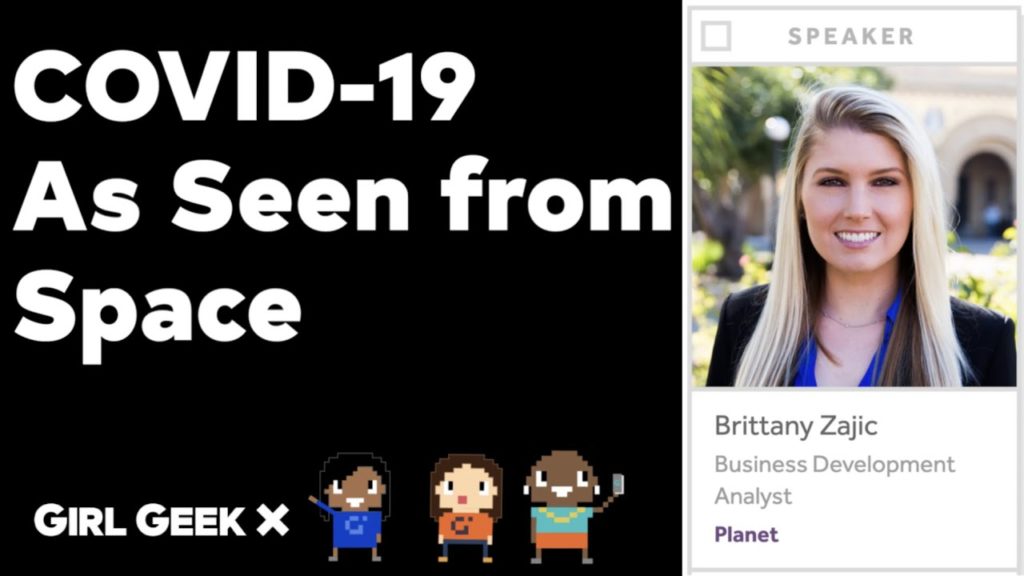
Brittany Zajic: Alright. Thanks, everyone. Hi everyone. Thanks for the opportunity to speak with you all tonight. My name is Brittany Zajic and I’m on the business development team here at Planet. Business development means something different at every company. And here, we focus on strategic partnerships and the commercialization of new markets. I also lead our disaster response operations, which is part of our social impact initiatives, where we provide satellite imagery to first responders and official stakeholders in the event of a large, natural disaster anywhere in the world. And, while not exactly a natural disaster, COVID-19 is very much a global public health crisis reshaping all of our behaviors and our environmental systems. So, today I’m going to talk about how satellite imagery is helping us better understand the impacts of this pandemic.
Brittany Zajic: By capturing a series of places in different points of time, satellite imagery is able to tell an important story. When millions of people began sheltering in place earlier this year, many looked to Planet, asking how we could help. So, how can satellite imagery help during a pandemic? Tonight I am going to showcase a few of the many applications surrounding the economic and environmental impacts of COVID-19.
Brittany Zajic: First, we head to Wuhan, China to see the start of their shelter-in-place. In these first two comparisons, we see a stark difference of traffic patterns and these images taken only two weeks apart, with not a single car in sight starting January 28. And I’ll go back one more time. I know this is quick. We then shift to expand further beyond just the limited car transportation, and, instead, think about the closures of factories, construction sites, and all other industrial activities that had a dramatic impact on the air quality in regions of, and parts of, China. Here is a comparison over a portion of Beijing from the start of the year on the left to March 2020 on the right. We then shift to Italy, the next epicenter of COVID-19. Many media outlets spoke of the now quiet canals and the cleaner waters running through the city, which was largely captured in these series of images here. I’ll run through these one more time. This is October 2019, March 2020, February 2020, and March 15th.
Brittany Zajic: Finally, we have the next epicenter that migrates to the United States, where it continues to remain today. New York was hit hardest and here we can see the construction of a temporary hospital in none other than Central Park, Manhattan, in the heart of New York. The rest of the United States followed suit soon after and shut down as well from the Bay Bridge Toll (that you take from going Oakland to downtown San Francisco) to the decrease in air travel (here’s a Southern California logistics airport — and just to highlight, we can see all the airplanes stacked up, not being in use), to the empty beaches (of Miami, Miami Beach, Florida) and then also the empty parking lots of Disneyworld in Orlando, Florida.
Brittany Zajic: So, it’s pretty incredible for satellites to be able to so clearly capture this pause on life that has been experienced, that we’ve all been experiencing these past couple of months. Now, there is no question that one data set has been able to tell a great story, but Planet imagery combined with multiple other data sets is going to be able to tell us even more. So I’m going to spend the remainder of this talk today, talking about EOdashboard.org, an international collaboration among space agencies that is central to the success of satellite Earth observation and data analysis.
Brittany Zajic: The tri-agency COVID-19 Dashboard is a concentrated effort between the European Space Agency, the Japanese Space Agency, and NASA. The Dashboard combines the resources, technical knowledge and expertise of these three partner organizations to strengthen our global understanding of the environmental and economic impacts of COVID-19. So, if we remember back to my early example in Venice, Italy, we visually saw the difference of boat traffic and water turbidity. Now, with EOS Dashboard, using information from several different satellites and sensor types, we’re able to turn that visualization into a quantitative assessment and observation, which is incredibly valuable when measuring environmental and economic indicators or factors.
Brittany Zajic: A second example of these quantitative metrics is the air quality in Beijing. Again, deriving these insights from an entire suite of different satellites, the ability to analyze these trends from space aids the effort to fight and defeat this pandemic. I leave you all with encouraging you to further explore this Dashboard and learn more about how COVID-19 is impacting people all over the world and explore it through the lens of satellite imagery, because together we can defeat this. Thank you.
Sukrutha Bhadouria: Hi, thank you so much. That was great. Next speaker is Nikki Hampton. Nikki is Planet’s VP of People and Talent, and she would like to share a few words on their commitment to diversity and inclusion. Welcome, Nikki.
Nikki Hampton: Thank you. I want to thank all the speakers, even though I know all of these women, I learned so much about them and the work they do and how they got to where they are. So, I’m pretty excited about that. I mostly wanted to say that at Planet, we have always been committed to diversity, but we are doubling down on our commitment and particularly so, looking with respect to attracting and retaining communities of color. And for all of you online, we are looking forward to and eager to work with you, to tap into a broader network of talented folks that you might want to consider referring to us or applying and sharing with whom you know, but we’re super excited to have been part of this and are grateful that you all attended.
Angie Chang: Thank you so much for that, Nikki. Now we’re going to just move into the Q&A. If there are a few questions, I think we have literally like five minutes till 8:00 PM when we kick off networking. So, if you have any questions, please ask them in the Q&A section and we will be sharing them with Planet and you’ll be getting a follow-up email with job links. They are hiring for some positions like senior corporate counsel, systems engineer, software engineer, account executives. So, you can be like Elena. Sales development reps, customer success managers, and more, and the job links are usually in our Girl Geek X Planet emails that you’re receiving. So, just scroll down and click on those links or forward it to a friend who is looking for a new role.
Angie Chang: We will be heading over to our networking hour at 8:00 PM. It is on a platform called icebreaker.video and you will have the link in your email, if you look in your email, or we can put it in this chat and we’ll be doing some facilitated one-on-one networking where you literally meet one-on-one with people in a non-Zoom environment. It’s going to be a little more fun and you actually get to talk to people and see their faces. So, if you can hop-
Sukrutha Bhadouria: And I wanted to call out, thank you so much to everybody speaking and thanks to everybody who has been commenting. I definitely see that it has been super valuable for you all. I wanted to mention, because I’ve also been getting asked, how you can get your company to partner with us to do a virtual Girl Geek Dinner. Definitely reach out to us, through the website, sponsor@girlgeek.io — that’s our email — and if you want to reach out individually to Angie or I, our emails are listed on the website as well. The other thing I wanted to say is, if you do get your company to sponsor, you must sign up to be one of the speakers, own it, use the stage that you are creating for everyone else to promote yourself as well. So, that’s all I had.
Angie Chang: Great. So thank you all for being so good at the chat, and we’ll see you over at icebreaker.video so we can chat one-on-one with everyone. Thank you all and we’ll see you there. We’re going to keep this on so people can see the link and click on it — and hopefully we’ll rejoin and see you over there in a minute. Alright, bye.


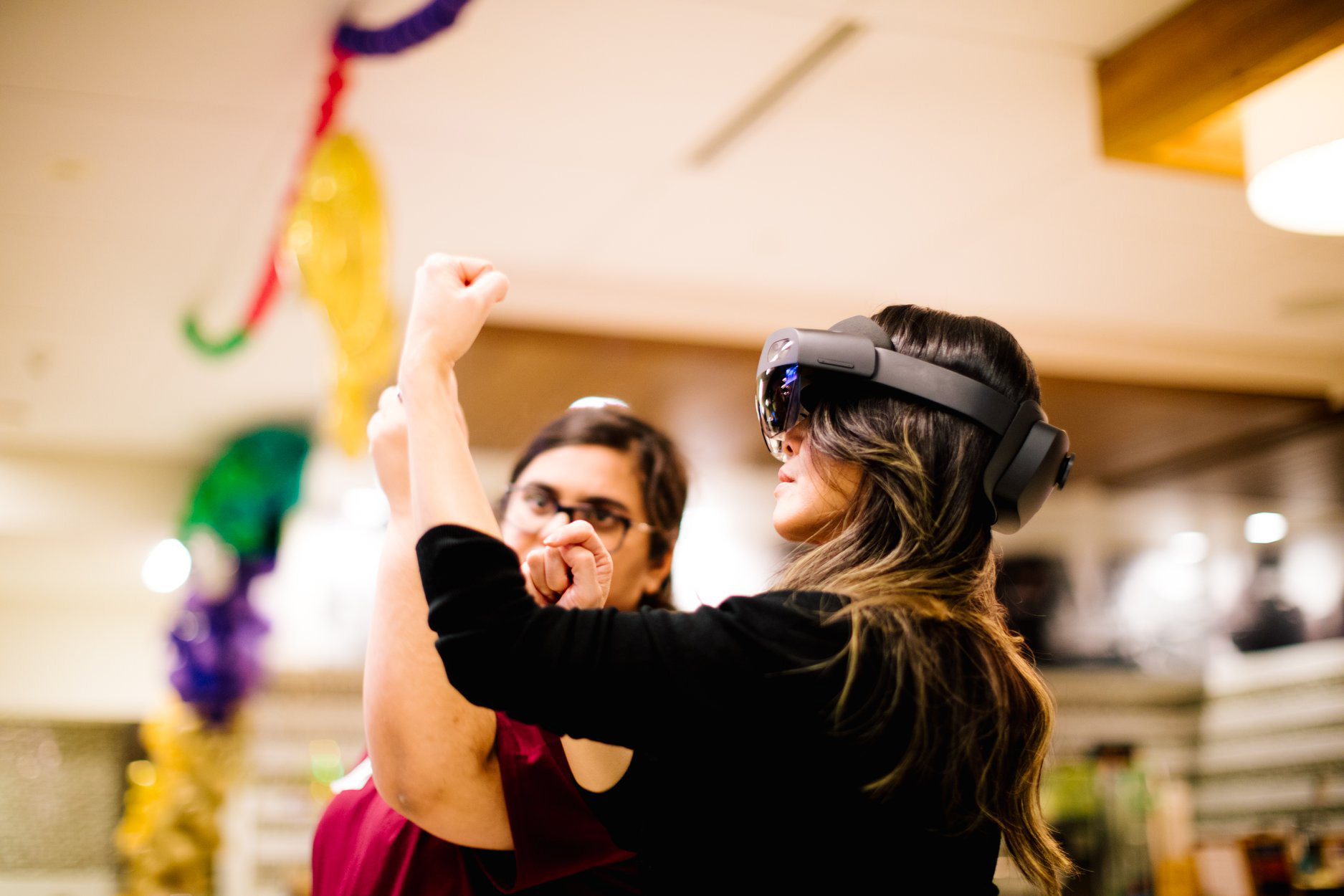 We enjoyed dinner and demos of HoloLens at the sold-out Microsoft Hardware Girl Geek Dinner in Sunnyvale, California. Erica Kawamoto Hsu / Girl Geek X
We enjoyed dinner and demos of HoloLens at the sold-out Microsoft Hardware Girl Geek Dinner in Sunnyvale, California. Erica Kawamoto Hsu / Girl Geek X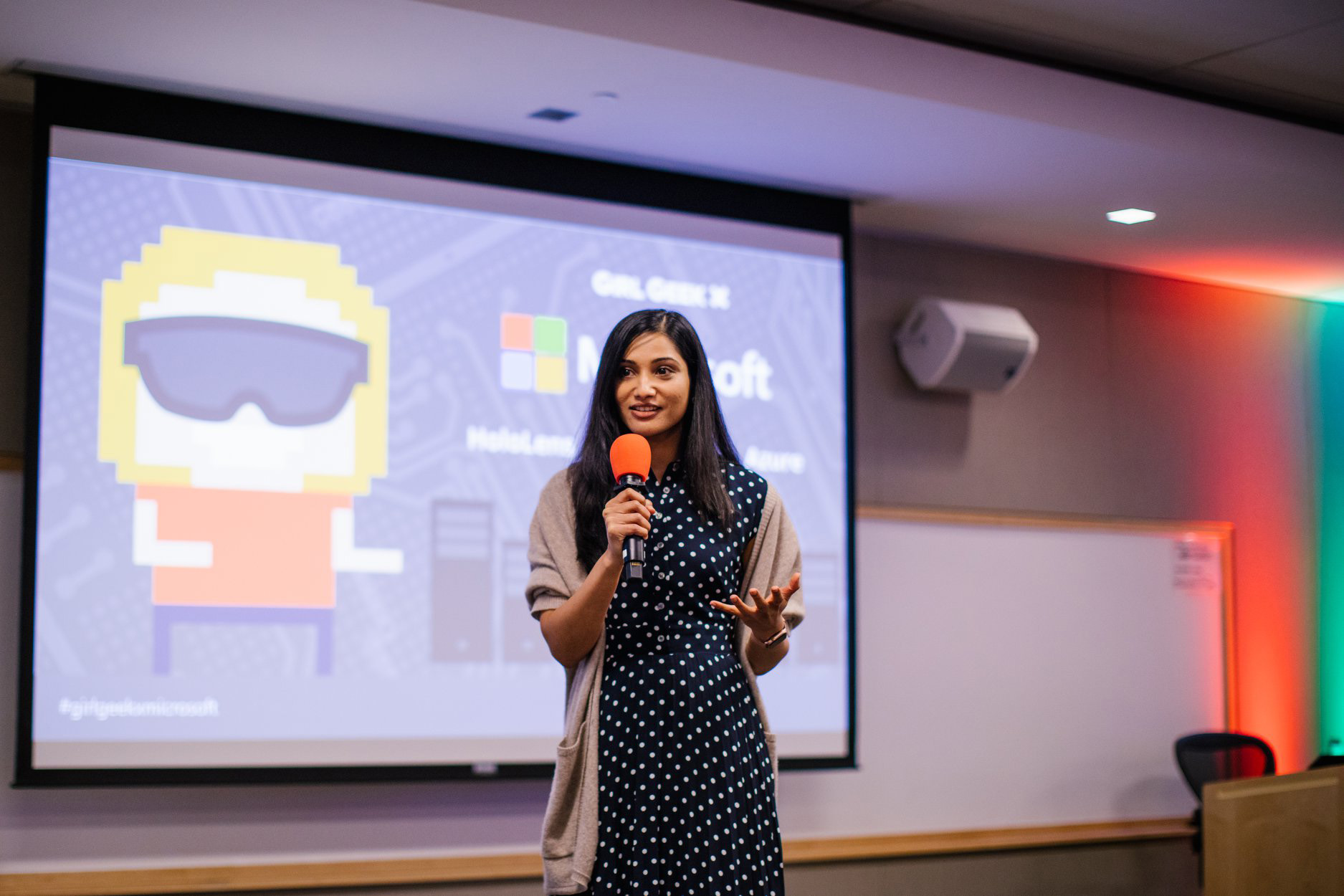 Microsoft Group Engineering Manager Aaratee Rao welcomes the audience and talks about her career at Microsoft Hardware Girl Geek Dinner. Erica Kawamoto Hsu / Girl Geek X
Microsoft Group Engineering Manager Aaratee Rao welcomes the audience and talks about her career at Microsoft Hardware Girl Geek Dinner. Erica Kawamoto Hsu / Girl Geek X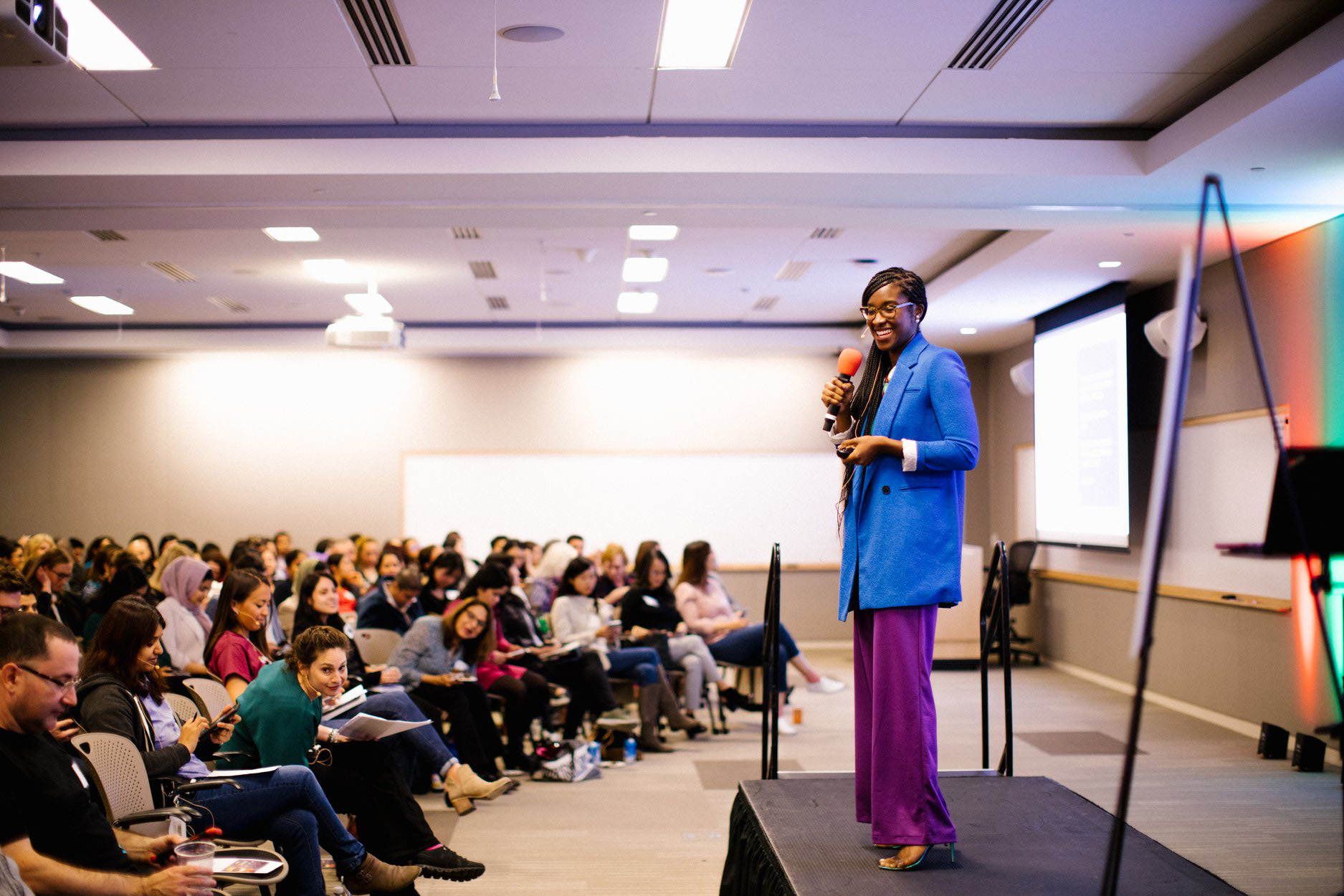 Microsoft Strategic Account Executive Safiya Miller gives a talk on what to do in the first 90 days of a new job at Microsoft Hardware Girl Geek Dinner. Erica Kawamoto Hsu / Girl Geek X
Microsoft Strategic Account Executive Safiya Miller gives a talk on what to do in the first 90 days of a new job at Microsoft Hardware Girl Geek Dinner. Erica Kawamoto Hsu / Girl Geek X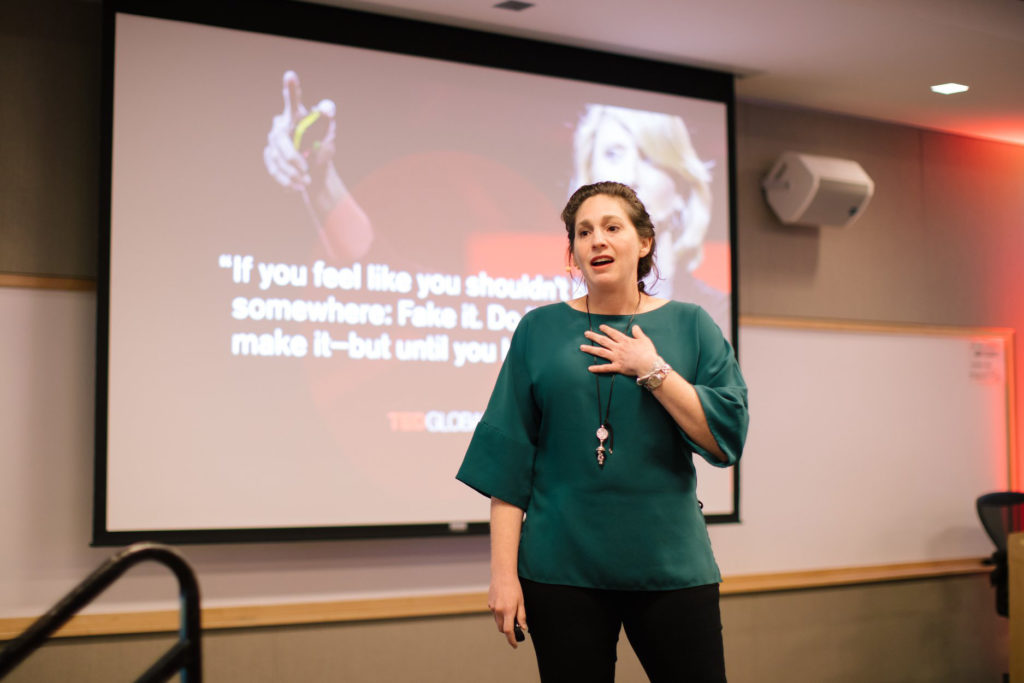
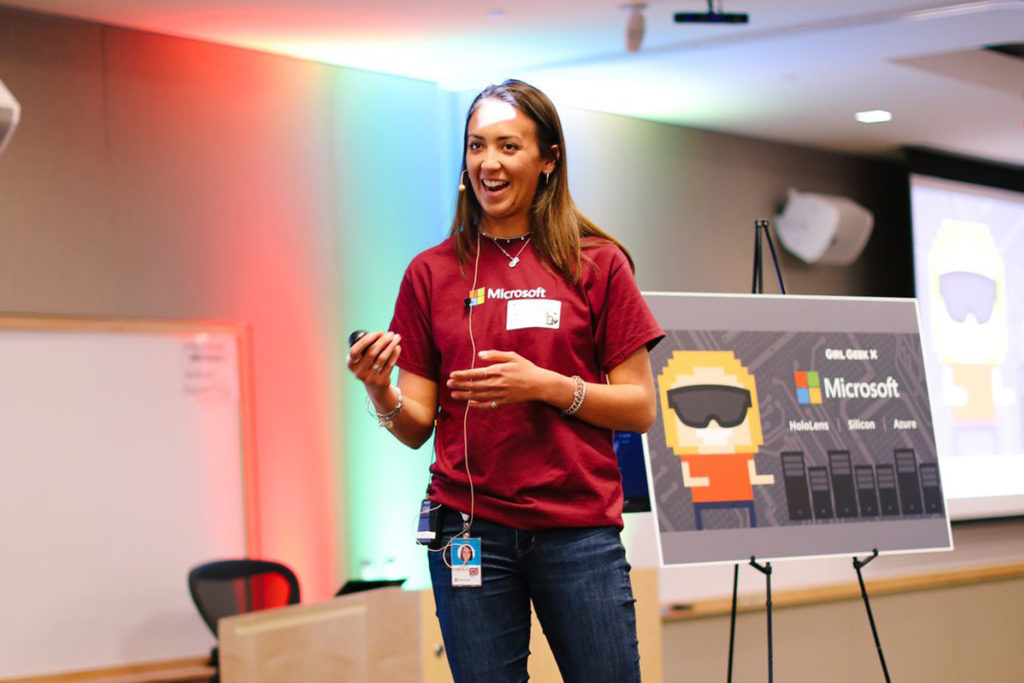 Microsoft Mechanical Engineer Carolyn Lee gives a talk on HoloLens at Microsoft Hardware Girl Geek Dinner. Erica Kawamoto Hsu / Girl Geek X
Microsoft Mechanical Engineer Carolyn Lee gives a talk on HoloLens at Microsoft Hardware Girl Geek Dinner. Erica Kawamoto Hsu / Girl Geek X